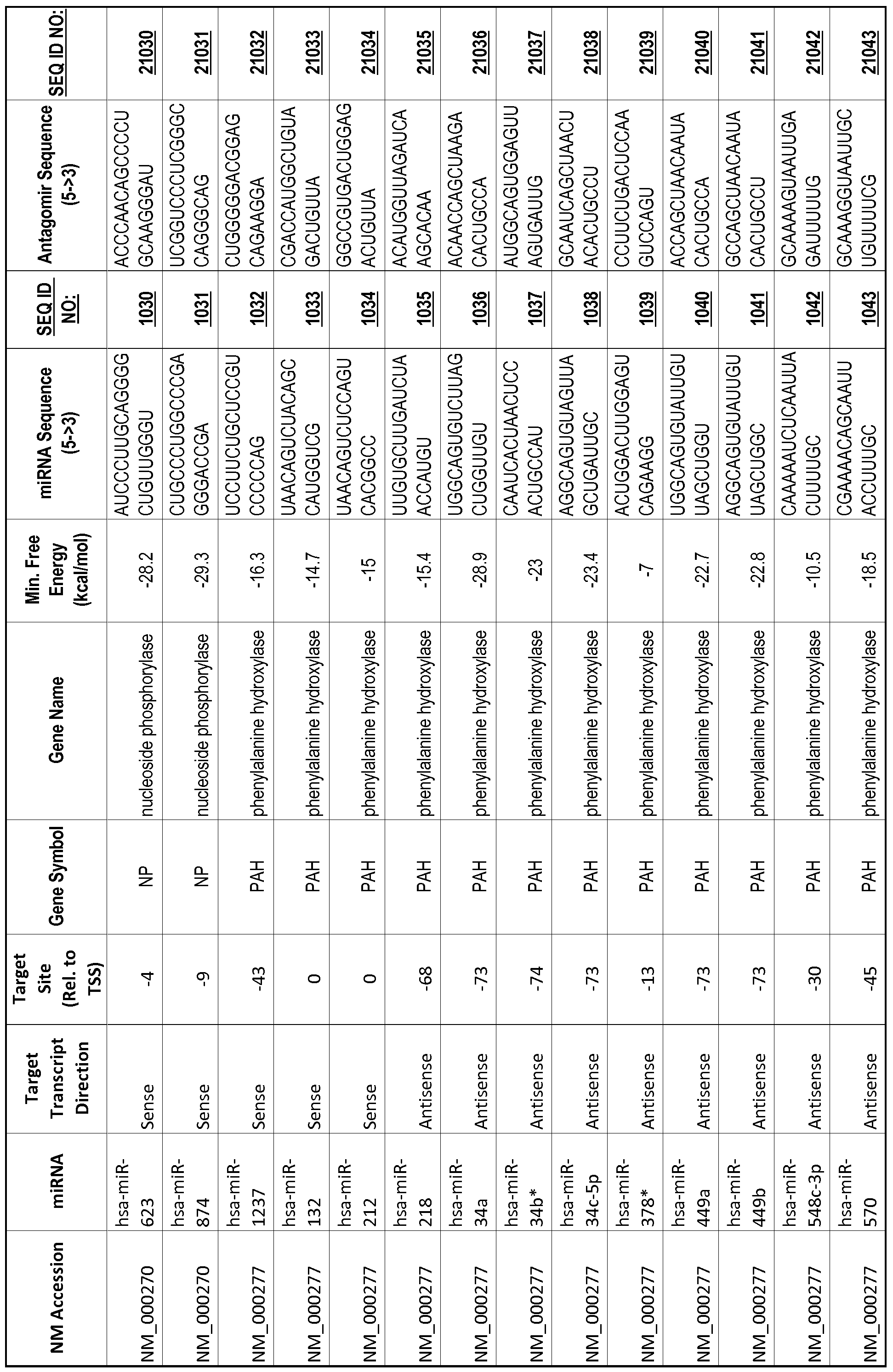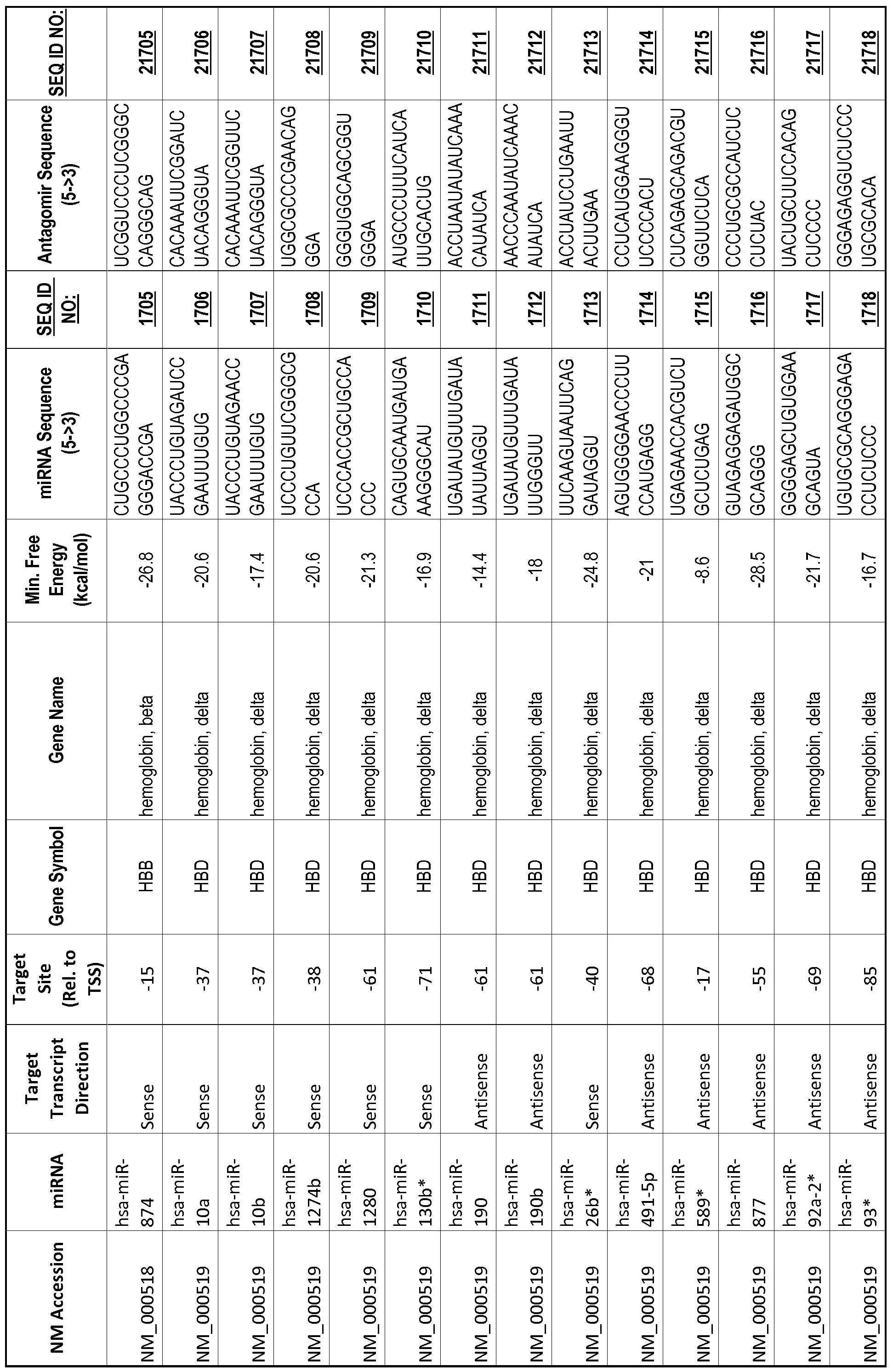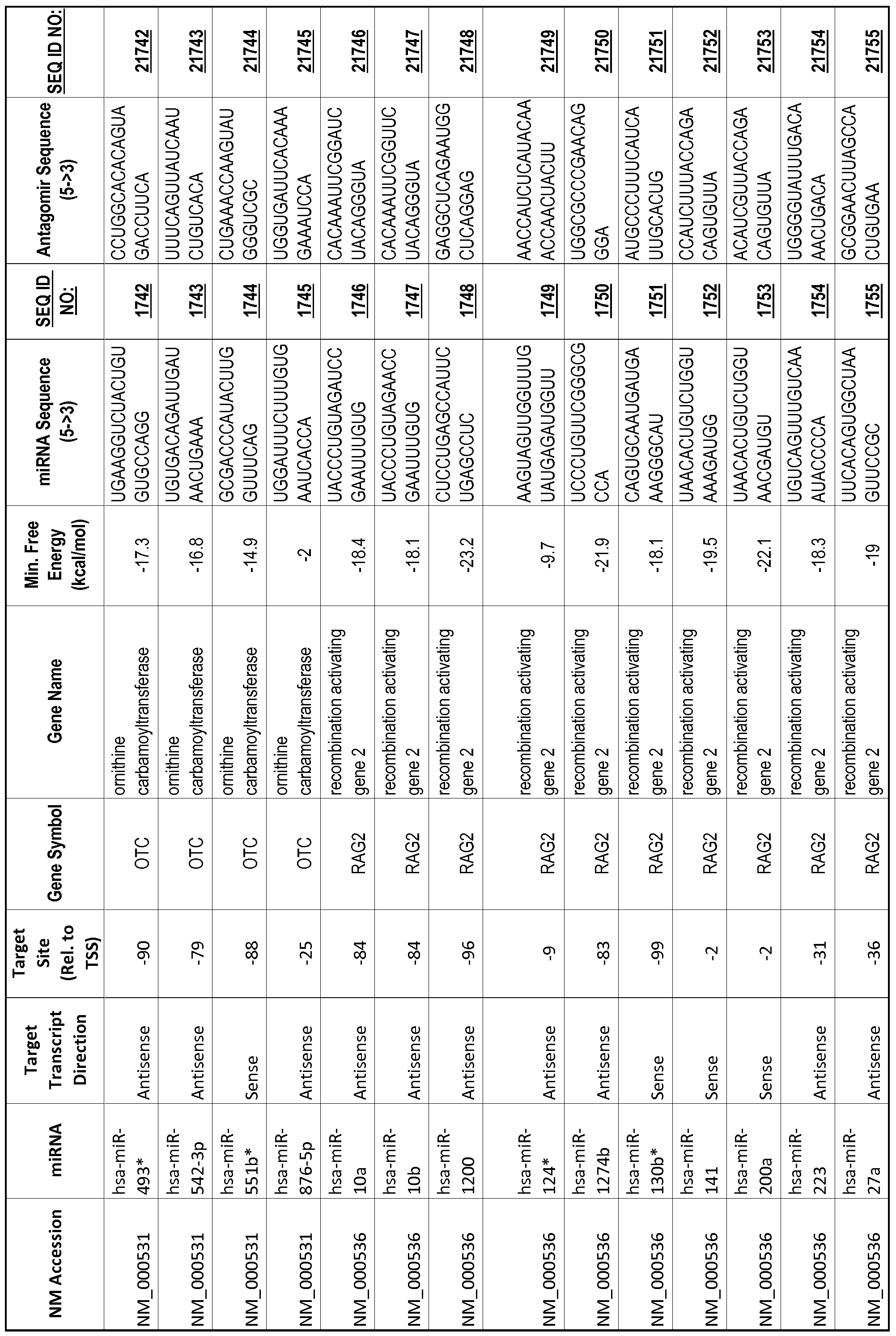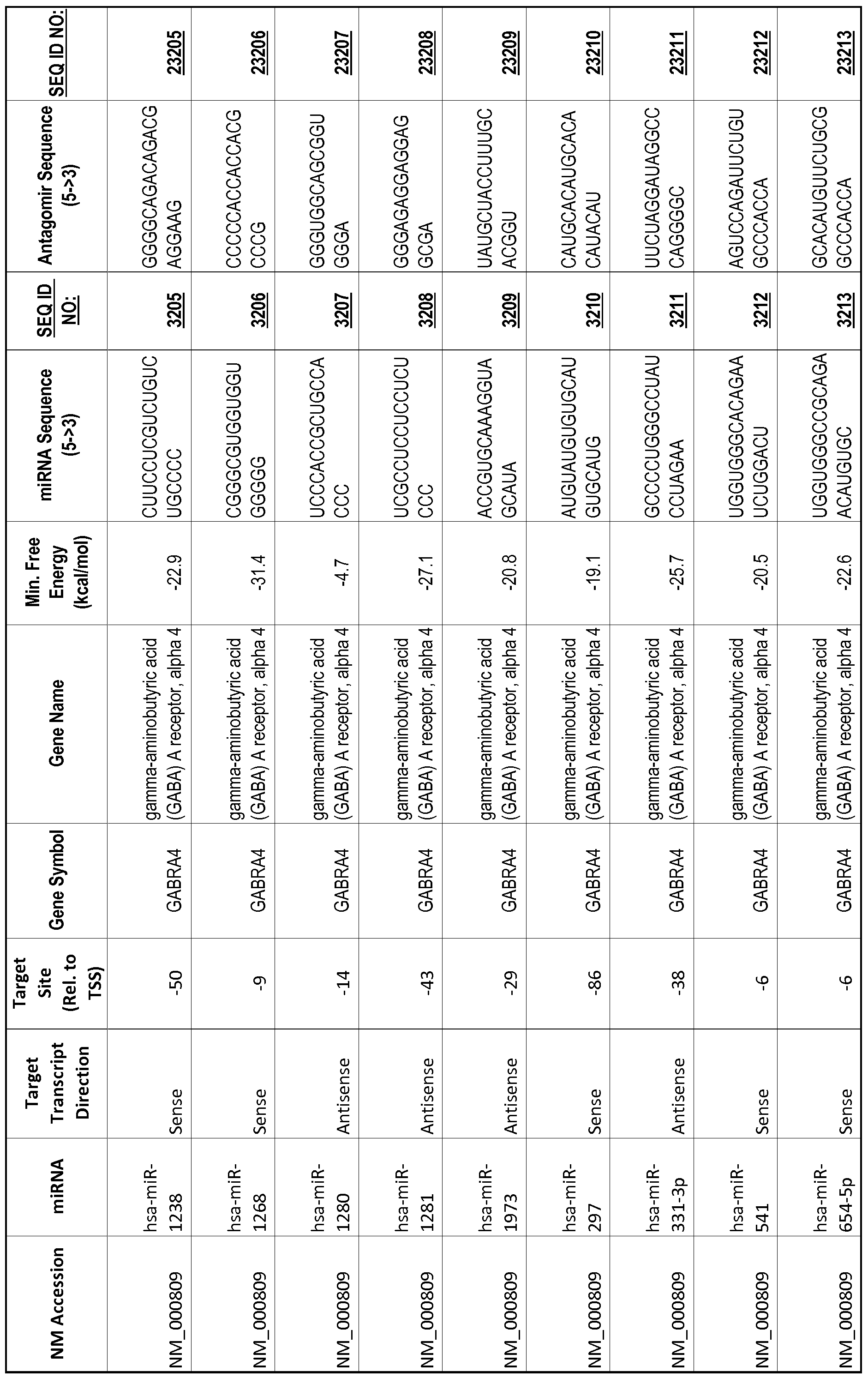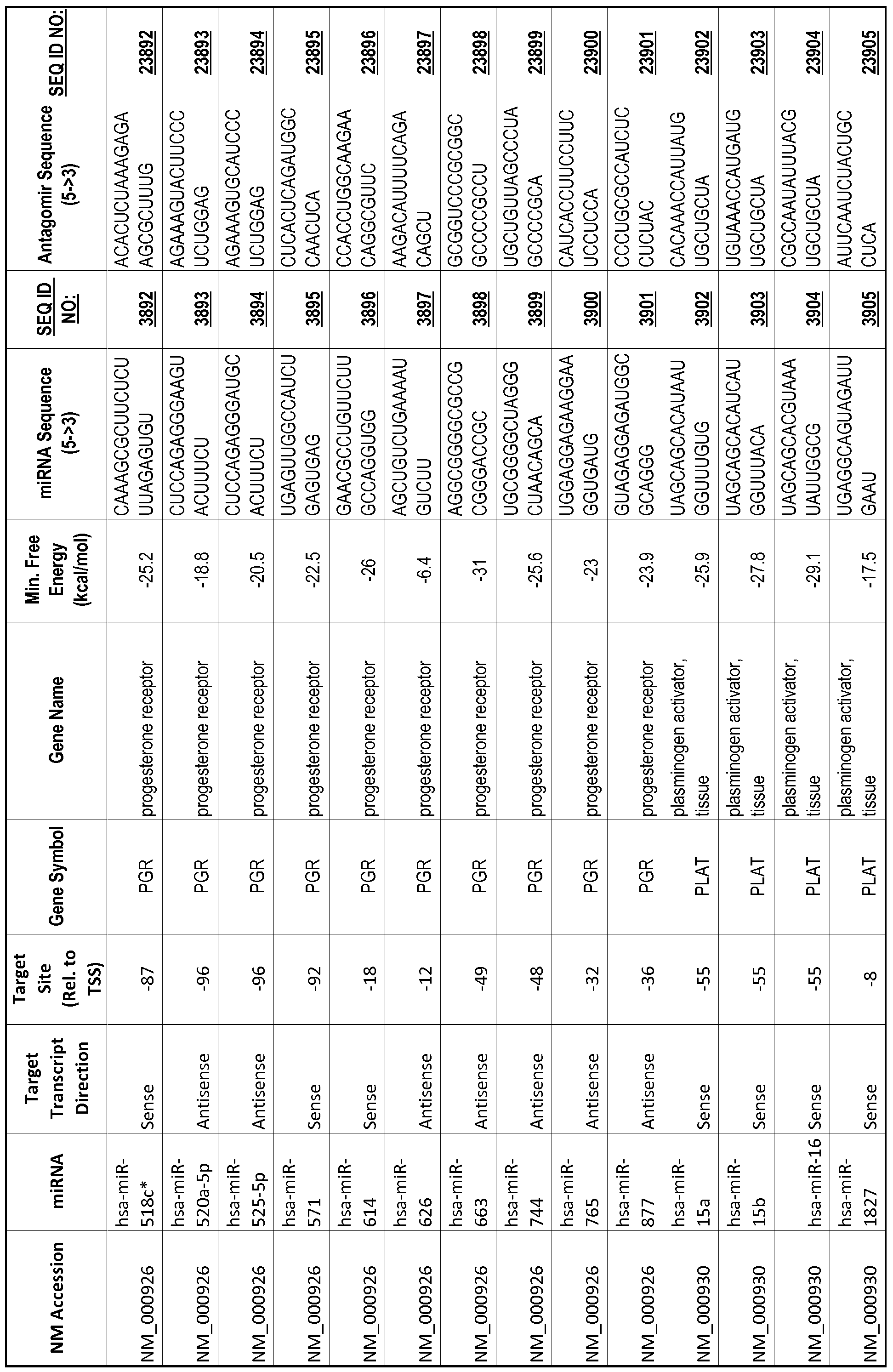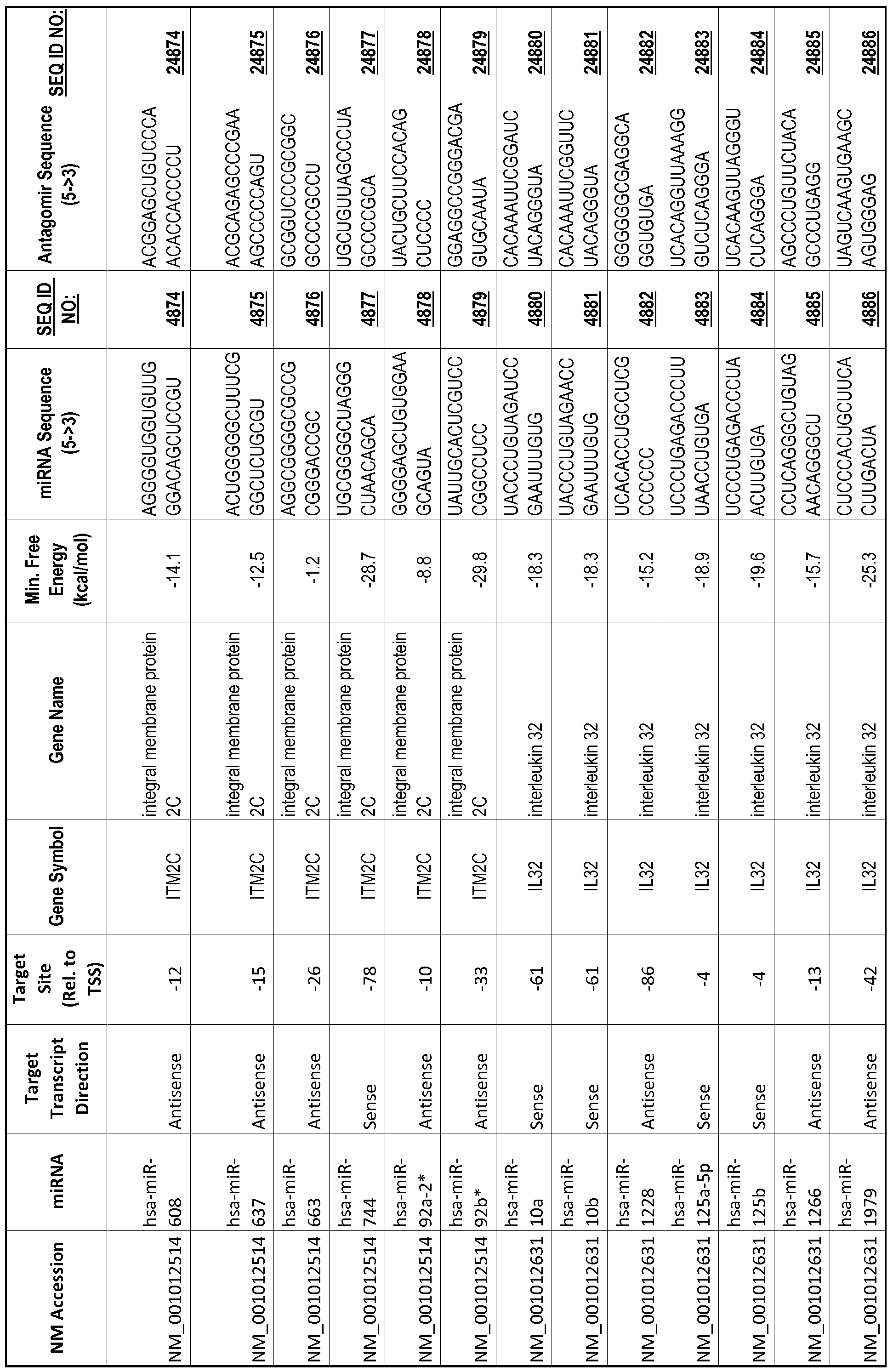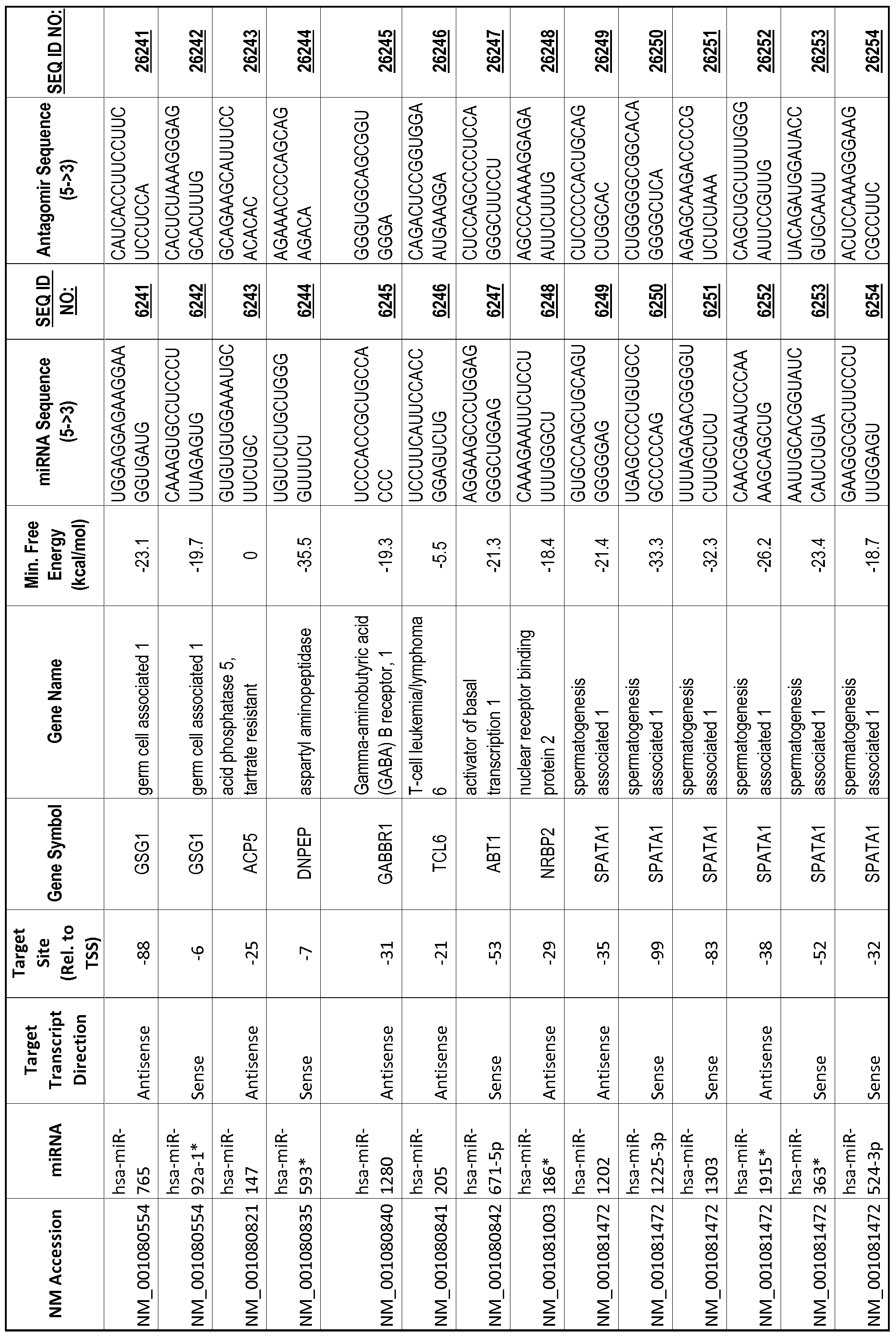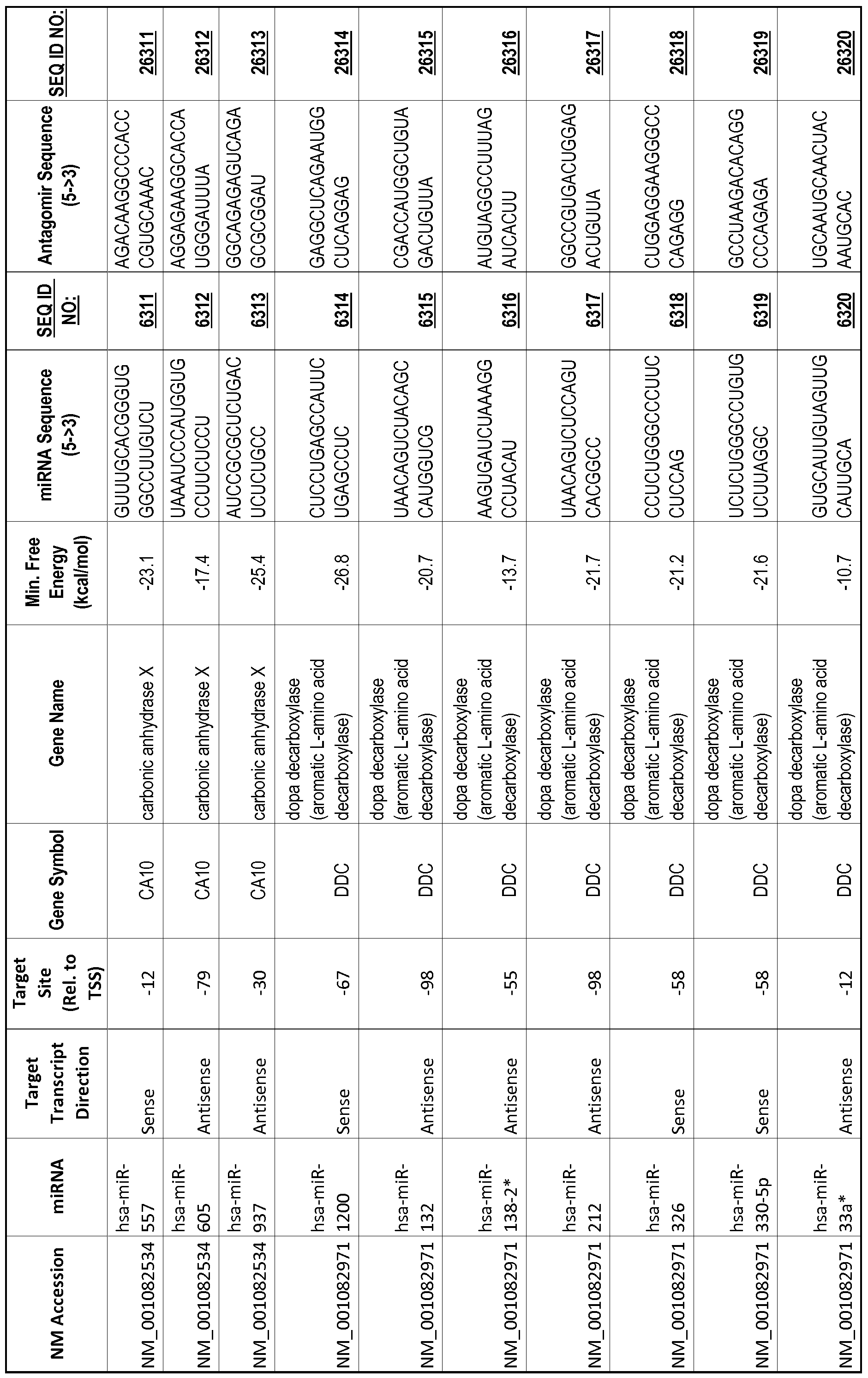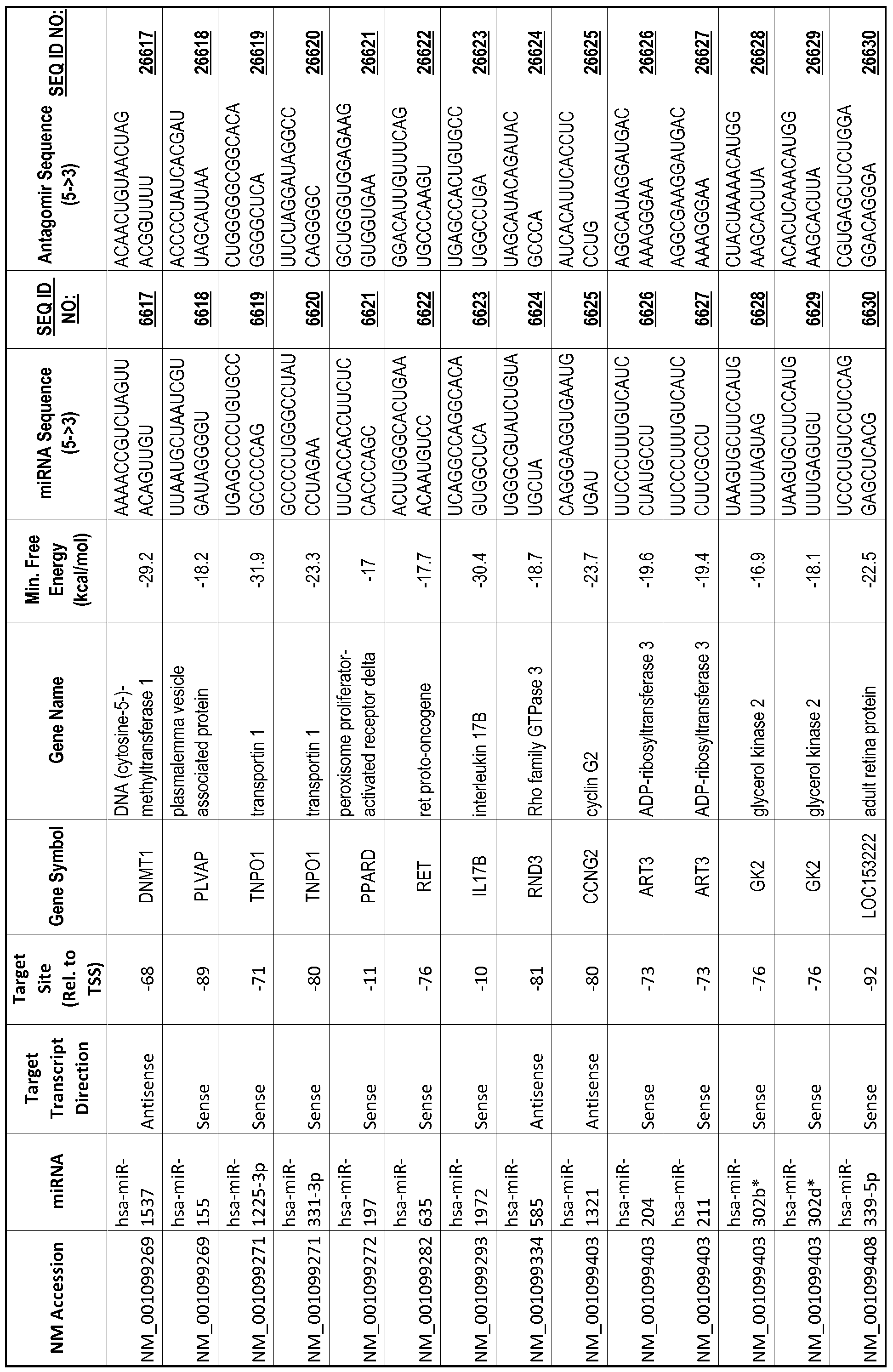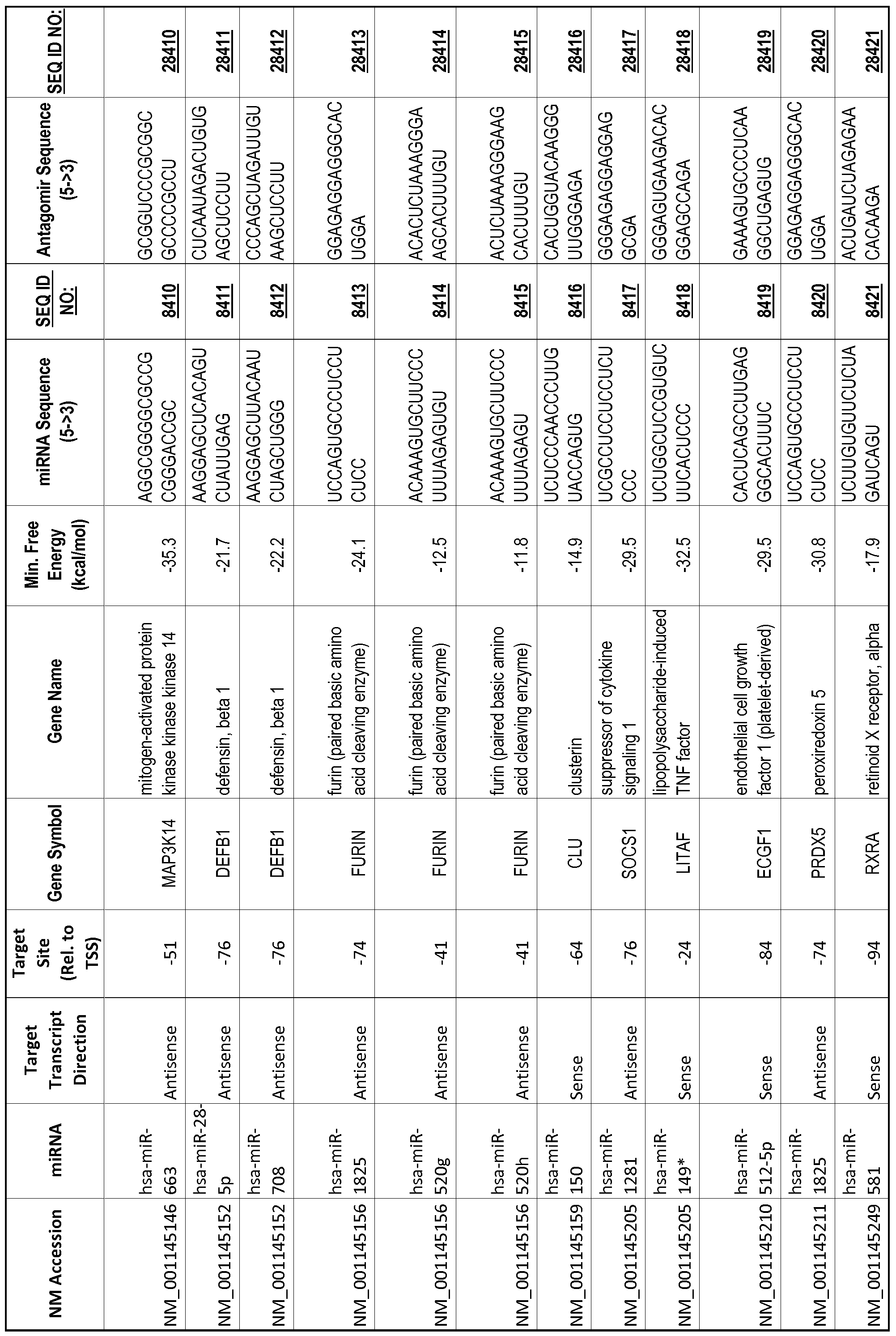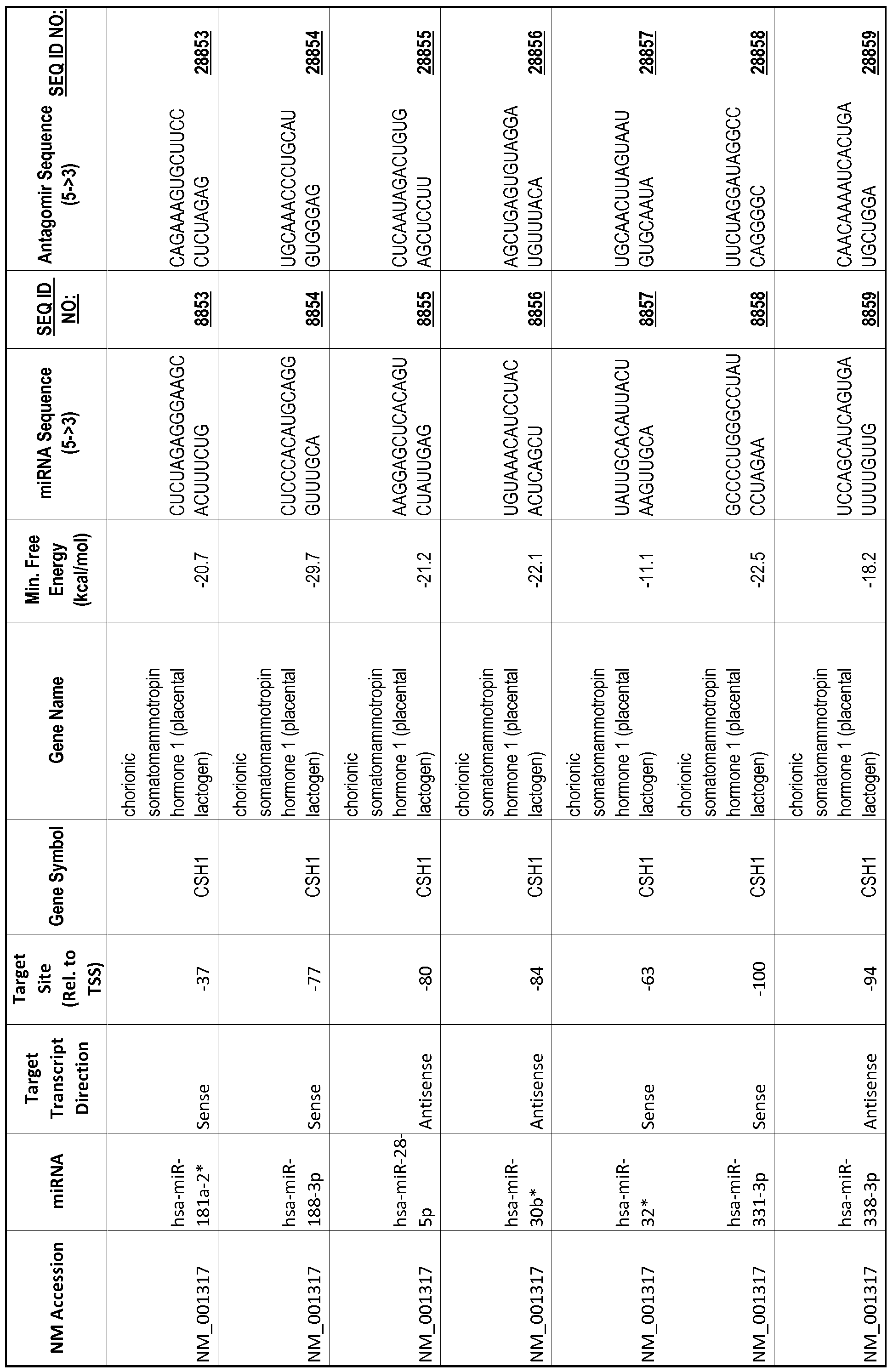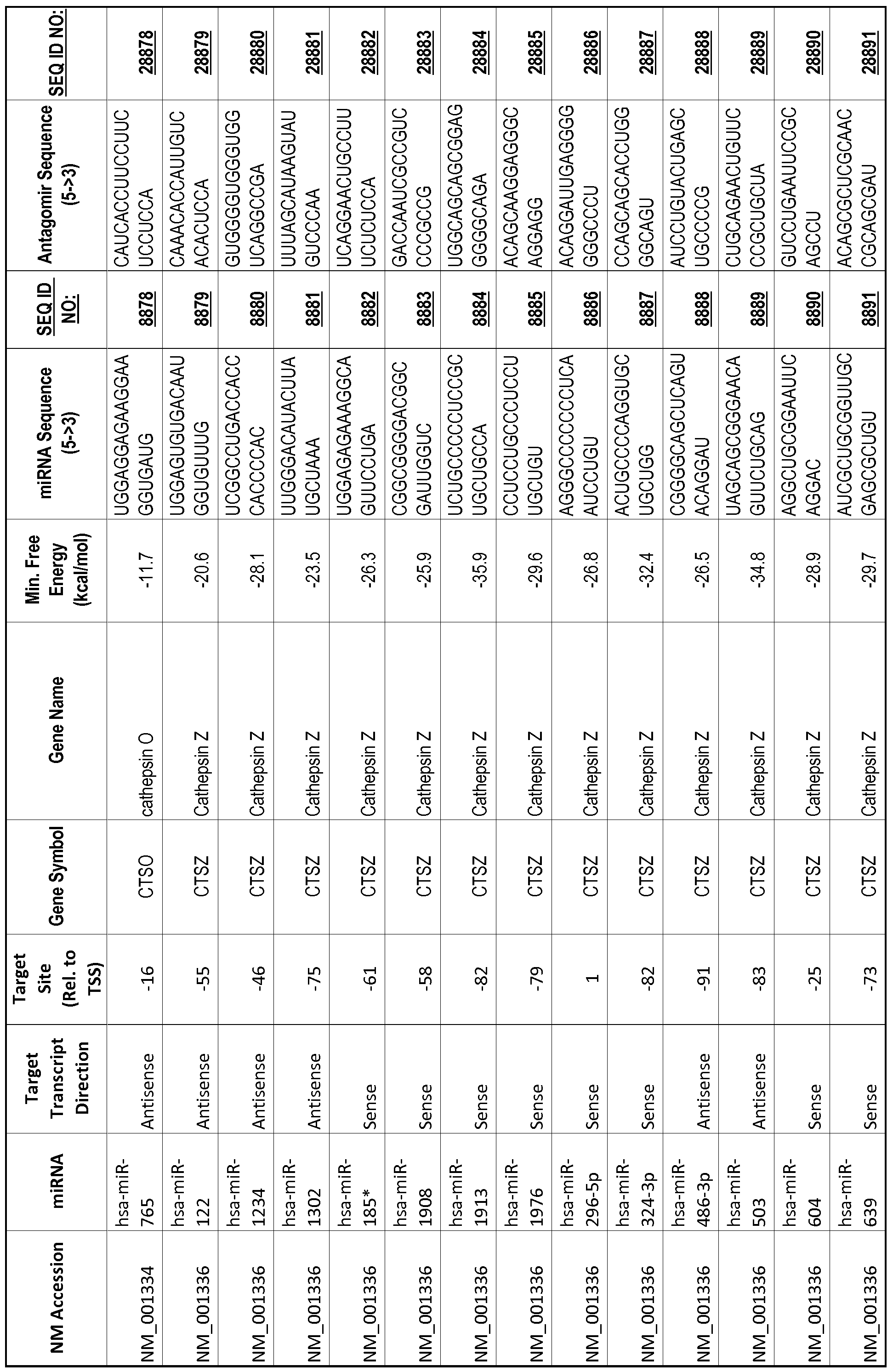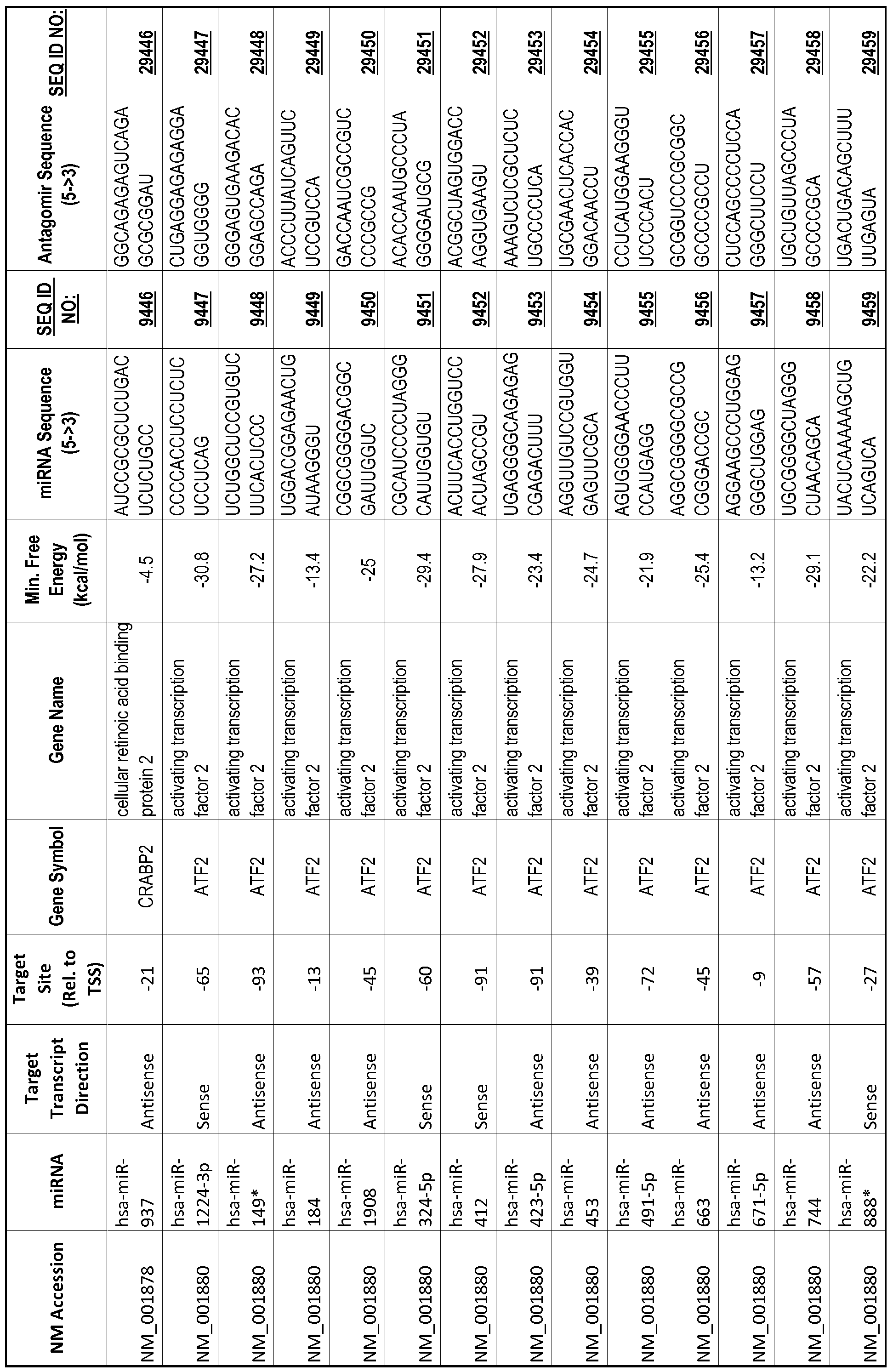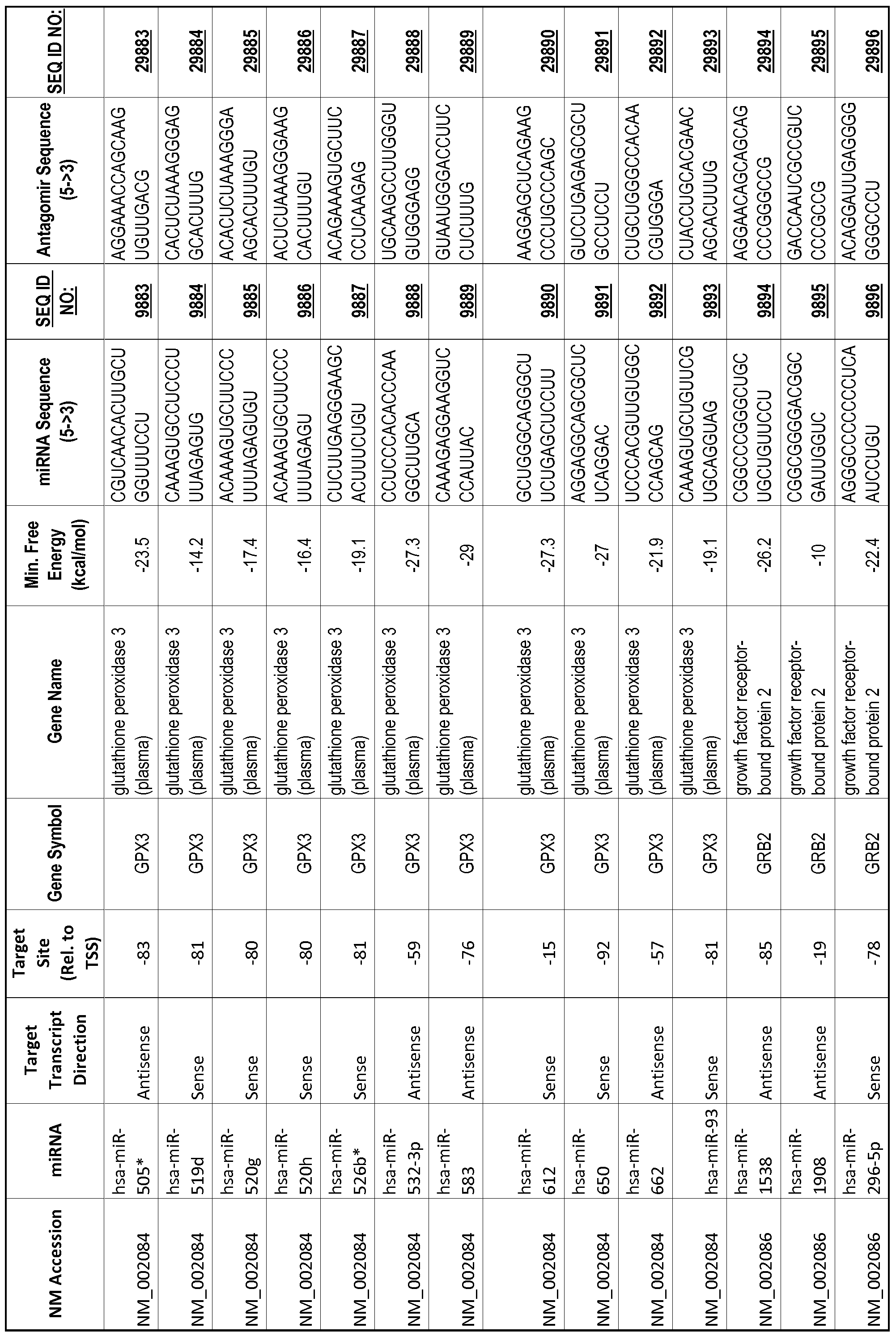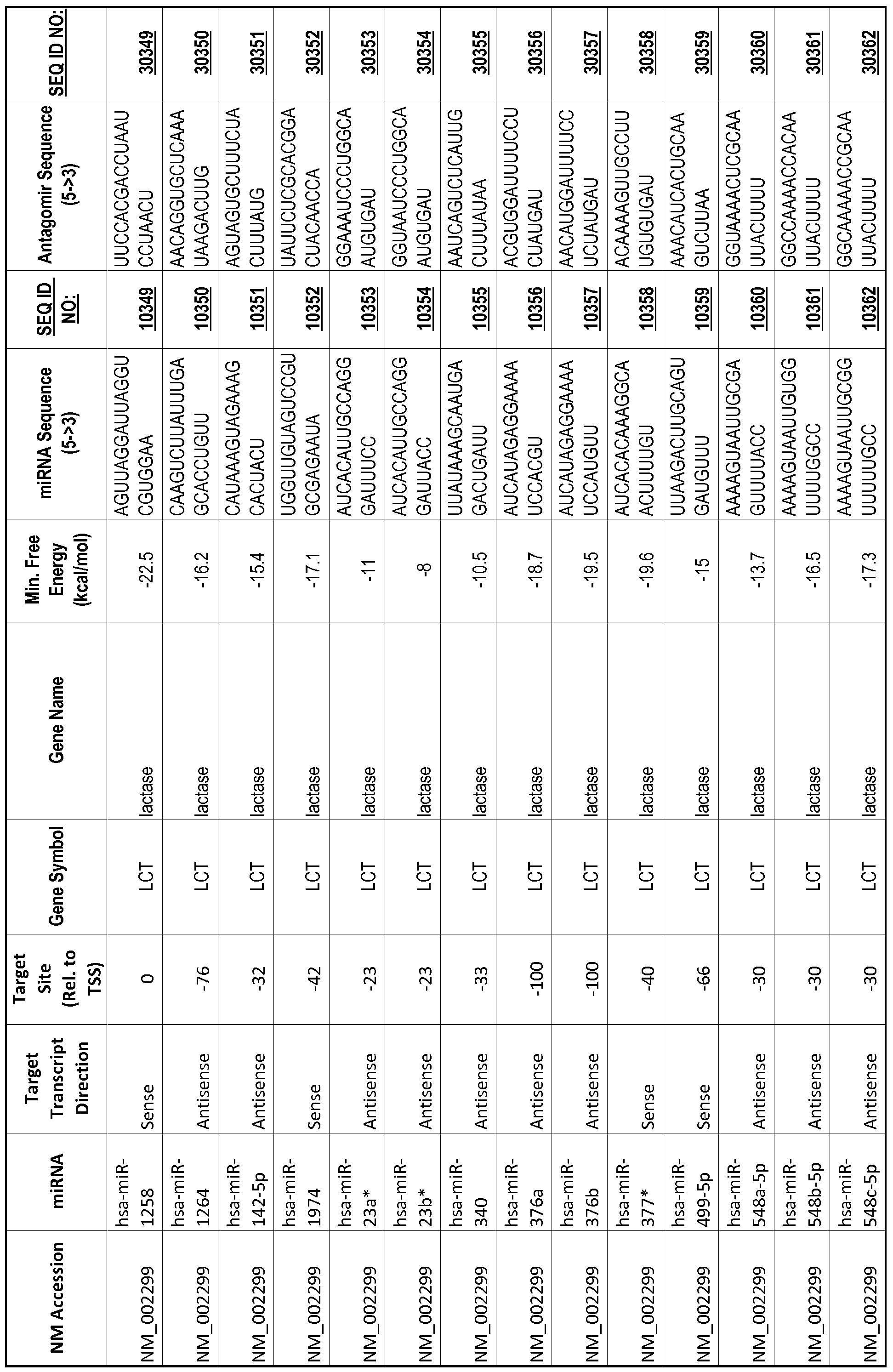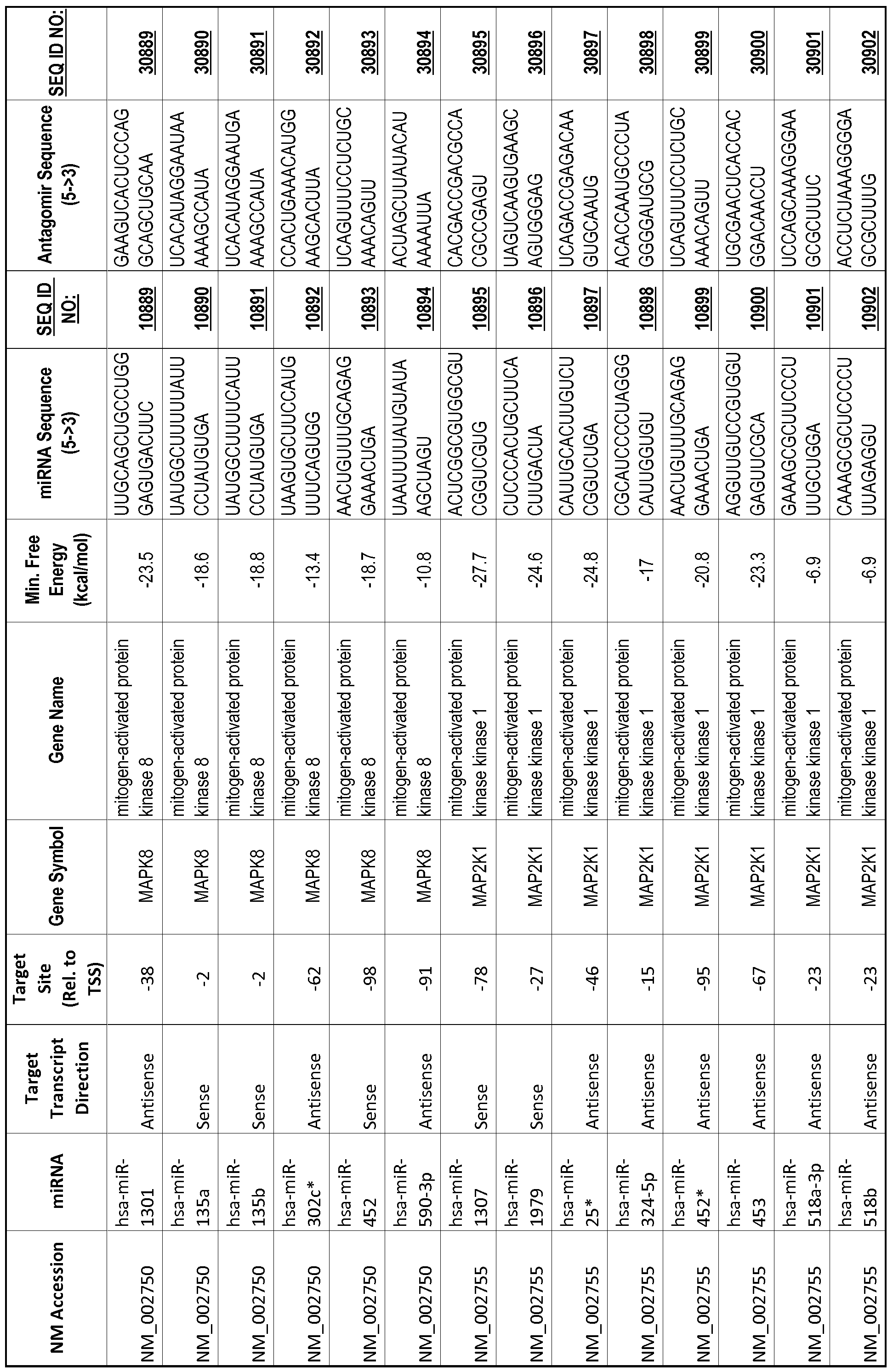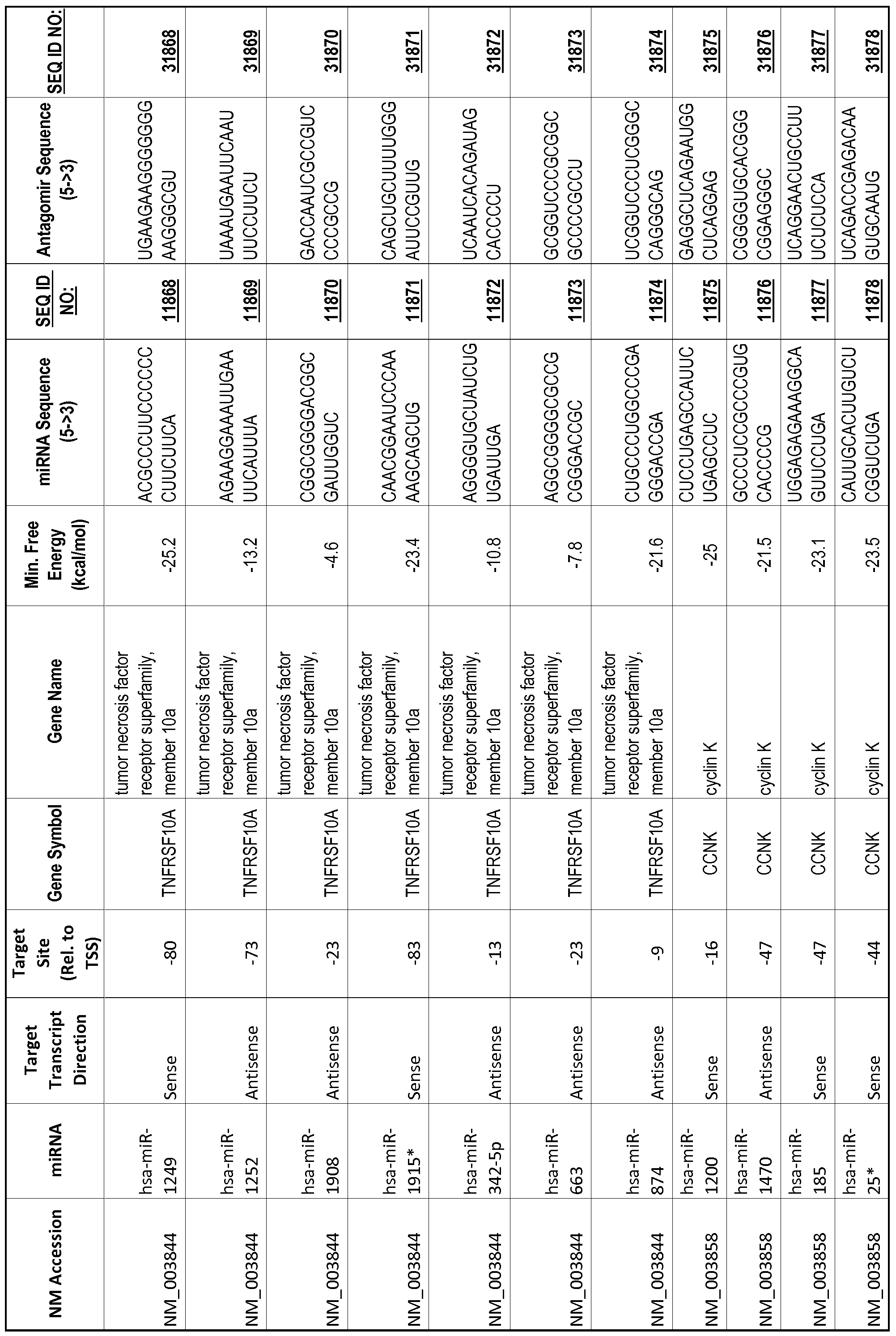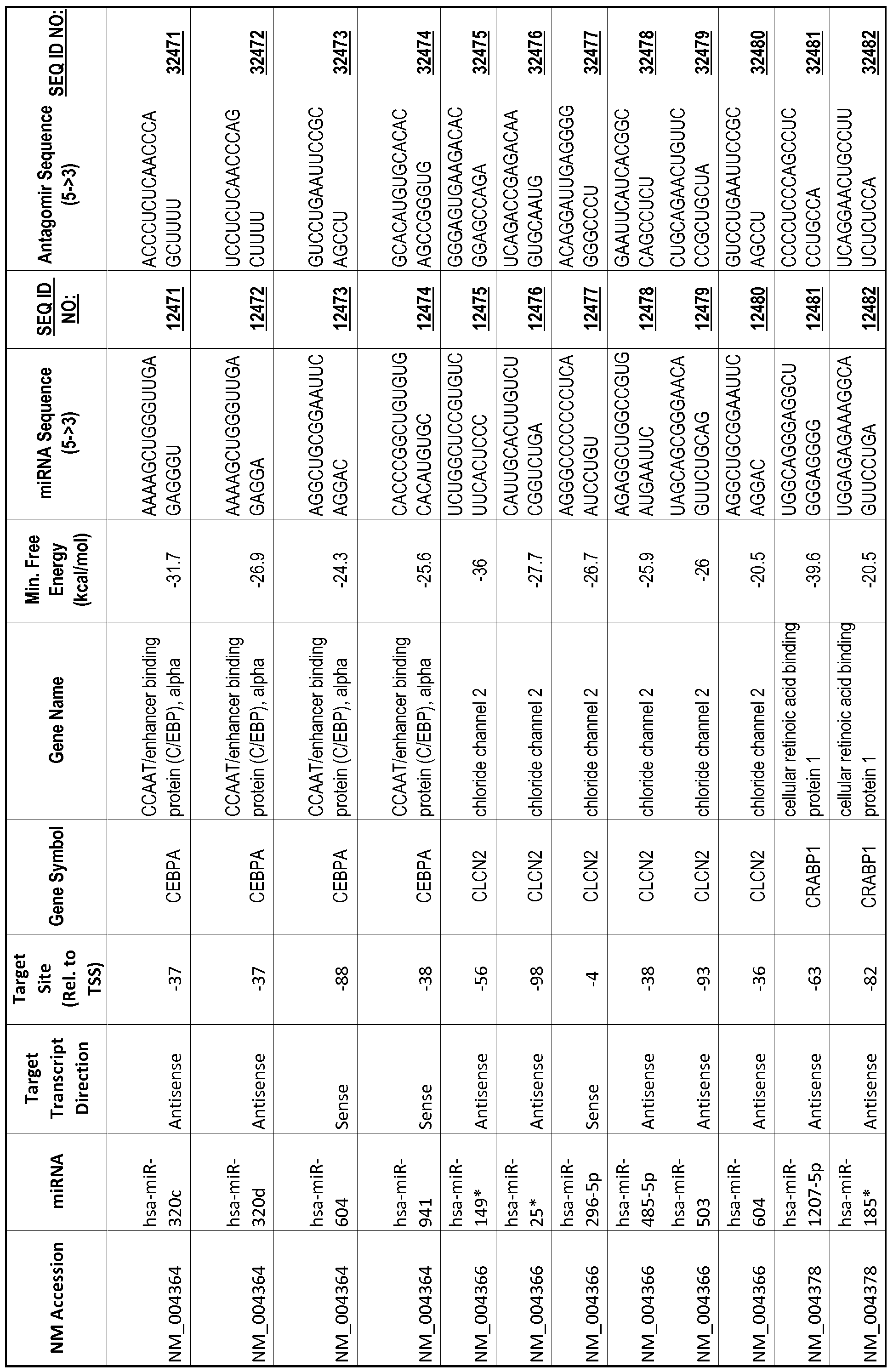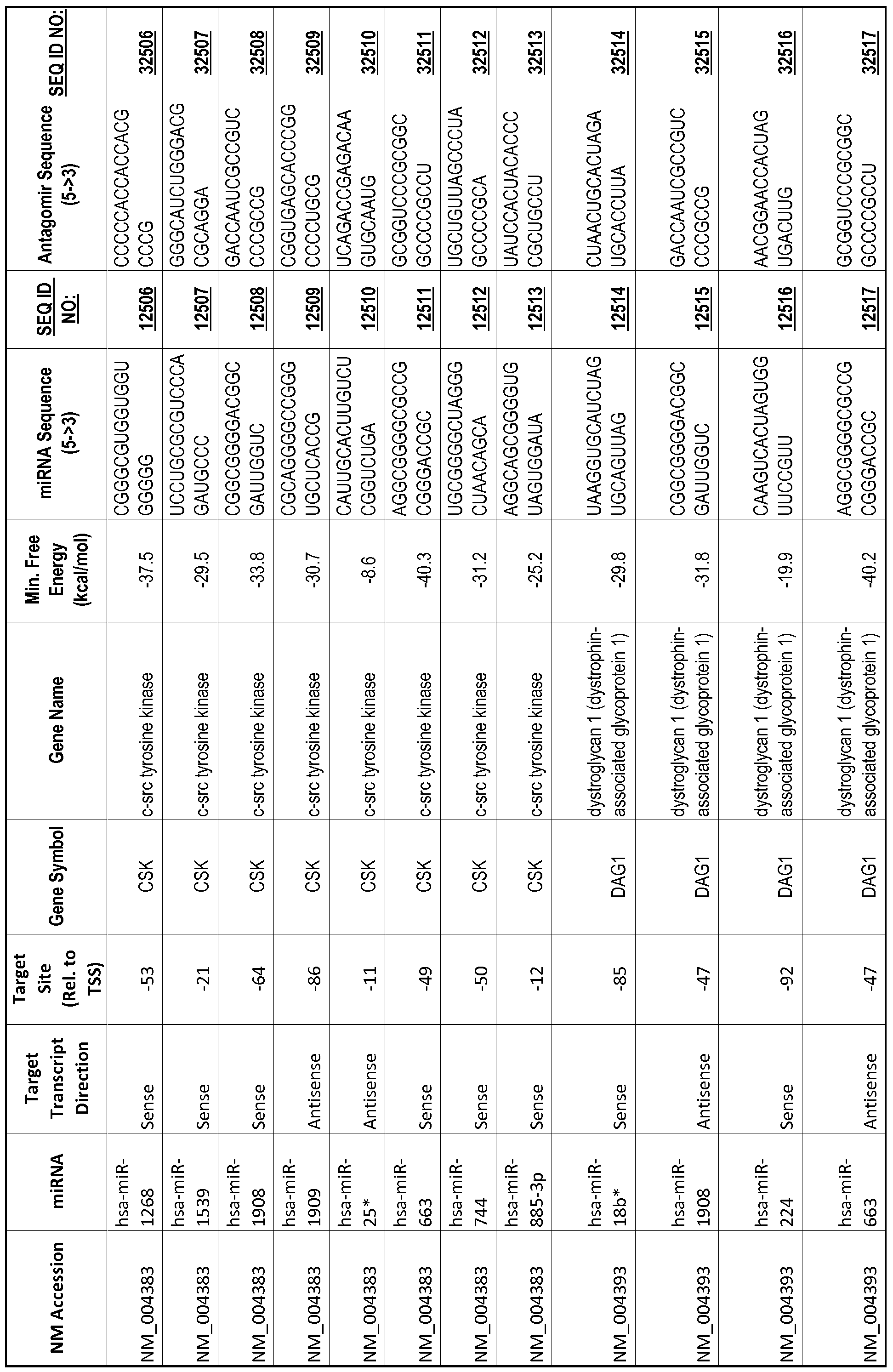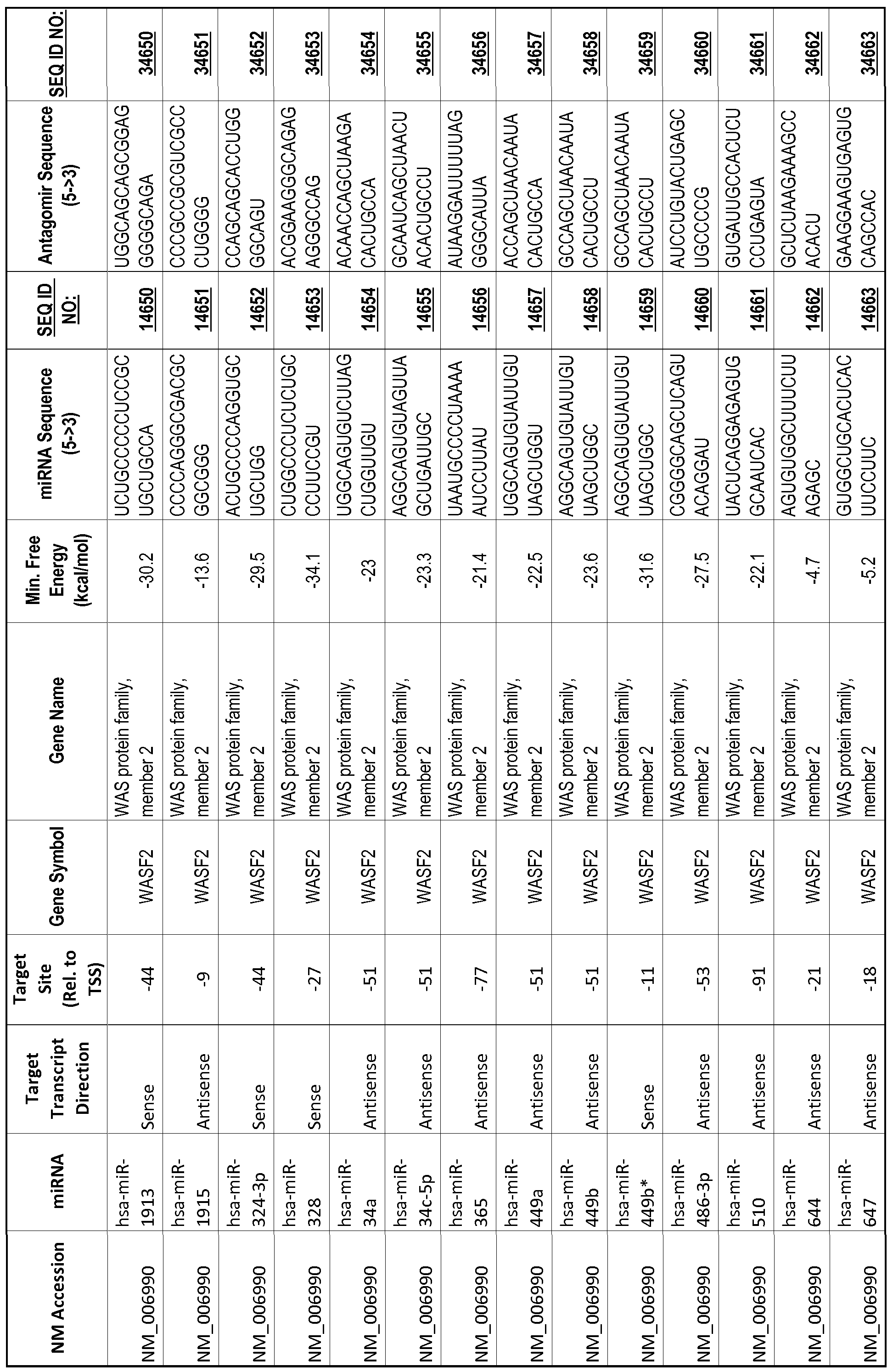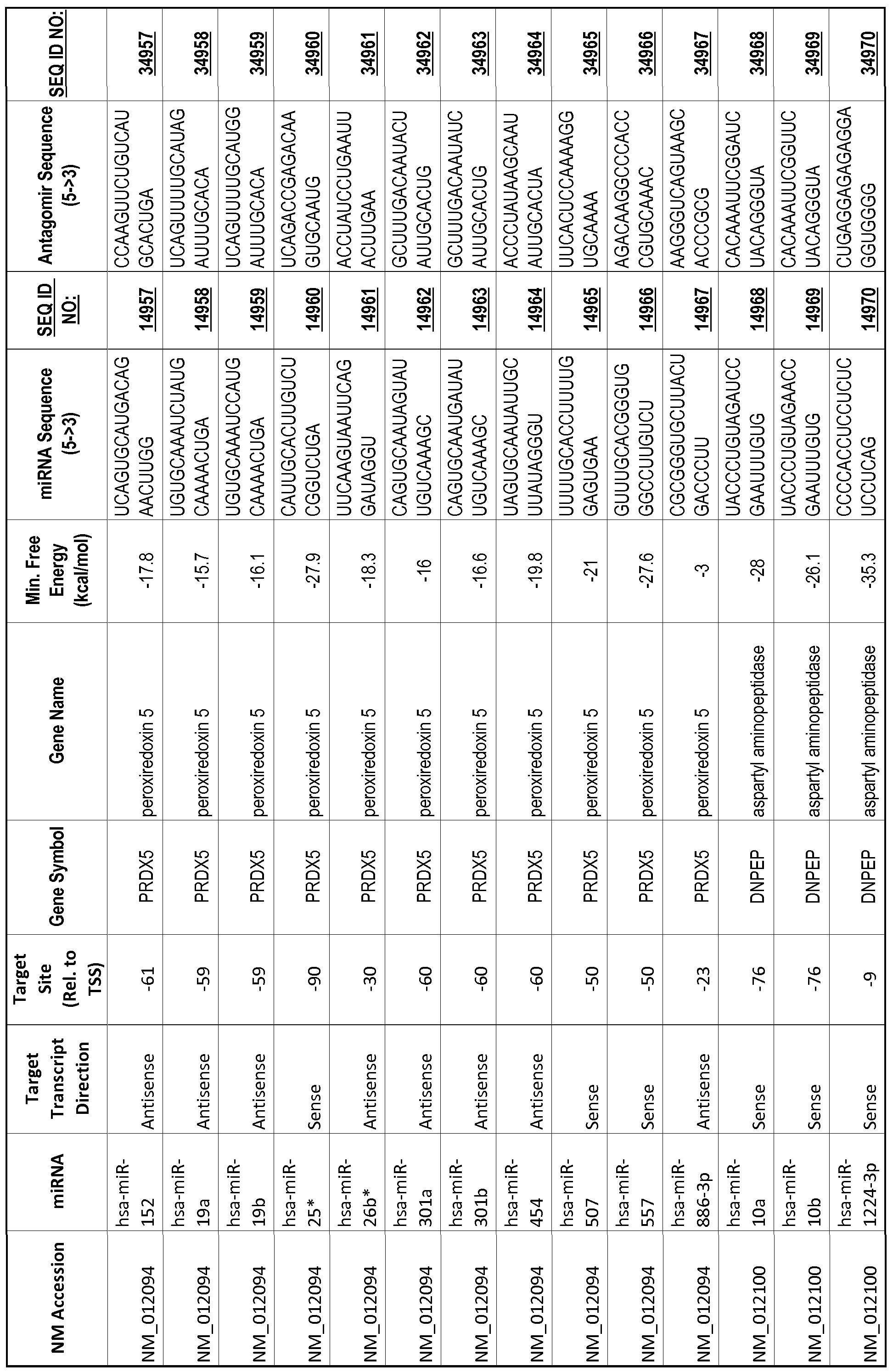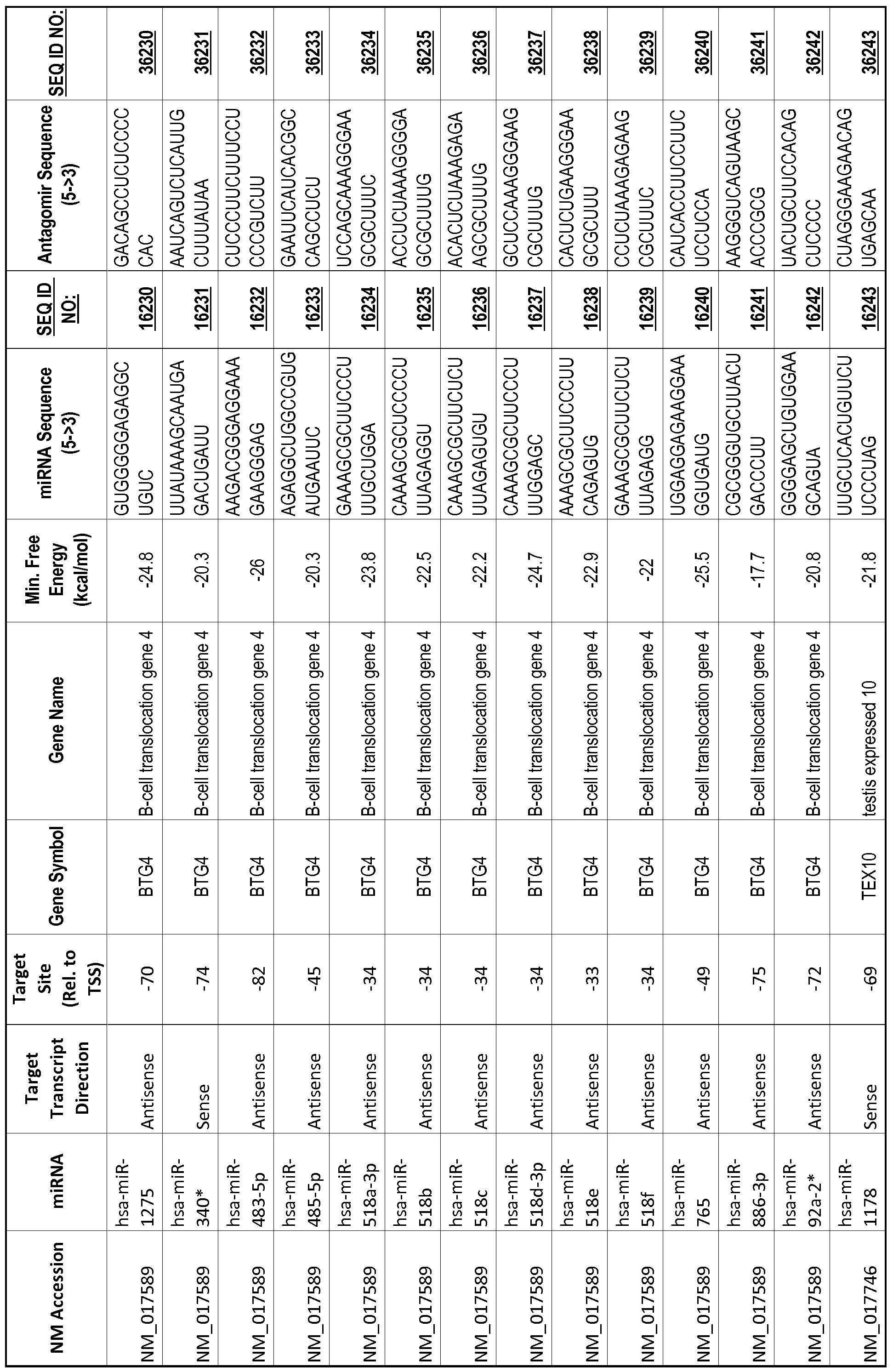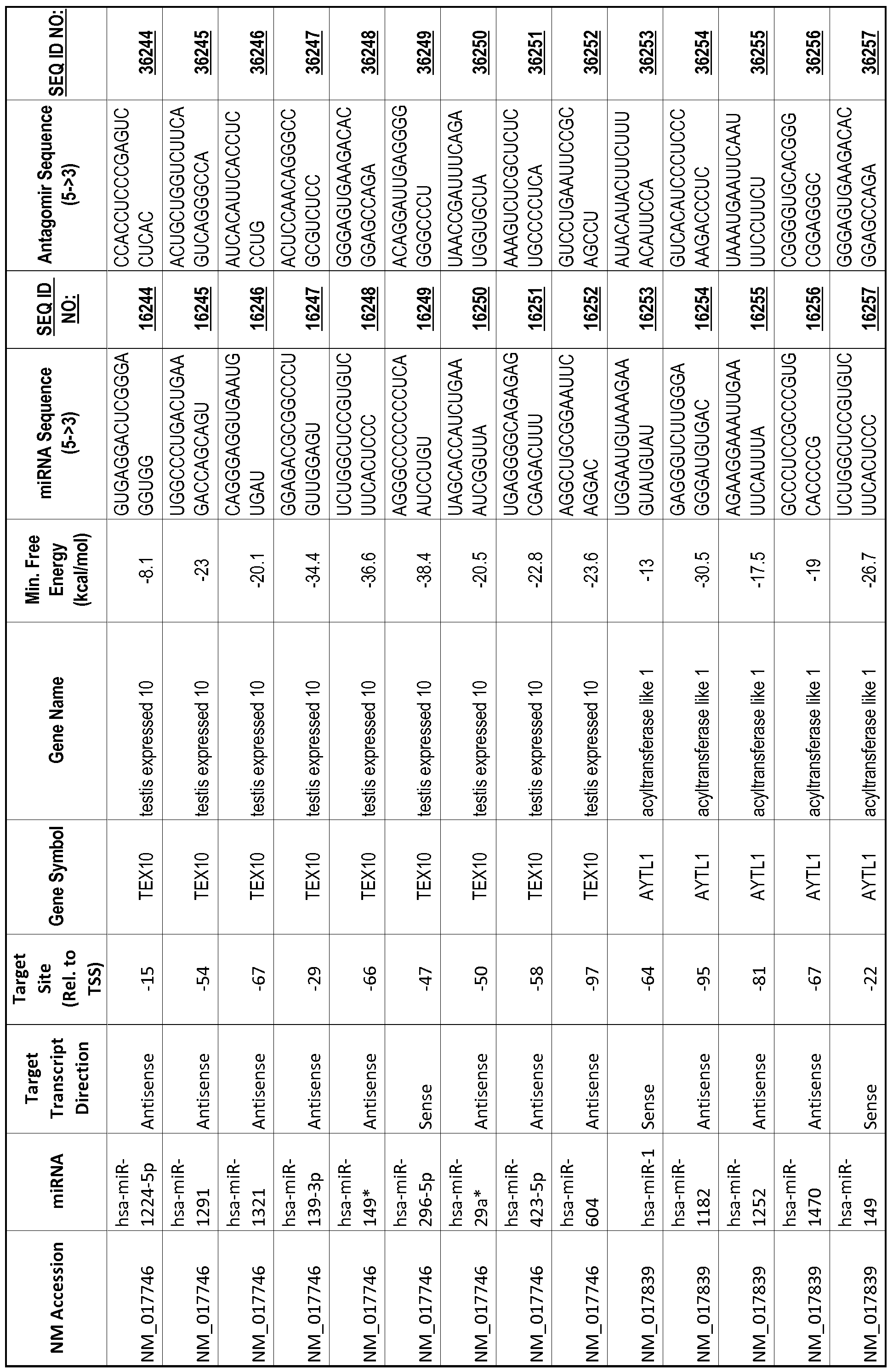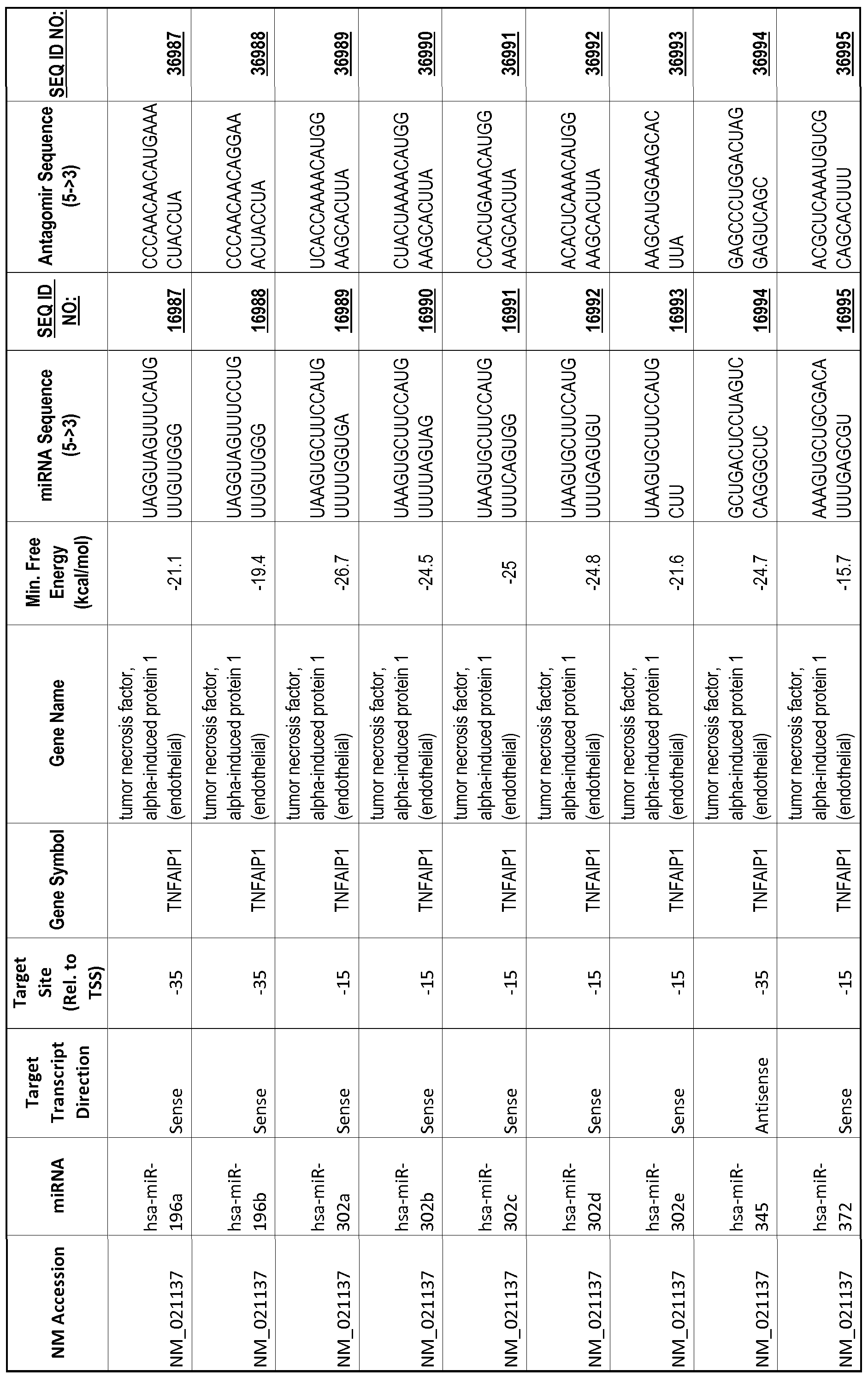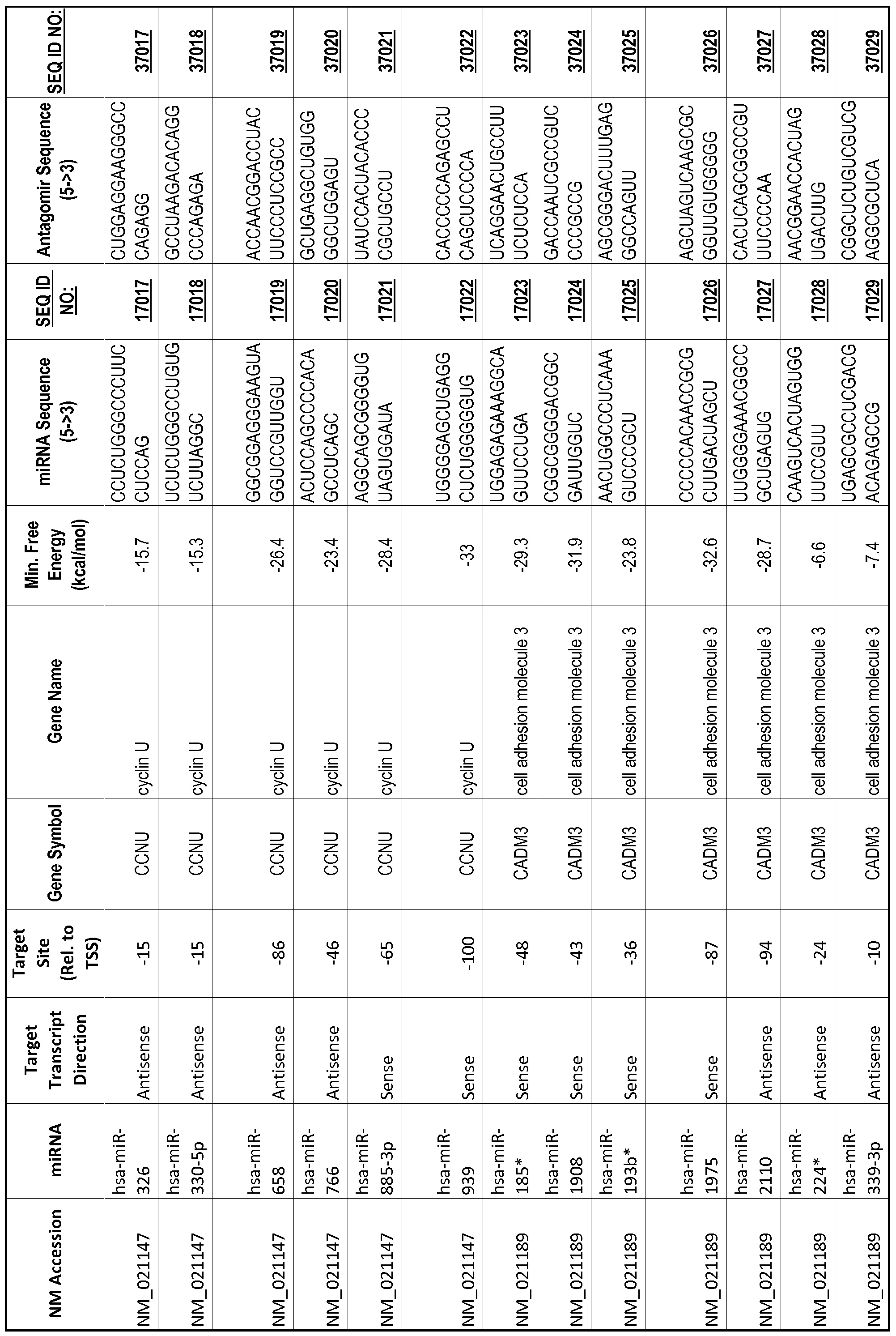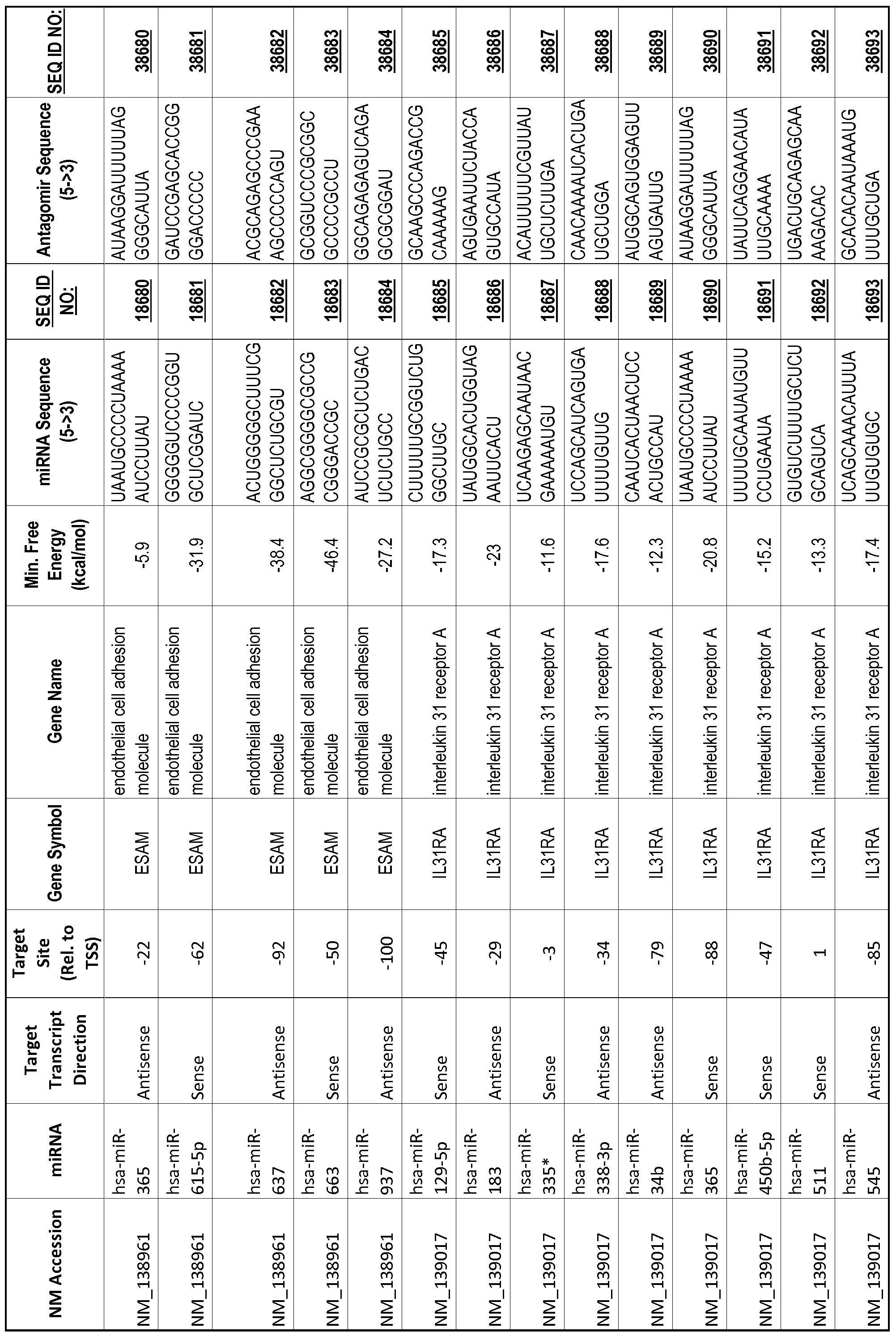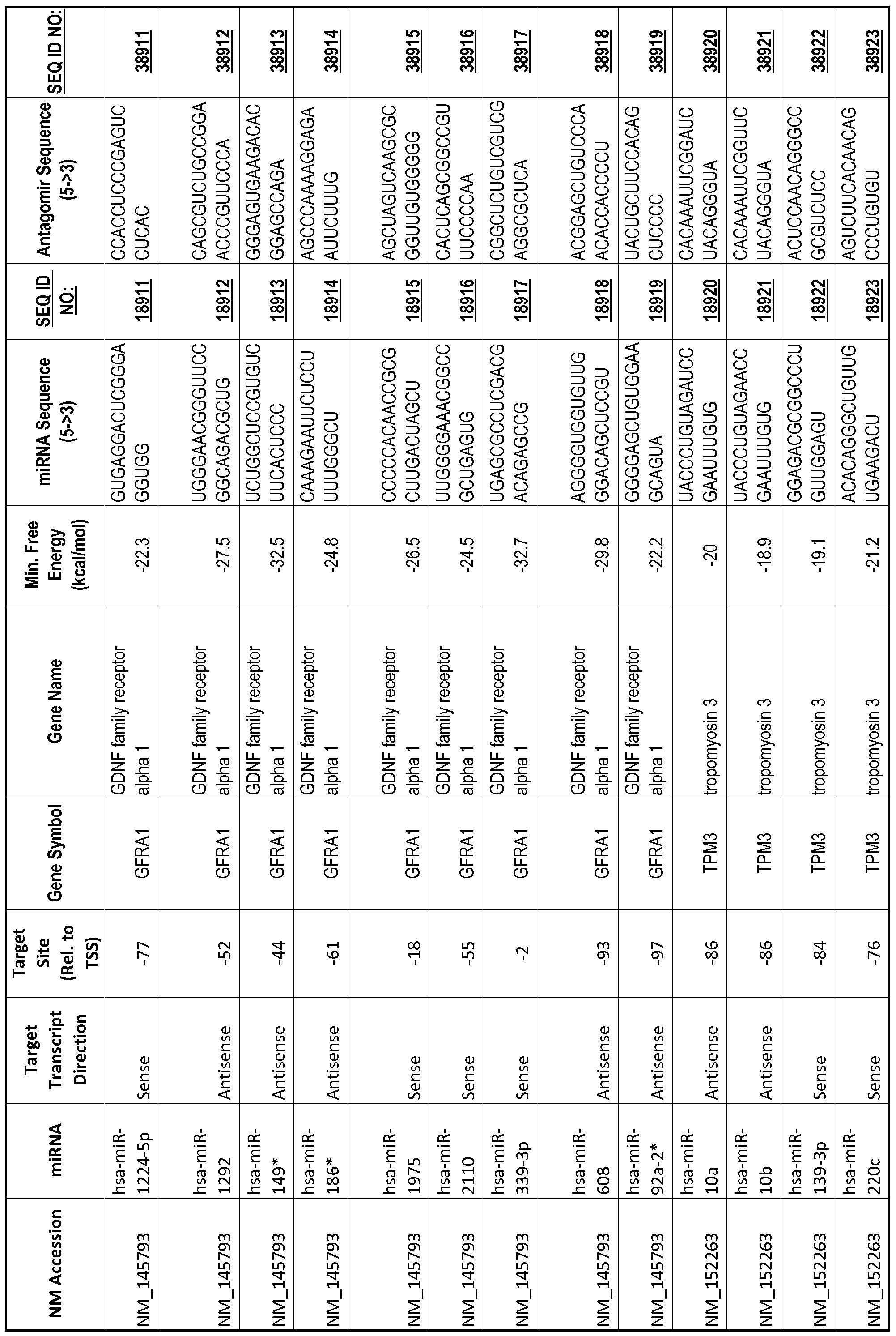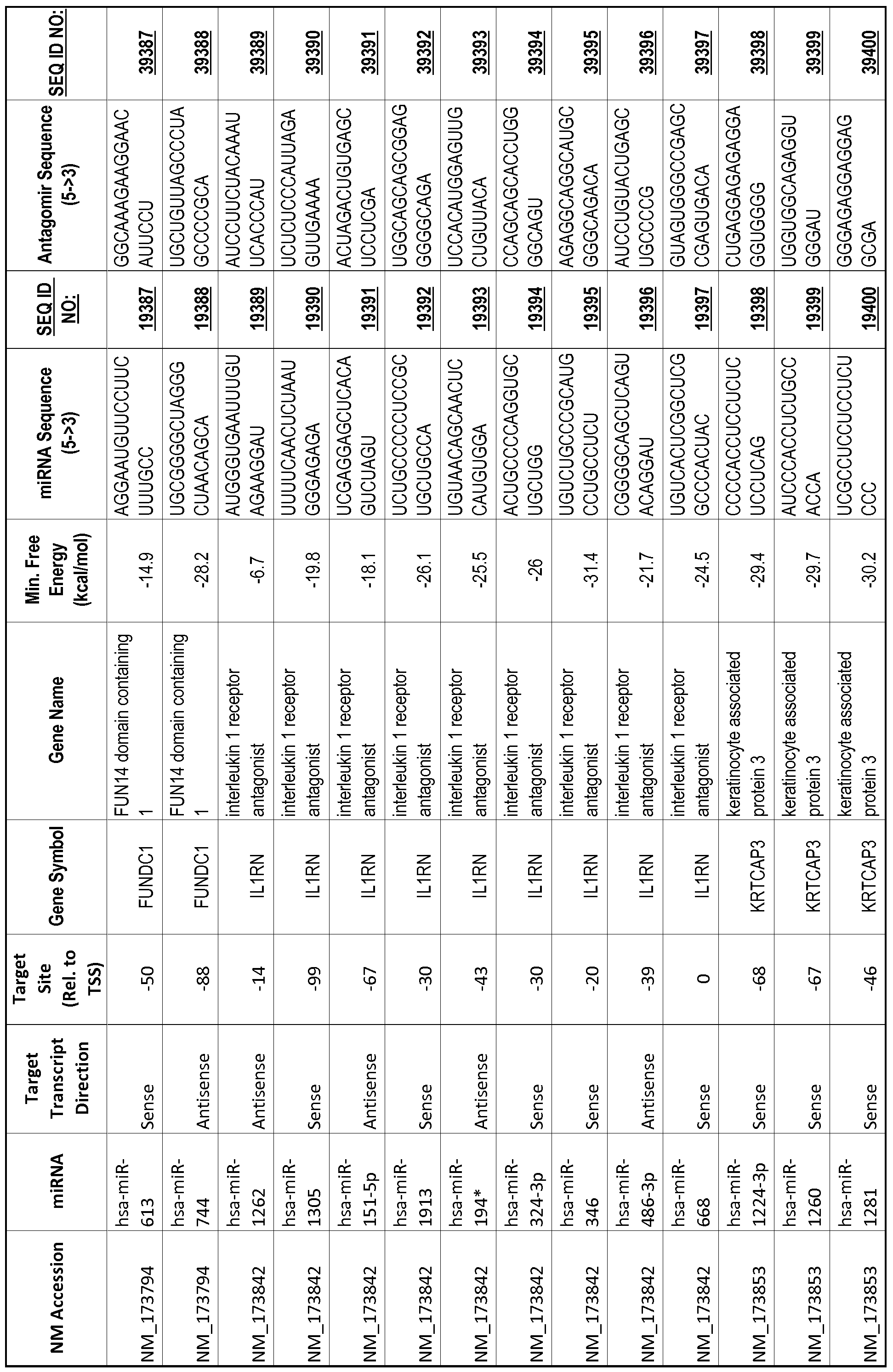DESCRIPTION
MODULATION OF GENE EXPRESSION THROUGH ENDOGENOUS SMALL RNA
TARGETING OF GENE PROMOTERS
CROSS-REFERENCE TO RELATED APPLICATIONS
[0001] This application claims benefit of priority to U.S. Provisional Application Serial No. 61/058,909, filed June 4, 2008, and U.S. Provisional Application Serial No. 61/172,556, filed April 24, 2009, the entire contents of each application being hereby incorporated by reference.
STATEMENT REGARDING FEDERALLY SPONSORED RESEARCH
[0002] This work was made with government support under grants NIGMS 60642, 77253, and 73042, ROlCA 129632 and GM07062 from the National Institutes of Health. The government has certain rights in this invention.
I. Field of the Invention [0003] The invention relates to modulating of gene expression using single-stranded oligonucleotides complementary to endogenous miRNAs complementary to promoter regions of target genes.
II. Background of the Invention [0004] Synthetic small duplex RNAs complementary to gene promoters within chromosomal DNA are potent inhibitors or activators of target gene expression in mammalian cells (Morris et al, 2004; Ting et al, 2005; Janowski et al, 2005; Li et al, 2006; Janowski et al, 2007). These synthetic RNAs are called antigene RNAs (agRNAs) to distinguish them from small duplex RNAs that target mRNA. agRNAs recruit members of the argonaute (AGO) protein family to RNA transcripts that originate from the target gene promoter (Janowski et al, 2006; Kim et al, 2006; Han et al, 2007; Schwartz et al, 2008). Recognition of the target RNA occurs in close proximity to the chromosome, resulting in transcriptional modulation of the target gene.
[0005] One remarkable feature of the synthetic agRNAs that the inventors have examined is the potency and robustness of their activity when they are introduced into cells. This potency, coupled with the presence of protein machinery that facilitates their function, suggests that endogenous small RNAs may possess the ability to recognize gene promoters. If RNA could
direct proteins to specific gene promoters, such RNA-mediated modulation of transcription might have evolutionary advantages relative to the development of gene-specific protein transcription factors.
[0006] Synthetic duplex RNAs that are complementary to mRNA (small interfering RNAs or siRNAs) are also potent and robust agents for modulating gene expression (Fire et al, 1998). siRNAs are known to have endogenous analogs that regulate gene expression called microRNAs (miRNAs) (Lagos-Quintana et al, 2001). miRNAs are processed inside the cell from RNA precursors that contain stem-loop structures. These stem-loop structures are processed by the double-stranded nucleases Drosha and Dicer to produce mature miRNAs.
[0007] As of the current release of the miRNA repository (miRBase vl2.0), 866 human miRNAs have been annotated, but this number continues to increase. Several miRNAs that recognize sequences within the 3 '-untranslated regions (3'UTR) of mRNA transcripts have been characterized. Many miRNAs, however, have no known targets (Lee et al, 1993; John et al, 2004) while some can recognize multiple mRNAs, suggesting that the determinants of miRNA interactions are complex and poorly understood.
[0008] Two reports based on computational analyses have suggested that miRNAs can modulate gene expression through promoter recognition. Dahiya and co-workers used publically available software (RegRNA) to search for potential miRNA target sites within the promoter of the E-cadherin gene (Place et al, 2008). They identified one potential binding site for miR-373 within the E-cadherin promoter and reported that introduction of a synthetic miR-373 mimic increased expression of the gene by 6-fold at the level of the mRNA. Rossi and co-workers searched for perfect complementarity between miRNAs and gene promoters (Kim et al, 2008). Their analysis suggested that miR-320 targets the genomic location from which it is transcribed and showed that expression of miR-320 and the adjacent gene, POLR3D, are anti-correlated.
[0009] The above-mentioned studies either analyzed a single gene promoter or used highly stringent sequence comparison criteria. These approaches were not intended to assess the broader potential for miRNAs to recognize gene promoters, warranting a more thorough evaluation of the relationship between miRNAs and promoter sequences.
[0010] A practical justification for more comprehensive studies is that validating natural gene targets of miRNAs is a complex and difficult process. The development of systematic
and efficient methods for identifying promoter sequences that may be miRNA targets is essential for prioritizing predictions and efficiently allocating experimental resources towards validating the most promising targets.
SUMMARY OF THE INVENTION
[0011] Thus, in accordance with the present invention, there is provided a method of modulating expression of a target gene in a cell comprising contacting an endogenous miRNA complementary to a portion of a promoter of the target gene with a single-stranded complementary oligonucleotide that hybridizes to the miRNA, thereby modulating expression of the target gene. The miRNA may target a non-coding RNA (ncRNA) transcribed from the promoter. The single-stranded complementary oligonucleotide may comprise at least one locked nucleic acid (LNA) base or at least one 2'-O-methyl (2'-0-me) base. The miRNA may be 80%, 85%, 90%, 95% or 100% complementary to the portion of the promoter. The single-stranded complementary oligonucleotide may be the same length as the miRNA or shorter than the miRNA. The complementary oligonucleotide may comprise of or consist of a sequence selected from SEQ ID NOS :20001-40000.
[0012] The target gene may be trophinin-associated protein (TROAP), proline-rich nuclear receptor coactivator 2 (PNRC2), protein phosphatase 2C, Mg-dependent catalytic subunit (PPM2C), pregnancy specific beta- 1 -glycoprotein 1 (PSGl), anterior pharynx defective 1 homolog B (C. elegans) (APHlB), U2AF homology motif (UHM) kinase 1 (UHMKl), ring finger protein 165 (RNF 165), catechol 0-methyltransferase (COMT), tyrosine protein kinse 03 (TYRO3), γ-aminobutyric acid A receptor α2 (GABRA2) or calcium/calmodulin- dependent protein kinase II inhibitor 1 (CAMK2N1). The target gene also may be brain and reproductive organ-expressed (TNFRSFlA modulator) (BRE); caveolin 1 (caveolae protein, 22kDa, CAVl); inhibin, alpha (INHA); ribonuclease/angiogenin inhibitor 1 (RNHl); SpI transcription factor (SPl); DEK oncogene (DNA binding) (DEK); hepatic leukemia factor (HLF); opioid receptor, kappa 1 (OPRKl); or glyceraldehyde-3 -phosphate dehydrogenase, spermatogenic (GAPDHS). The target gene may also be any of the genes set for the Table 1, and the target sequence may be selected from SEQ ID NOS: 1-20000.
[0013] The target gene may be a native gene, and in a particular, embodiment, the cell may be located in situ in a host, and the contacting step is effected by administering to the host an effective amount of the complementary oligonucleotide. In a particular embodiment, the
target gene is Caveolin-1 in a metastatic cell, the contacting step is effected by contacting the cell an effective amount of the complementary oligonucleotide comprising locked nucleic acid (LNA) or 2'-O-methyl (2'-0-me) bases. In another particular embodiment, the target gene is MAPKAPK2 in situ in a host, the contacting step is effected by administering to the host an effective amount of the complementary oligonucleotide comprising locked nucleic acid (LNA) or 2'-O-methyl (2'-0-me) bases.
[0014] In various embodiments, the expression of the target gene may be increased or decreased. The method may further comprise detecting a change in the expression of the target gene, for example, by inferring a change in the expression of the target gene from a physiologic change in the cell, or by detecting comprises one or more of Northern blot, PCR, immunohistochemistry, Western blot or ELISA. The cell may be located in situ in a host and the detecting may comprise inferring a change in the expression of the target gene from a physiologic change in the host.
[0015] The portion may lie between -200 and -1 relative to a transcriptional start site of the target gene, between -500 and -201 relative to a transcriptional start site of the target gene, or between -2000 and -501 relative to a transcriptional start site of the target gene. The method may further comprise the step of identifying the endogenous miRNA, such as by identifying an miRNA seed region is the promoter, by calculating a minimum free energy for said seed region.
[0016] In another embodiment, there is provided method for identifying an endogenous miRNA that modulates expression of a target gene (a) identifying an endogenous miRNA exhibiting complementarity to a portion of a promoter of the target gene; and (b) assessing the ability of the complementary miRNA to modulate expression of the target gene.
[0017] The invention provides compositions such as reagents and formulations tailored to the subject methods. It is contemplated that any method or composition described herein can be implemented with respect to any other method or composition described herein.
[0018] The use of the word "a" or "an" when used in conjunction with the term "comprising" in the claims and/or the specification may mean "one," but it is also consistent with the meaning of "one or more," "at least one," and "one or more than one."
[0019] These and other embodiments of the invention will be better understood when considered in conjunction with the following description and the accompanying drawings. It should be understood that the following description, while indicating various embodiments of the invention and numerous specific details thereof, is given by way of illustration and not of limitation. Many substitutions, modifications, additions and/or rearrangements may be made within the scope of the invention without departing from the spirit thereof, and the invention includes all such substitutions, modifications, additions and/or rearrangements.
BRIEF DESCRIPTION OF THE FIGURES
[0020] The following drawings form part of the present specification and are included to further demonstrate certain aspects of the present invention. The invention may be better understood by reference to one or more of these drawings in combination with the detailed description of specific embodiments presented herein [0021] FIG. 1 - Sequence comparison process.
[0022] FIG. 2 - miRNAs and target gene promoters.
[0023] FIG. 3 - Alignment of miRNAs and target gene promoters.
[0024] FIG. 4 - siRNA, miRNA mimics and LNA-miRNA inhibitors.
[0025] FIG. 5 - Primers for qPCR.
[0026] FIG. 6 - Primers for RACE.
[0027] FIGS. 7A-B - (FIG. 7A) Diagram of sequences that are potential miRNA targets. (FIG. 7B) Schematic of algorithm used to predict miRNA targets within gene promoters.
[0028] FIGS. 8A-C - Gene promoters contain predicted miRNA target sites. (FIG. 8A) The frequency of seed sequence matches in promoter regions, 5'UTRs, coding sequences, and 3'UTRs. (FIG. 8B) Comparison of seed matches within promoter-overlapping transcripts vs. randomized promoter sequences. (FIG. 8C) Distribution of seed match locations within sense and antisense transcripts that overlap gene promoters from -1 to -200 relative to the +1 transcription start site.
[0029] FIGS. 9A-B - MFE properties of miRNA target predictions. (FIG. 9A) Distribution of MFE values for predictions within promoter-overlapping transcripts as compared to
randomized promoter sequences. (FIG. 9B) Distribution of MFE values for predictions within promoter-overlapping transcripts as compared to 3'UTRs.
[0030] FIG. 10 - Examples of predicted miRNA targets within sequences of promoter- overlapping transcripts.
[0031] FIG. 11 - miR-423-5p mimic decreases expression of predicted target genes.
DETAILED DESCRIPTION OF SPECIFIC EMBODIMENTS OF THE INVENTION
[0032] The invention provides a general method of selectively modulating (increasing or decreasing) expression (i.e., transcription) of a target gene by (a) identifying an endogenous miRNA complementary to a promoter of the target gene; (b) contacting the miRNA with a single-stranded complementary oligonucleotide that hybridizes to the miRNA, thereby modulating expression of the target gene. In a particular embodiment, the target gene is a native gene, may be located in a cell, which may be in situ in a host, the contacting step is effected by administering to the host an effective amount of the oligonucleotide, and/or the modulated expression is inferred from a correlated physiologic change in the host.
[0033] As disclosed and exemplified herein, by exploiting this hitherto unappreciated endogenous mechanism for selective regulation of gene expression, these methods are generally applicable across a wide variety of target genes, promoter regions, oligonucleotides, cell types and delivery conditions. While conditions whereby a given oligonucleotide selectively modulates expression of a given target gene may be confirmed empirically (e.g., pursuant to the protocols described herein), these data indicate that mammalian cells are generally amenable to target gene selective modulation of target gene expression using these methods.
[0034] Various aspects of the invention, as set forth above, are described in greater detail in the following paragraphs.
I. miRNA and Oligonucleotide Antagonists Thereof A. miRNAs
[0035] microRNAs (miRNA) are single-stranded RNA molecules of 21-23 nucleotides in length, which regulate gene expression. miRNAs are encoded by genes from whose DNA they are transcribed but miRNAs are not translated into protein (non-coding RNA); instead
each primary transcript (a pri-miRNA) is processed into a short stem-loop structure called a pre-miRNA and finally into a functional miRNA. Mature miRNA molecules are partially complementary to one or more messenger RNA (mRNA) molecules, and their main function is to down-regulate gene expression.
[0036] The genes encoding miRNAs are much longer than the processed mature miRNA molecule; miRNAs are first transcribed as primary transcripts or pri-miRNA (up to about 100 bases in length) with a cap and poly-A tail, and then processed to short, 70-nucleotide stem- loop structures known as pre -miRNA in the cell nucleus. This processing is performed in animals by a protein complex known as the Microprocessor complex, consisting of the nuclease Drosha and the double-stranded RNA binding protein Pasha. These pre-miRNAs are then processed to mature miRNAs in the cytoplasm by interaction with the endonuclease Dicer, which also initiates the formation of the RNA-induced silencing complex (RISC). This complex is responsible for the gene silencing observed due to miRNA expression and RNA interference.
[0037] In general, perfect complementarity between the target sequences and bases 2-8 of the mature miRNA sequence is required for miRNA function. Although not necessarily a prerequisite for miRNA function, the minimum free energy (MFE) of hybridization between miRNAs and their predicted target sites have been successfully used to predict miRNA target sites within 3'UTRs (Stark et ah, 2003). Another criterion used in miRNA target prediction is sequence complementarity. Sequence complementarity alone has been used successfully to predict miRNA target sites within 3'UTRs (Lai, 2002).
B. Antagonists
[0038] Oligonucleotides of the present invention are single-stranded nucleic acid segments of 12-30 bases in length that are designed to target miRNAs that bind to promoter encoded sequences in target cells. In particular, ranges of 12-23, 15-30, 15-23, 18-23, 19-23, 20-23 and 21-23 bases are contemplated, as are specific lengths of 12, 13, 14, 15, 16, 17, 18, 19, 20, 21, 22, 23, 24 and 25 bases. Such sequences have been termed "antagomirs" to indicate their ability to antagonize miRNAs.
[0039] In general, antagomirs are defined as single-stranded, double-stranded, partially double-stranded and hairpin structured oligonucleotides that target an miRNA. An antagomir generally is at least 12 or more contiguous nucleotides completely or substantially
complementary to an endogenous miRNA or pre-miRNA nucleotide sequence. In particular, an antagomir includes a nucleotide sequence sufficiently complementary to hybridize to 12- 23 nucleotides from an miRNA target sequence. Exemplary target sequences are provided in Table 1 and as SEQ ID NOS: 1-20000, while corresponding antagomirs are listed there and as SEQ ID NOS :20001-40000.
[0040] Oligonucleotides are chemically synthesized using nucleoside phosphoramidites. A phosphoramidite is a derivative of natural or synthetic nucleoside with protection groups added to its reactive exocyclic amine and hydroxy groups. The naturally occuring nucleotides (nucleoside-3 '-phosphates) are insufficiently reactive to afford the synthetic preparation of oligonucleotides. A dramatically more reactive (2-cyanoethyl) N,N-diisopropyl phosphoramidite group is therefore attached to the 3 '-hydroxy group of a nucleoside to form nucleoside phosphoramidite. The protection groups prevent unwanted side reactions or facilitate the formation of the desired product during synthesis. The 5'-hydroxyl group is protected by DMT (dimethoxytrityl) group, the phosphite group by a diisopropylamino (iPr2N) group and a 2-cyanoethyl (OCH2CH2CN) group. The nucleic bases also have protecting groups on the exocyclic amine groups (benzoyl, acetyl, isobutyryl, or many other groups). In RNA synthesis, the 2' group is protected with a TBDMS (t-butyldimethylsilyl) group or with a TOM (t-butyldimethylsilyloxymethyl) group. With the completion of the synthesis process, all the protection groups are removed.
[0041] Whereas enzymes synthesize DNA in a 5' to 3' direction, chemical DNA synthesis is done backwards in a 3' to 5' reaction. Based on the desired nucleotide sequence of the product, the phosphoramidites of nucleosides A, C, G, and T are added sequentially to react with the growing chain in a repeating cycle until the sequence is complete. In each cycle, the product's 5 '-hydroxy group is deprotected and a new base is added for extension. In solid- phase synthesis, the oligonucleotide being assembled is bound, via its 3 '-terminal hydroxy group, to a solid support material on which all reactions take place. The 3' group of the first base is immobilized via a linker onto a solid support (most often, controlled pore glass particles or macroporouspolystyrene beads). This allows for easy addition and removal of reactants. In each cycle, several solutions containing reagents required for the elongation of the oligonucleotide chain by one nucleotide residue are sequentually pumped through the column from an attached reagent delivery system and removed by washing with an inert solvent.
[0042] Antagomirs can be synthesized to include a modification that imparts a desired characteristic. For example, the modification can improve stability, hybridization thermodynamics with a target nucleic acid, targeting to a particular tissue or cell-type, or cell permeability, e.g., by an endocytosis-dependent or -independent mechanism. Modifications can also increase sequence specificity, and consequently decrease off-site targeting. In one embodiment, the antagomir includes a non-nucleotide moiety, e.g., a cholesterol moiety. The non-nucleotide moiety can be attached to the 3' or 5' end of the oligonucleotide agent.
[0043] A wide variety of well-known, alternative oligonucleotide chemistries may be used (see, e.g., U.S. Patent Publications 2007/0213292, 2008/0032945, 2007/0287831, etc.), particularly single-stranded complementary oligonucleotides comprising 2' methoxyethyl, T- fluoro, and morpholino bases (see e.g., Summerton and Weller, 1997). The oligonucleotide may include a 2'-modifϊed nucleotide, e.g., a 2'-deoxy, 2'-deoxy-2'-fluoro, 2'-O-methyl, T- O-methoxyethyl (2'-0-MOE), 2'-O-aminopropyl (2'-0-AP), 2'-O-dimethylaminoethyl (T- O-DMAOE), 2'-O-dimethylaminopropyl (2'-0-DMAP), 2'-O-dimethylaminoethyloxyethyl (2'-0-DMAEOE), or 2'-O~N-methylacetamido (2'-0--NMA). Also contemplated are locked nucleic acid (LNA) and peptide nucleic acids (PNA).
[0044] Peptide nucleic acids (PNAs) are nonionic DNA mimics that have outstanding potential for recognizing duplex DNA (Kaihatsu et al., 2004; Nielsen et al, 1991). PNAs can be readily synthesized and bind to complementary sequences by standard Watson-Crick base-pairing (Egholm et al, 1993), allowing them to target any sequence within the genome without the need for complex synthetic protocols or design considerations. Strand invasion of duplex DNA by PNAs is not hindered by phosphate-phosphate repulsion and is both rapid and stable (Kaihatsu et al, 2004; Nielsen et al, 1991). Applications for strand invasion by PNAs include creation of artificial primosomes (Demidov et al, 2001), inhibition of transcription (Larsen and Nielsen, 1996), activation of transcription (Mollegaard et al, 1994), and directed mutagenesis (Faruqi et al., 1998). PNAs would provide a general and potent strategy for probing the structure and function of chromosomal DNA in living systems if their remarkable strand invasion abilities could be efficiently applied inside cells.
[0045] Strand invasion by PNAs in cell-free systems is most potent at sequences that are partially single-stranded (Bentin and Nielsen, 1996; Zhang et al., 2000). Assembly of RNA polymerase and transcription factors into the pre -initiation complex on DNA induces the formation of a structure known as the open complex that contains several bases of single-
stranded DNA (Holstege et al, 1997; Kahl et al, 2000). The exceptional ability of PNAs to recognize duplex DNA allows them to intercept the open complex of an actively transcribed gene without a requirement for preincubation. The open complex is formed during transcription of all genes and PNAs can be synthesized to target any transcription initiation site. Therefore, antigene PNAs that target an open complex at a promoter region within chromosomal DNA would have the potential to be general tools for controlling transcription initiation inside cells.
[0046] A locked nucleic acid (LNA), often referred to as inaccessible RNA, is a modified RNA nucleotide (Elmen et al, 2008). The ribose moiety of an LNA nucleotide is modified with an extra bridge connecting the 2' and 4' carbons. The bridge "locks" the ribose in the 3'- endo structural conformation, which is often found in the A-form of DNA or RNA. LNA nucleotides can be mixed with DNA or RNA bases in the oligonucleotide whenever desired. Such oligomers are commercially available. The locked ribose conformation enhances base stacking and backbone pre-organization. This significantly increases the thermal stability (melting temperature) of oligonucleotides (Kaur et al, 2006). LNA bases may be included in a DNA backbone, by they can also be in a backbone of LNA, 2'-O-methyl RNA, T- methoxyethyl RNA, or 2'-fluoro RNA. These molecules may utilize either a phosphodiester or phosphorothioate backbone.
[0047] Other oligonucleotide modifications can be made to produce oligonucleotides. For example, stability against nuclease degradation has been achieved by introducing a phosphorothioate (P=S) backbone linkage at the 3' end for exonuclease resistance and 2' modifications (2'-OMe, 2'-F and related) for endonuclease resistance (WO 2005115481; Li et al., 2005; Choung et al., 2006). A motif having entirely of 2'-O-methyl and 2'-fluoro nucleotides has shown enhanced plasma stability and increased in vitro potency (Allerson et al., 2005). The incorporation of 2'-0-Me and 2'-0-MOE does not have a notable effect on activity (Prakash et al, 2005).
[0048] Sequences containing a 4'-thioribose modification have been shown to have a stability 600 times greater than that of natural RNA (Hoshika et al, 2004). Crystal structure studies reveal that 4'-thioriboses adopt conformations very similar to the C3'-endo pucker observed for unmodified sugars in the native duplex (Haeberli et al, 2005). Stretches of 4'- thio-RNA were well tolerated in both the guide and nonguide strands. However, optimization
of both the number and the placement of 4'-thioribonucleosides is necessary for maximal potency.
[0049] In the boranophosphate linkage, a non-bridging phosphodiester oxygen is replaced by an isoelectronic borane (BH3-) moiety. Boranophosphate siRNAs have been synthesized by enzymatic routes using T7 RNA polymerase and a boranophosphate ribonucleoside triphosphate in the transcription reaction. Boranophosphate siRNAs are more active than native siRNAs if the center of the guide strand is not modified, and they may be at least ten times more nuclease resistant than unmodified siRNAs (Hall et al, 2004; Hall et al, 2006).
[0050] Certain terminal conjugates have been reported to improve or direct cellular uptake. For example, NAAs conjugated with cholesterol improve in vitro and in vivo cell permeation in liver cells (Rand et al, 2005). Soutschek et al. (2004) have reported on the use of chemically-stabilized and cholesterol-conjugated siRNAs have markedly improved pharmacological properties in vitro and in vivo. Chemically-stabilized siRNAs with partial phosphorothioate backbone and 2'-O-methyl sugar modifications on the sense and antisense strands (discussed above) showed significantly enhanced resistance towards degradation by exo- and endonucleases in serum and in tissue homogenates, and the conjugation of cholesterol to the 3 ' end of the sense strand of an oligonucleotides by means of a pyrrolidine linker does not result in a significant loss of gene-silencing activity in cell culture. These study demonstrates that cholesterol conjugation significantly improves in vivo pharmacological properties of oligonucleotides.
[0051] U.S. Patent Publication 2008/0015162, incorporated herein by reference, provide additional examples of nucleic acid analogs useful in the present invention. The following excerpts are derived from that document and are exemplary in nature only.
[0052] In certain embodiments, oligomeric compounds comprise one or more modified monomers, including 2 '-modified sugars, such as BNA's and monomers {e.g., nucleosides and nucleotides) with 2'-substituents such as allyl, amino, azido, thio, O-allyl, 0--C1-C1O alkyl, -OCF3, O-(CH2)2-O-CH3, 2'-O(CH2)2SCH3, O-(CH2)2~O-N(Rm)(Rn), or 0-CH2- C(=O)— N(Rm)(Rn), where each Rm and Rn is, independently, H or substituted or unsubstituted C1-C10 alkyl.
[0053] In certain embodiments, the oligomeric compounds including, but no limited to short oligomers of the present invention, comprise one or more high affinity monomers provided
that the oligomeric compound does not comprise a nucleotide comprising a 2'-0(CH2)J1H, wherein n is one to six. In certain embodiments, the oligomeric compounds including, but no limited to short oligomers of the present invention, comprise one or more high affinity monomer provided that the oligomeric compound does not comprise a nucleotide comprising a 2'-OCH3 or a 2'-O(CH2)2OCH3. In certain embodiments, the oligomeric compounds comprise one or more high affinity monomers provided that the oligomeric compound does not comprise a α-L-methyleneoxy (4'-CH2- 0-2') BNA and/or a β-D-methyleneoxy (4 '-CH2- -0-2') BNA.
[0054] Certain BNA' s have been prepared and disclosed in the patent literature as well as in scientific literature (Singh et al, 1998; Koshkin et al, 1998; Wahlestedt et al, 2000; Kumar et al, 1998; WO 94/14226; WO 2005/021570; Singh et al, 1998; examples of issued US patents and published applications that disclose BNA s include, for example, U.S. Patents
7,053,207; 6,268,490; 6,770,748; 6,794,499; 7,034,133; and 6,525,191; and U.S. Patent
Publication Nos. 2004/0171570; 2004/0219565; 2004/0014959; 2003/0207841; 2004/0143114; and 2003/0082807.
[0055] Also provided herein are BNAs in which the 2'-hydroxyl group of the ribosyl sugar ring is linked to the 4' carbon atom of the sugar ring thereby forming a methyleneoxy (4'- CH2- O-2') linkage to form the bicyclic sugar moiety (reviewed in Elayadi et al, 2001; Braasch et al, 2001; see also U.S. Patents 6,268,490 and 6,670,461). The linkage can be a methylene (-CH2-) group bridging the 2' oxygen atom and the 4' carbon atom, for which the term methyleneoxy (4'-CH2- O-2') BNA is used for the bicyclic moiety; in the case of an ethylene group in this position, the term ethyl eneoxy (4'-CH2CH2- O-2') BNA is used (Singh et al, 1998; Morita et al, 2003). Methyleneoxy (4'-CH2-O-2') BNA and other bicyclic sugar analogs display very high duplex thermal stabilities with complementary DNA and RNA (Tm = +3 to +100C), stability towards 3'-exonucleolytic degradation and good solubility properties. Potent and nontoxic antisense oligonucleotides comprising BNAs have been described (Wahlestedt et al, 2000).
[0056] An isomer of methyleneoxy (4'-CH2- O-2') BNA that has also been discussed is α- L-methyleneoxy (4'-CH2- O-2') BNA which has been shown to have superior stability against a 3'-exonuclease. The α-L-methyleneoxy (4'-CH2- O-2') BNA's were incorporated into antisense gapmers and chimeras that showed potent antisense activity (Frieden et al, 2003).
[0057] The synthesis and preparation of the methyleneoxy (4'-CH2- 0-2') BNA monomers adenine, cytosine, guanine, 5-methyl-cytosine, thymine and uracil, along with their oligomerization, and nucleic acid recognition properties have been described (Koshkin et al., 1998). BNAs and preparation thereof are also described in WO 98/39352 and WO 99/14226.
[0058] Analogs of methyleneoxy (4'-CH2~O-2') BNA, phosphorothioate-methyleneoxy (4'- CH2-O-2') BNA and 2'-thio-BNAs, have also been prepared (Kumar et al, 1998). Preparation of locked nucleoside analogs comprising oligodeoxyribonucleotide duplexes as substrates for nucleic acid polymerases has also been described (Wengel et al., WO 99/14226). Furthermore, synthesis of 2'-amino-BNA, a novel comformationally restricted high-affinity oligonucleotide analog has been described in the art (Singh et al., 1998). In addition, 2 '-amino- and 2'-methylamino-BNA's have been prepared and the thermal stability of their duplexes with complementary RNA and DNA strands has been previously reported.
[0059] Modified sugar moieties are well known and can be used to alter, typically increase, the affinity of oligomers for targets and/or increase nuclease resistance. A representative list of modified sugars includes, but is not limited to, bicyclic modified sugars (BNA' s), including methyleneoxy (4'-CH2~O-2') BNA and ethyleneoxy (4'-(CH2)2~O-2' bridge) BNA; substituted sugars, especially 2'-substituted sugars having a 2'-F, 2'-OCH3 or a T- O(CH2)2— OCH3 substituent group; and 4'-thio modified sugars. Sugars can also be replaced with sugar mimetic groups among others. Methods for the preparations of modified sugars are well known to those skilled in the art. Some representative patents and publications that teach the preparation of such modified sugars include, but are not limited to, U.S. Patents 4,981,957; 5,118,800; 5,319,080; 5,359,044; 5,393,878; 5,446,137; 5,466,786; 5,514,785; 5,519,134; 5,567,811; 5,576,427; 5,591,722; 5,597,909; 5,610,300; 5,627,053; 5,639,873; 5,646,265; 5,658,873; 5,670,633; 5,792,747; 5,700,920; 6,531,584; and 6,600,032; and WO 2005/121371.
[0060] The naturally-occurring base portion of a nucleoside is typically a heterocyclic base. The two most common classes of such heterocyclic bases are the purines and the pyrimidines. For those nucleosides that include a pentofuranosyl sugar, a phosphate group can be linked to the 2', 3' or 5' hydroxyl moiety of the sugar. In forming oligonucleotides, those phosphate groups covalently link adjacent nucleosides to one another to form a linear polymeric compound. Within oligonucleotides, the phosphate groups are commonly referred to as
forming the internucleotide backbone of the oligonucleotide. The naturally occurring linkage or backbone of RNA and of DNA is a 3' to 5' phosphodiester linkage.
[0061] In addition to "unmodified" or "natural" nucleobases such as the purine nucleobases adenine (A) and guanine (G), and the pyrimidine nucleobases thymine (T), cytosine (C) and uracil (U), many modified nucleobases or nucleobase mimetics known to those skilled in the art are amenable with the compounds described herein. In certain embodiments, a modified nucleobase is a nucleobase that is fairly similar in structure to the parent nucleobase, such as for example a 7-deaza purine, a 5-methyl cytosine, or a G-clamp. In certain embodiments, nucleobase mimetic include more complicated structures, such as for example a tricyclic phenoxazine nucleobase mimetic. Methods for preparation of the above noted modified nucleobases are well known to those skilled in the art.
[0062] Described herein are linking groups that link monomers (including, but not limited to, modified and unmodified nucleosides and nucleotides) together, thereby forming an oligomeric compound. The two main classes of linking groups are defined by the presence or absence of a phosphorus atom. Representative phosphorus containing linkages include, but are not limited to, phosphodiesters (P=O), phosphotriesters, methylphosphonates, phosphoramidate, and phosphorothioates (P=S). Representative non-phosphorus containing linking groups include, but are not limited to, methylenemethylimino (~CH2~N(CH3)~O~ CH2-), thiodiester (-O-C(O)-S-), thionocarbamate (-0-C(O)(NH)-S-); siloxane (-O- Si(H)2-O-); and N,N'-dimethylhydrazine (-CH2-N(CH3)-N(CH3)-). Oligomeric compounds having non-phosphorus linking groups are referred to as oligonucleosides. Modified linkages, compared to natural phosphodiester linkages, can be used to alter, typically increase, nuclease resistance of the oligomeric compound. In certain embodiments, linkages having a chiral atom can be prepared a racemic mixtures, as separate enantiomers. Representative chiral linkages include, but are not limited to, alkylphosphonates and phosphorothioates. Methods of preparation of phosphorous-containing and non-phosphorous- containing linkages are well known to those skilled in the art.
II. Predicting Promoter Target Sites
[0063] In one aspect of the invention, there is provided an in silico a process for identifying a previously unknown miRNA-promoter pair {e.g., FIG. 1), or to select an established miRNA correlate/cognate. The inventors have demonstrated the ability of this process to
identify a wide range of target gene promoters subject to endogenous miRNA regulation (e.g., FIGS. 2-4).
[0064] MFE values were calculated for miRNA hybridization to predicted target sites (based on seed sequence matches, hereafter simply referred to aspredictions) within putative promoter-overlapping transcripts and within 10 randomizations of promoter sequences. The inventors found that predictions with lower MFE values occurred more frequently in actual promoter sequences than in randomized sequences. The difference between the distributions of MFE values demonstrates that predictions with low MFE values occur more often than would be expected at random, implying that these predictions are more likely to be biologically significant and that MFE values will be useful criteria for prioritizing target predictions.
[0065] The inventors used the Needleman-Wunsch algorithm (1970) to evaluate the degree of sequence complementarity between miRNAs and predicted target sites within gene promoters. They identified over 200 individual miRNAs with near perfect complementarity to their predicted target sites within gene promoters. The high degree of complementarity between miRNAs and gene promoters further demonstrates that gene promoters are promising candidates for miRNA targets. Table 1 illustrates 20,000 target sites (SEQ ID NOS: 1-20000) and corresponding antagomirs (SEQ ID NOS :20001-40000)
III. Target Genes/Cells/Hosts, Formulations and Delivery of Oligonucleotides A. Targets
[0066] A target gene is generally native to a cell, such as a mammalian or human cell, and which may be in vitro (e.g., a cultured cell), or in situ in a host. Examples of cultured cells include primary cells, cancer cells (e.g. , from cell lines), adult or embryonic stem cells, neural cells, fibroblasts, myocytes, etc. Cultured human cells commonly used to test putative therapeutics for human diseases or disorders can be used to screen subject oligonucleotides (complementary to endogenous miRNAs complementary to promoters of target genes) activity, especially therapeutic affect (e.g., induction of apoptosis, cessation of proliferation in cancer cells, etc.). When the cell is in situ, the host may be any mammal, such as a human, or an animal model used in the study of human diseases or disorders (e.g., rodent, canine, porcine, etc., animal models).
[0067] The mammalian cell may be determined to be in need of modulated expression of the target gene using routine methods. For example, reduced or increased levels of a target gene expression and/or protein relative to desired levels may be directly measured (see below). Alternatively, increased or decreased expression of a target gene may be inferred from a phenotype or physiologic status associated with reduced or increased levels of a target gene product.
[0068] The following is a list of exemplary genes with promoter targets according the present invention: myelin oligodendrocyte glycoprotein, major histocompatibility complex, class II, DO αγ-aminobutyric acid (GABA) B receptor, lactase, tumor necrosis factor (TNF superfamily, member 2), complement factor B, paraoxonase 1, bradykinin receptor Bl, apolipoprotein A-I, leptin receptor, glutamate receptor, metabotropic 2, myosin X cholesteryl ester transfer protein, plasma retinoid X receptor, β single-stranded DNA binding protein, ryanodine receptor, lens epithelial protein, Bone morphogenetic protein (osteogenic protein 1), perforin (pore forming protein), tubulin, β interleukin, arachidonate 5 -lipoxygenase, apolipoprotein L, phospholipase C, β2 NAD(P)H dehydrogenase, quinone 2, tumor necrosis factor receptor superfamily, member 13C, lymphocyte-specific protein tyrosine kinase, apolipoprotein L, cystathionine-β-synthase ceruloplasmin (ferroxidase), vitamin D (1,25- dihydroxy vitamin D3) receptor angiotensin I converting enzyme (peptidyl- dipeptidase A) 2 immediate early response 3 lymphotoxin α (TNF superfamily, member 1), cholinergic receptor, nicotinic α5 angiotensin II receptor, type 1 fibroblast growth factor, lactoperoxidase, histone deacetylase 5, hyaluronoglucosaminidase, interferon regulatory factor, ADP- ribosyltransferase, thyroglobulin, orosomucoid, cyclin-dependent kinase inhibitor IA (p21, Cipl), furin (paired basic amino acid cleaving enzyme), progesterone receptor, and gastrin brain-derived neurotrophic factor.
[0069] Additional targets are described in Table 1.
B. Cell Delivery
[0070] A variety of methods may be used to deliver oligonucleotides, including antagomirs, into a target cell. For cells in vitro embodiments, delivery can often be accomplished by direct injection into cells, and delivery can often be enhanced using hydrophobic or cationic carriers. Alternatively, the cells can be permeabilized with a permeabilization and then contacted with the oligonucleotide. The antagomir can be administered to the subject either as a naked oligonucleotide agent, in conjunction with a delivery reagent, or as a recombinant plasmid or viral vector which expresses the oligonucleotide agent.
[0071] For cells in situ, several applicable delivery methods are well-established, e.g., Elmen et al. (2008), Akinc et al. (2008); Esau et al. (2006), Kriitzfeldt et al. (2005). In particular, cationic lipids (see e.g., Hassani et al., 2004) and polymers such as polyethylenimine (see e.g., Urban-Klein, 2005) have been used to facilitate oligonucleotide delivery. Compositions consisting essentially of the oligomer (i.e., the oligomer in a carrier solution without any other active ingredients) can be directly injected into the host (see e.g., Tyler et al., 1999; McMahon et al., 2002). In vivo applications of duplex RNAs are reviewed in Paroo and Corey (2004).
[0072] When microinjection is not an option, delivery can be enhanced in some cases by using Lipofectamine™ (Invitrogen, Carlsbad, CA). PNA oligomers can be introduced into cells in vitro by complexing them with partially complementary DNA oligonucleotides and cationic lipid. The lipid promotes internalization of the DNA, while the PNA enters as cargo and is subsequently released. Peptides such as penetratin, transportan, Tat peptide, nuclear localization signal (NLS), and others, can be attached to the oligomer to promote cellular uptake (see e.g., Nielsen, 2004; Kaihatsu et al., 2003; Kaihatsu et al., 2004). Alternatively, the cells can be permeabilized with a permeabilization agent such as lysolecithin, and then contacted with the oligomer.
[0073] Alternatively, certain single-stranded oligonucleotide agents featured in the instant invention can be expressed within cells from eukaryotic promoters (e.g., Izant and Weintraub, 1985; McGarry and Lindquist, 1986; Scanlon et al., 1991; Kashani-Sabet et al., 1992; Propulic et al., 1992; Weerasinghe et al., 1991; Ojwang et al., 1992; Chen et al., 1992; Sarver et al., 1990; Thompson et al., 1995; Good et al., 1997). Those skilled in the art realize that any nucleic acid can be expressed in eukaryotic cells from the appropriate DNA/RNA vector. The activity of such nucleic acids can be augmented by their release from the primary
transcript by a enzymatic nucleic acid (PCT WO 93/23569; PCT WO 94/02595; Ohkawa et al, 1992; Taira et al, 1991; Ventura et al, 1993; Chowrira et al, 1994).
[0074] The recombinant vectors can be DNA plasmids or viral vectors. Oligonucleotide agent-expressing viral vectors can be constructed based on, but not limited to, adeno- associated virus, retrovirus, adenovirus, or alphavirus. In another embodiment, pol III based constructs are used to express nucleic acid molecules of the invention (see for example Morris et al, 2004; U.S. Patents 5,902,880 and 6,146,886). The recombinant vectors capable of expressing the oligonucleotide agents can be delivered as described above, and can persist in target cells. Alternatively, viral vectors can be used that provide for transient expression of nucleic acid molecules. Such vectors can be repeatedly administered as necessary. Once expressed, the antagomir interacts with the target RNA {e.g., miRNA or pre-miRNA) and inhibits miRNA activity. In a particular embodiment, the antagomir forms a duplex with the target miRNA, which prevents the miRNA from binding to its target mRNA, which results in increased translation of the target mRNA. Delivery of oligonucleotide agent-expressing vectors can be systemic, such as by intravenous or intra-muscular administration, by administration to target cells ex -planted from a subject followed by reintroduction into the subject, or by any other means that would allow for introduction into the desired target cell (see Couture et al, 1996).
[0075] Methods for the delivery of nucleic acid molecules are also described in Akhtar et al (1992), Akhtar (1995), Maurer et al (1999), Hofland and Huang (1999), Lee et al (2000), all of which are incorporated herein by reference. U.S. Patent 6,395,713 and PCT WO 94/02595 and WO 00/53722 further describe general methods for delivery of nucleic acid molecules.
C. Routes of Administration
[0076] A composition that includes an oligomer/antagomir can be delivered to a subject by a variety of routes. Exemplary routes include inhalation, parenchymal, subcutaneous, nasal, buccal and oral delivery. Also contemplated are delivery is through local administration directly to a disease site, or by systemic administration, e.g., parental administration. Parenteral administration includes intravenous (drip), subcutaneous, intraperitoneal or intramuscular injection, or intrathecal or intraventricular administration.
[0077] An antagomir featured in the invention can be administered to the subject by any means suitable for delivering the agent to the cells of the tissue at or near the area of
unwanted target nucleic acid expression (e.g., target miRNA or pre-miRNA expression). Exemplary delivery methods include administration by gene gun, electroporation, or other suitable parenteral administration route.
[0078] Suitable parenteral administration routes include intravascular administration (e.g., intravenous bolus injection, intravenous infusion, intra-arterial bolus injection, intra-arterial infusion and catheter instillation into the vasculature); peri- and intra-tissue injection (e.g., intraocular injection); subcutaneous injection or deposition including subcutaneous infusion (such as by osmotic pumps); direct application to the area at or near the site of disease, for example by a catheter or other placement device.
D. Formulations
[0079] An antagomir can be incorporated into pharmaceutical compositions suitable for administration. For example, compositions can include one or more oligonucleotide agents and a pharmaceutically acceptable carrier. As used herein the language "pharmaceutically acceptable carrier" is intended to include any and all solvents, dispersion media, coatings, antibacterial and antifungal agents, isotonic and absorption delaying agents, and the like, compatible with pharmaceutical administration. The use of such media and agents for pharmaceutically active substances is well known in the art. Except insofar as any conventional media or agent is incompatible with the active compound, use thereof in the compositions is contemplated. Supplementary active compounds can also be incorporated into the compositions.
[0080] Formulations for direct injection and parenteral administration are well known in the art. Such formulations may include sterile aqueous solutions which may also contain buffers, diluents and other suitable additives. For intravenous use, the total concentration of solutes should be controlled to render the preparation isotonic. An antagomir featured in the invention may be provided in sustained release compositions, such as those described in, for example, U.S. Patents 5,672,659 and 5,595,760. The use of immediate or sustained release compositions depends on the nature of the condition being treated. If the condition consists of an acute or over-acute disorder, treatment with an immediate release form will be utilized versus a prolonged release composition. Alternatively, for certain preventative or long-term treatments, a sustained release composition may be appropriate. An antagomir can include a delivery vehicle, such as liposomes, for administration to a subject, carriers and diluents and their salts, and/or can be present in pharmaceutically acceptable formulations.
[0081] The oligonucleotide agents featured by the invention may be formulated as pharmaceutical compositions prior to administering to a subject, according to techniques known in the art. Pharmaceutical compositions featured in the present invention are characterized as being at least sterile and pyrogen-free. As used herein, "pharmaceutical formulations" include formulations for human and veterinary use. Methods for preparing pharmaceutical compositions are within the skill in the art, for example as described in Remington's Pharmaceutical Science, 18th ed., Mack Publishing Company, Easton, Pa. (1990), and The Science and Practice of Pharmacy, 2003, Gennaro et al, the entire disclosures of which are herein incorporated by reference.
[0082] The present pharmaceutical formulations include an antagomir featured in the invention {e.g., 0.1 to 90% by weight), or a physiologically acceptable salt thereof, mixed with a physiologically acceptable carrier medium. Particular physiologically acceptable carrier media are water, buffered water, normal saline, 0.4% saline, 0.3% glycine, hyaluronic acid and the like.
[0083] Pharmaceutical compositions featured in the invention can also include conventional pharmaceutical excipients and/or additives. Suitable pharmaceutical excipients include stabilizers, antioxidants, osmolality adjusting agents, buffers, and pH adjusting agents. Suitable additives include physiologically biocompatible buffers {e.g., tromethamine hydrochloride), additions of chelants (such as, for example, DTPA or DTPA-bisamide) or calcium chelate complexes (as for example calcium DTPA, CaNaDTPA-bisamide), or, optionally, additions of calcium or sodium salts (for example, calcium chloride, calcium ascorbate, calcium gluconate or calcium lactate). Pharmaceutical compositions can be packaged for use in liquid form, or can be lyophilized.
[0084] For solid compositions, conventional non-toxic solid carriers can be used; for example, pharmaceutical grades of mannitol, lactose, starch, magnesium stearate, sodium saccharin, talcum, cellulose, glucose, sucrose, magnesium carbonate, and the like.
[0085] For example, a solid pharmaceutical composition for oral administration can include any of the carriers and excipients listed above and 10-95%, in particular 25%-75%, of one or more single-stranded oligonucleotide agents featured in the invention.
[0086] Non- limiting examples of agents suitable for formulation with the nucleic acid molecules of the instant invention include: P-glycoprotein inhibitors (such as PluronicP85),
which can enhance entry of drugs into the CNS (Jolliet-Riant and Tillement, 1999); biodegradable polymers, such as poly(DL-lactide-coglycolide) microspheres for sustained release delivery. Other non-limiting examples of delivery strategies for the nucleic acid molecules featured in the instant invention include material described in Boado et al. (1998), Tyler et al. (1999a;b); Pardridge et al. (1995); Boado (1995); Aldrian-Herrada et al. (1998).
[0087] The invention also features the use of a composition that includes surface-modified liposomes containing poly(ethylene glycol) lipids (PEG-modified, or long-circulating liposomes or stealth liposomes). These formulations offer a method for increasing the accumulation of drugs in target tissues. This class of drug carriers resists opsonization and elimination by the mononuclear phagocytic system (MPS or RES), thereby enabling longer blood circulation times and enhanced tissue exposure for the encapsulated drug (Lasic et al. , 1995; Ishiwata et α/., 1995).
[0088] Such liposomes have been shown to accumulate selectively in tumors, presumably by extravasation and capture in the neo vascularized target tissues (Lasic et al., 1995; Oku et al., 1995). The long-circulating liposomes enhance the pharmacokinetics and pharmacodynamics of DNA and RNA, particularly compared to conventional cationic liposomes which are known to accumulate in tissues of the MPS (Liu et al., 1995; PCT Publication No. WO 96/10391; PCT Publication No. WO 96/10390; PCT Publication No. WO 96/10392). Long- circulating liposomes are also likely to protect drugs from nuclease degradation to a greater extent compared to cationic liposomes, based on their ability to avoid accumulation in metabolically aggressive MPS tissues such as the liver and spleen.
[0089] The present invention also features compositions prepared for storage or administration that include a pharmaceutically effective amount of the desired oligonucleotides in a pharmaceutically acceptable carrier or diluent. Acceptable carriers or diluents for therapeutic use are well known in the pharmaceutical art, and are described, for example, in Remington's Pharmaceutical Sciences, Mack Publishing Co. (1985), hereby incorporated by reference herein. For example, preservatives, stabilizers, dyes and flavoring agents can be provided. These include sodium benzoate, sorbic acid and esters of p- hydroxybenzoic acid. In addition, antioxidants and suspending agents can be used.
[0090] The nucleic acid molecules of the present invention can also be administered to a subject in combination with other therapeutic compounds to increase the overall therapeutic
effect. The use of multiple compounds to treat an indication can increase the beneficial effects while reducing the presence of side effects.
[0091] The types of pharmaceutical excipients that are useful as carrier include stabilizers such as human serum albumin (HSA), bulking agents such as carbohydrates, amino acids and polypeptides; pH adjusters or buffers; salts such as sodium chloride; and the like. These carriers may be in a crystalline or amorphous form or may be a mixture of the two.
[0092] Bulking agents that are particularly valuable include compatible carbohydrates, polypeptides, amino acids or combinations thereof. Suitable carbohydrates include monosaccharides such as galactose, D-mannose, sorbose, and the like; disaccharides, such as lactose, trehalose, and the like; cyclodextrins, such as 2-hydroxypropyl-β-cyclodextrin; and polysaccharides, such as raffinose, maltodextrins, dextrans, and the like; alditols, such as mannitol, xylitol, and the like. A particular group of carbohydrates includes lactose, threhalose, raffinose maltodextrins, and mannitol. Suitable polypeptides include aspartame. Amino acids include alanine and glycine, with glycine being specifically contemplated.
[0093] Suitable pH adjusters or buffers include organic salts prepared from organic acids and bases, such as sodium citrate, sodium ascorbate, and the like.
E. Dosage
[0094] An antagomir can be administered at a unit dose less than about 75 mg per kg of bodyweight, or less than about 70, 60, 50, 40, 30, 20, 10, 5, 2, 1, 0.5, 0.1, 0.05, 0.01, 0.005, 0.001, or 0.0005 mg per kg of bodyweight, and less than 200 nmol of antagomir (e.g., about 4.4 x 1016 copies) per kg of bodyweight, or less than 1500, 750, 300, 150, 75, 15, 7.5, 1.5, 0.75, 0.15, 0.075, 0.015, 0.0075, 0.0015, 0.00075, 0.00015 nmol of antagomir per kg of bodyweight. The unit dose, for example, can be administered by injection (e.g., intravenous or intramuscular, intrathecally, or directly into an organ), inhalation, or a topical application.
[0095] Delivery of an antagomir directly to an organ can be at a dosage on the order of about 0.00001 mg to about 3 mg per organ, or particularly about 0.0001-0.001 mg per organ, about 0.03-3.0 mg per organ, about 0.1-3.0 mg per organ or about 0.3-3.0 mg per organ.
[0096] Significant modulation of target gene expression may be achieved using nanomolar/submicromolar or picomolar/subnamomolar concentrations of the oligonucleotide, and it is typical to use the lowest concentration possible to achieve the desired resultant
increased synthesis, e.g., oligonucleotide concentrations in the 1-100 nM range are contemplated; more particularly, the concentration is in the 1-50 nM, 1-25 nM, 1-10 nM, or picomolar range. In particular embodiments, the contacting step is implemented by contacting the cell with a composition consisting essentially of the oligonucleotide.
[0097] In one embodiment, the unit dose is administered once a day, e.g. , or less frequently less than or at about every 2, 4, 8 or 30 days. In another embodiment, the unit dose is not administered with a frequency (e.g., not a regular frequency). For example, the unit dose may be administered a single time. Because oligonucleotide agent can persist for several days after administering, in many instances, it is possible to administer the composition with a frequency of less than once per day, or, for some instances, only once for the entire therapeutic regimen.
[0100] An antagomir featured in the invention can be administered in a single dose or in multiple doses. Where the administration of the antagomir is by infusion, the infusion can be a single sustained dose or can be delivered by multiple infusions. Injection of the agent can be directly into the tissue at or near the site of aberrant or unwanted target gene expression (e.g., aberrant or unwanted miRNA or pre-miRNA expression). Multiple injections of the agent can be made into the tissue at or near the site.
[0101] In a particular dosage regimen, the antagomir is injected at or near a site of unwanted target nucleic acid expression once a day for seven days. Where a dosage regimen comprises multiple administrations, it is understood that the effective amount of antagomir administered to the subject can include the total amount of antagomir administered over the entire dosage regimen. One skilled in the art will appreciate that the exact individual dosages may be adjusted somewhat depending on a variety of factors, including the specific antagomir being administered, the time of administration, the route of administration, the nature of the formulation, the rate of excretion, the particular disorder being treated, the severity of the disorder, the pharmacodynamics of the oligonucleotide agent, and the age, sex, weight, and general health of the patient. Wide variations in the necessary dosage level are to be expected in view of the differing efficiencies of the various routes of administration. Variations in these dosage levels can be adjusted using standard empirical routines of optimization, which are well-known in the art. The precise therapeutically effective dosage levels and patterns can be determined by the attending physician in consideration of the above-identified factors.
[0102] In one embodiment, a subject is administered an initial dose, and one or more maintenance doses of an antagomir. The maintenance dose or doses are generally lower than the initial dose, e.g., one-half less of the initial dose. The maintenance doses are generally administered no more than once every 5, 10, or 30 days. Further, the treatment regimen may last for a period of time which will vary depending upon the nature of the particular disease, its severity and the overall condition of the patient. Following treatment, the patient can be monitored for changes in his condition and for alleviation of the symptoms of the disease state. The dosage of the compound may either be increased in the event the patient does not respond significantly to current dosage levels, or the dose may be decreased if an alleviation of the symptoms of the disease state is observed, if the disease state has been ablated, or if undesired side-effects are observed.
[0103] The effective dose can be administered two or more doses, as desired or considered appropriate under the specific circumstances. If desired to facilitate repeated or frequent infusions, implantation of a delivery device, e.g., a pump, semi-permanent stent (e.g., intravenous, intraperitoneal, intracisternal or intracapsular), or reservoir may be advisable.
[0104] Certain factors may influence the dosage required to effectively treat a subject, including but not limited to the severity of the disease or disorder, previous treatments, the general health and/or age of the subject, and other diseases present. It will also be appreciated that the effective dosage of the antagomir used for treatment may increase or decrease over the course of a particular treatment. Changes in dosage may result and become apparent from the results of diagnostic assays. For example, the subject can be monitored after administering an antagomir composition. Based on information from the monitoring, an additional amount of the antagomir composition can be administered.
[0105] Dosing is dependent on severity and responsiveness of the disease condition to be treated, with the course of treatment lasting from several days to several months, or until a cure is effected or a diminution of disease state is achieved. Optimal dosing schedules can be calculated from measurements of drug accumulation in the body of the patient. Persons of ordinary skill can easily determine optimum dosages, dosing methodologies and repetition rates. Optimum dosages may vary depending on the relative potency of individual compounds, and can generally be estimated based on ECso's found to be effective in in vitro and in vivo animal models.
IV. Detecting Expression
[0106] The detecting step is implemented by detecting a significant change in the expression of the target gene, for example, by detecting at least a 10%, 25%, 50%, 200% or 500% increase in expression of the target gene, or at least a 10%, 25%, 50%, 75%, or 90% decrease in expression of the target gene, relative to a negative control, such as basal expression levels.
[0107] Detection may be effected by a variety of routine methods, such as directly measuring a change in the level of the target gene mRNA transcript, or indirectly detecting increased or decreased levels of the corresponding encoded protein compared to a negative control. Alternatively, resultant selective modulation of target gene expression may be inferred from phenotypic or physiologic changes that are indicative of increased or decreased expression of the target gene.
A. Nucleic Acid Detection
[0108] Assessing expression may involve quantitating mRNA. Northern blotting techniques are well known to those of skill in the art. Northern blotting involves the use of RNA as a target. Briefly, a probe is used to target an RNA species that has been immobilized on a suitable matrix, often a filter of nitrocellulose. The different species should be spatially separated to facilitate analysis. This often is accomplished by gel electrophoresis of nucleic acid species followed by "blotting" on to the filter.
[0109] Subsequently, the blotted target is incubated with a probe (usually labeled) under conditions that promote denaturation and rehybridization. Because the probe is designed to base pair with the target, the probe will binding a portion of the target sequence under renaturing conditions. Unbound probe is then removed, and detection is accomplished.
[0110] Nucleic acids may be quantitated following gel separation and staining with ethidium bromide and visualization under UV light. Alternatively, if the nucleic acid results from a synthesis or amplification using integral radio- or fluorometrically-labeled nucleotides, the products can then be exposed to x-ray film or visualized under the appropriate stimulating spectra, following separation.
[0111] In one embodiment, visualization is achieved indirectly. Following separation of nucleic acids, a labeled nucleic acid is brought into contact with the target sequence. The
probe is conjugated to a chromophore or a radiolabel. In another embodiment, the probe is conjugated to a binding partner, such as an antibody or biotin, and the other member of the binding pair carries a detectable moiety.
[0112] One example of the foregoing is described in U.S. Patent 5,279,721, incorporated by reference herein, which discloses an apparatus and method for the automated electrophoresis and transfer of nucleic acids. The apparatus permits electrophoresis and blotting without external manipulation of the gel and is ideally suited to carrying out methods according to the present invention.
[0113] In addition, the amplification products described above may be subjected to sequence analysis to identify specific kinds of variations using standard sequence analysis techniques.
Within certain methods, exhaustive analysis of genes is carried out by sequence analysis using primer sets designed for optimal sequencing (Pignon et al, 1994). The present invention provides methods by which any or all of these types of analyses may be used.
Using the sequences disclosed herein, oligonucleotide primers may be designed to permit the amplification of sequences throughout the Killin gene that may then be analyzed by direct sequencing.
[0114] Reverse transcription (RT) of RNA to cDNA followed by relative quantitative PCR™ (RT-PCR™) can be used to determine the relative concentrations of specific mRNA species isolated from patients. By determining that the concentration of a specific mRNA species varies, it is shown that the gene encoding the specific mRNA species is differentially expressed.
[0115] In PCR™, the number of molecules of the amplified target DNA increase by a factor approaching two with every cycle of the reaction until some reagent becomes limiting. Thereafter, the rate of amplification becomes increasingly diminished until there is no increase in the amplified target between cycles. If a graph is plotted in which the cycle number is on the X axis and the log of the concentration of the amplified target DNA is on the Y axis, a curved line of characteristic shape is formed by connecting the plotted points. Beginning with the first cycle, the slope of the line is positive and constant. This is said to be the linear portion of the curve. After a reagent becomes limiting, the slope of the line begins to decrease and eventually becomes zero. At this point the concentration of the amplified
target DNA becomes asymptotic to some fixed value. This is said to be the plateau portion of the curve.
[0116] The concentration of the target DNA in the linear portion of the PCR™ amplification is directly proportional to the starting concentration of the target before the reaction began. By determining the concentration of the amplified products of the target DNA in PCR™ reactions that have completed the same number of cycles and are in their linear ranges, it is possible to determine the relative concentrations of the specific target sequence in the original DNA mixture. If the DNA mixtures are cDNAs synthesized from RNAs isolated from different tissues or cells, the relative abundances of the specific mRNA from which the target sequence was derived can be determined for the respective tissues or cells. This direct proportionality between the concentration of the PCR™ products and the relative mRNA abundances is only true in the linear range of the PCR™ reaction.
[0117] The final concentration of the target DNA in the plateau portion of the curve is determined by the availability of reagents in the reaction mix and is independent of the original concentration of target DNA. Therefore, the first condition that must be met before the relative abundances of a mRNA species can be determined by RT-PCR™ for a collection of RNA populations is that the concentrations of the amplified PCR™ products must be sampled when the PCR™ reactions are in the linear portion of their curves.
[0118] The second condition that must be met for an RT-PCR™ experiment to successfully determine the relative abundances of a particular mRNA species is that relative concentrations of the amplifiable cDNAs must be normalized to some independent standard.
The goal of an RT-PCR™ experiment is to determine the abundance of a particular mRNA species relative to the average abundance of all mRNA species in the sample. In the experiments described below, mRNAs for β-actin, asparagine synthetase and lipocortin II were used as external and internal standards to which the relative abundance of other mRNAs are compared.
[0119] Most protocols for competitive PCR™ utilize internal PCR™ standards that are approximately as abundant as the target. These strategies are effective if the products of the PCR™ amplifications are sampled during their linear phases. If the products are sampled
when the reactions are approaching the plateau phase, then the less abundant product becomes relatively over represented. Comparisons of relative abundances made for many different RNA samples, such as is the case when examining RNA samples for differential expression, become distorted in such a way as to make differences in relative abundances of RNAs appear less than they actually are. This is not a significant problem if the internal standard is much more abundant than the target. If the internal standard is more abundant than the target, then direct linear comparisons can be made between RNA samples.
B. Protein Detection [0120] Immunodetection. Antibodies can be used in characterizing protein expression in cells through techniques such as ELISAs and Western blotting. For example, antibodies may be immobilized onto a selected surface, such as a surface exhibiting a protein affinity such as the wells of a polystyrene microtiter plate. After washing to remove incompletely adsorbed material, it is desirable to bind or coat the assay plate wells with a non-specific protein that is known to be antigenically neutral with regard to the test antisera such as bovine serum albumin (BSA), casein or solutions of powdered milk. This allows for blocking of nonspecific adsorption sites on the immobilizing surface and thus reduces the background caused by non-specific binding of antigen onto the surface.
[0121] After binding of antibody to the well, coating with a non-reactive material to reduce background, and washing to remove unbound material, the immobilizing surface is contacted with the sample to be tested in a manner conducive to immune complex (antigen/antibody) formation.
[0122] Following formation of specific immunocomplexes between the test sample and the bound antibody, and subsequent washing, the occurrence and even amount of immunocomplex formation may be determined by subjecting same to a second antibody having specificity for the target that differs the first antibody. Appropriate conditions include diluting the sample with diluents such as BSA, bovine gamma globulin (BGG) and phosphate buffered saline (PBS)/Tween®. These added agents also tend to assist in the reduction of nonspecific background. The layered antisera is then allowed to incubate for from about 2- 4 hrs, at temperatures on the order of about 25°-27°C. Following incubation, the antisera- contacted surface is washed so as to remove non-immunocomplexed material. A particular washing procedure includes washing with a solution such as PBS/Tween®, or borate buffer.
[0123] To provide a detecting means, the second antibody may have an associated enzyme that will generate a color development upon incubating with an appropriate chromogenic substrate. Thus, for example, one will desire to contact and incubate the second antibody- bound surface with a urease or peroxidase-conjugated anti-human IgG for a period of time and under conditions which favor the development of immunocomplex formation (e.g., incubation for 2 hr at room temperature in a PBS-containing solution such as PBS/Tween®).
[0124] After incubation with the second enzyme-tagged antibody, and subsequent to washing to remove unbound material, the amount of label is quantified by incubation with a chromogenic substrate such as urea and bromocresol purple or 2,2'-azino-di-(3-ethyl- benzthiazoline)-6-sulfonic acid (ABTS) and H2O2, in the case of peroxidase as the enzyme label. Quantitation is then achieved by measuring the degree of color generation, e.g., using a visible spectrum spectrophotometer.
[0125] The preceding format may be altered by first binding the sample to the assay plate. Then, primary antibody is incubated with the assay plate, followed by detecting of bound primary antibody using a labeled second antibody with specificity for the primary antibody.
[0126] The antibody compositions of the present invention will also find use in immunoblot or Western blot analysis. The antibodies may be used as high-affinity primary reagents for the identification of proteins immobilized onto a solid support matrix, such as nitrocellulose, nylon or combinations thereof. In conjunction with immunoprecipitation, followed by gel electrophoresis, these may be used as a single step reagent for use in detecting antigens against which secondary reagents used in the detection of the antigen cause an adverse background. Immunologically-based detection methods for use in conjunction with Western blotting include enzymatically-, radiolabel- or fluorescently-tagged secondary antibodies against the toxin moiety are considered to be of particular use in this regard.
[0127] Mass Spectrometry. By exploiting the intrinsic properties of mass and charge, mass spectrometry (MS) can resolve and confidently identify a wide variety of complex compounds, including nucleic acids and proteins. Traditional quantitative MS has used electrospray ionization (ESI) followed by tandem MS (MS/MS) (Chen et al., 2001; Zhong et al, 2001; Wu et al, 2000) while newer quantitative methods are being developed using
matrix assisted laser desorption/ionization (MALDI) followed by time of flight (TOF) MS (Bucknall et ah, 2002; Mirgorodskaya et ah, 2000; Gobom et ah, 2000).
[0128] ESI is a convenient ionization technique developed by Fenn and colleagues (Fenn et ah, 1989) that is used to produce gaseous ions from highly polar, mostly nonvolatile biomolecules, including lipids. The sample is injected as a liquid at low flow rates (1-10 μL/min) through a capillary tube to which a strong electric field is applied. The field generates additional charges to the liquid at the end of the capillary and produces a fine spray of highly charged droplets that are electrostatically attracted to the mass spectrometer inlet.
The evaporation of the solvent from the surface of a droplet as it travels through the desolvation chamber increases its charge density substantially. When this increase exceeds the Rayleigh stability limit, ions are ejected and ready for MS analysis.
[0129] A typical conventional ESI source consists of a metal capillary of typically 0.1-0.3 mm in diameter, with a tip held approximately 0.5 to 5 cm (but more usually 1 to 3 cm) away from an electrically grounded circular interface having at its center the sampling orifice, such as described by Kabarle et al. (1993). A potential difference of between 1 to 5 kV (but more typically 2 to 3 kV) is applied to the capillary by power supply to generate a high electrostatic field (106 to 107 V/m) at the capillary tip. A sample liquid carrying the analyte to be analyzed by the mass spectrometer, is delivered to the tip through an internal passage from a suitable source (such as from a chromatograph or directly from a sample solution via a liquid flow controller). By applying pressure to the sample in the capillary, the liquid leaves the capillary tip as small highly electrically charged droplets and further undergoes desolvation and breakdown to form single or multicharged gas phase ions in the form of an ion beam. The ions are then collected by the grounded (or negatively charged) interface plate and led through an the orifice into an analyzer of the mass spectrometer. During this operation, the voltage applied to the capillary is held constant. Aspects of construction of ESI sources are described, for example, in U.S. Patents 5,838,002; 5,788,166; 5,757,994; RE 35,413; and 5,986,258.
[0130] In ESI tandem mass spectroscopy (ESI/MS/MS), one is able to simultaneously analyze both precursor ions and product ions, thereby monitoring a single precursor product reaction and producing (through selective reaction monitoring (SRM)) a signal only when the desired precursor ion is present. When the internal standard is a stable isotope-labeled
version of the analyte, this is known as quantification by the stable isotope dilution method. This approach has been used to accurately measure pharmaceuticals (Zweigenbaum et al, 2000; Zweigenbaum et al, 1999) and bioactive peptides (Desiderio et al, 1996; Lovelace et al, 1991). Newer methods are performed on widely available MALDI-TOF instruments, which can resolve a wider mass range and have been used to quantify metabolites, peptides, and proteins. Larger molecules such as peptides can be quantified using unlabeled homologous peptides as long as their chemistry is similar to the analyte peptide (Duncan et al, 1993; Bucknall et al, 2002). Protein quantification has been achieved by quantifying tryptic peptides (Mirgorodskaya et al, 2000). Complex mixtures such as crude extracts can be analyzed, but in some instances, sample clean up is required (Nelson et al, 1994; Gobom et al, 2000).
[0131] Secondary ion mass spectroscopy, or SIMS, is an analytical method that uses ionized particles emitted from a surface for mass spectroscopy at a sensitivity of detection of a few parts per billion. The sample surface is bombarded by primary energetic particles, such as electrons, ions {e.g., O, Cs), neutrals or even photons, forcing atomic and molecular particles to be ejected from the surface, a process called sputtering. Since some of these sputtered particles carry a charge, a mass spectrometer can be used to measure their mass and charge. Continued sputtering permits measuring of the exposed elements as material is removed. This in turn permits one to construct elemental depth profiles. Although the majority of secondary ionized particles are electrons, it is the secondary ions which are detected and analyzed by the mass spectrometer in this method.
[0132] Laser desorption mass spectroscopy (LD-MS) involves the use of a pulsed laser, which induces desorption of sample material from a sample site - effectively, this means vaporization of sample off of the sample substrate. This method is usually only used in conjunction with a mass spectrometer, and can be performed simultaneously with ionization if one uses the right laser radiation wavelength.
[0133] When coupled with Time-of-Flight (TOF) measurement, LD-MS is referred to as LDLPMS (Laser Desorption Laser Photoionization Mass Spectroscopy). The LDLPMS method of analysis gives instantaneous volatilization of the sample, and this form of sample fragmentation permits rapid analysis without any wet extraction chemistry. The LDLPMS instrumentation provides a profile of the species present while the retention time is low and
the sample size is small. In LDLPMS, an impactor strip is loaded into a vacuum chamber. The pulsed laser is fired upon a certain spot of the sample site, and species present are desorbed and ionized by the laser radiation. This ionization also causes the molecules to break up into smaller fragment-ions. The positive or negative ions made are then accelerated into the flight tube, being detected at the end by a microchannel plate detector. Signal intensity, or peak height, is measured as a function of travel time. The applied voltage and charge of the particular ion determines the kinetic energy, and separation of fragments are due to different size causing different velocity. Each ion mass will thus have a different flight-time to the detector.
[0134] One can either form positive ions or negative ions for analysis. Positive ions are made from regular direct photoionization, but negative ion formation requires a higher powered laser and a secondary process to gain electrons. Most of the molecules that come off the sample site are neutrals, and thus can attract electrons based on their electron affinity. The negative ion formation process is less efficient than forming just positive ions. The sample constituents will also affect the outlook of a negative ion spectra.
[0135] Other advantages with the LDLPMS method include the possibility of constructing the system to give a quiet baseline of the spectra because one can prevent coevolved neutrals from entering the flight tube by operating the instrument in a linear mode.
[0136] Since its inception and commercial availability, the versatility of MALDI-TOF-MS has been demonstrated convincingly by its extensive use for qualitative analysis. For example, MALDI-TOF-MS has been employed for the characterization of synthetic polymers (Marie et al, 2000; Wu et al, 1998). peptide and protein analysis (Roepstorff, 2000; Nguyen et al, 1995), DNA and oligonucleotide sequencing (Miketova et al, 1997; Faulstich et al, 1997; Bentzley et al, 1996), and the characterization of recombinant proteins (Kanazawa et al, 1999; Villanueva et al, 1999). Recently, applications of MALDI-TOF-MS have been extended to include the direct analysis of biological tissues and single cell organisms with the aim of characterizing endogenous peptide and protein constituents (Lynn et al, 1999; Stoeckli et al, 2001; Caprioli et al, 1997; Chaurand et al, 1999; Jespersen et al, 1999).
[0137] The properties that make MALDI-TOF-MS a popular qualitative tool — its ability to analyze molecules across an extensive mass range, high sensitivity, minimal sample
preparation and rapid analysis times — also make it a potentially useful quantitative tool. MALDI-TOF-MS also enables non-volatile and thermally labile molecules to be analyzed with relative ease. It is therefore prudent to explore the potential of MALDI-TOF-MS for quantitative analysis in clinical settings. While there have been reports of quantitative MALDI-TOF-MS applications, there are many problems inherent to the MALDI ionization process that have restricted its widespread use (Kazmaier et al, 1998; Horak et al, 2001; Gobom et al, 2000; Desiderio et al, 2000). These limitations primarily stem from factors such as the sample/matrix heterogeneity, which are believed to contribute to the large variability in observed signal intensities for analytes, the limited dynamic range due to detector saturation, and difficulties associated with coupling MALDI-TOF-MS to on-line separation techniques such as liquid chromatography. Combined, these factors are thought to compromise the accuracy, precision, and utility with which quantitative determinations can be made.
[0138] Because of these difficulties, practical examples of quantitative applications of MALDI-TOF-MS have been limited. Most of the studies to date have focused on the quantification of low mass analytes, in particular, alkaloids or active ingredients in agricultural or food products (Jiang et al, 2000; Yang et al, 2000; Wittmann et al, 2001), whereas other studies have demonstrated the potential of MALDI-TOF-MS for the quantification of biologically relevant analytes such as neuropeptides, proteins, antibiotics, or various metabolites in biological tissue or fluid (Muddiman et al, 1996; Nelson et al, 1994;
Duncan et al, 1993; Gobom et al, 2000; Wu et al, 1997; Mirgorodskaya et al, 2000). In earlier work it was shown that linear calibration curves could be generated by MALDI-TOF-
MS provided that an appropriate internal standard was employed (Duncan et al, 1993). This standard can "correct" for both sample-to-sample and shot-to-shot variability. Stable isotope labeled internal standards (isotopomers) give the best result.
[0139] With the marked improvement in resolution available on modern commercial instruments, primarily because of delayed extraction (Bahr et al, 1997; Takach et al, 1997), the opportunity to extend quantitative work to other examples is now possible; not only of low mass analytes, but also biopolymers.
V. Examples
[0140] The following examples are included to further illustrate various aspects of the invention. It should be appreciated by those of skill in the art that the techniques disclosed in the examples that follow represent techniques and/or compositions discovered by the inventor to function well in the practice of the invention, and thus can be considered to constitute preferred modes for its practice. However, those of skill in the art should, in light of the present disclosure, appreciate that many changes can be made in the specific embodiments which are disclosed and still obtain a like or similar result without departing from the spirit and scope of the invention.
Example 1 - Methods
[0141] Dataset acquisition. Promoter sequences were downloaded from the DBTSS (dbtss.hgc.jp) (Wakaguri et al, 2008; Tsuritani et al, 2007; Ota et al, 2004; Suzuki and Sugano, 2003). miRNA sequences were downloaded from miRBase (microrna.sanger.ac.uk) (Griffiths-Jones, 2004; Griffiths- Jones et al, 2006).
[0142] Comparative Sequence Analysis. Gene promoters and miRNA sequences were compared using BLASTN with word size = 7 and gap penalty = -1. miRNAs with perfect complementarity to gene promoters at bases 2-7 and 12-17 of the miRNA sequence were characterized as promoter-targeting miRNAs (FIG. 2). Alignments were also required to span from bases 2 through (n-2) of the miRNA sequence, where n = the total length of the miRNA sequence. Promoters corresponding to uncharacterized open reading frames or hypothetical genes were omitted from subsequent experiments. miRNAs that aligned with their own genomic origin were also dismissed.
[0143] Cell culture. T47D cells (America Type Cell Culture Collection, ATCC) were maintained in RPMI- 1640 medium (ATCC) supplemented with 10% fetal bovine serum (FBS), 0.5% nonessential amino acids (NEAA), 1 mM sodium pyruvate, 10 mM HEPES, and 0.4 units/ml bovine insulin. Cells were cultured at 37°C and 5% CO2.
[0144] Lipid-mediated transfection. Cells were plated at 200,000 cells per well in six-well plates (Costar) two days before transfection. Transfection of oligonucleotides was performed with RNAi-max (Invitrogen) according to the manufacturer's instructions. Duplex RNAs were prepared as described (Janowski et al, 2005). All duplex RNAs and single stranded
LNAs were introduced at 10OnM concentrations (FIG. 4). miR-mimics, LNAs, and siRNAs were harvested at 1, 3, and 5 days prior to trans fection, respectively.
[0145] RNA analysis. Total RNA from treated T47D cells was extracted with TRIzol (Invitrogen). RNA was treated with DNase I to remove contaminating DNA and subsequently reverse-transcribed by random primers with a High Capacity cDNA Archive Kit (Applied Biosystems).
[0146] Quantitative PCR (qPCR). qPCR was performed on an ABI7900 real-time PCR (Applied Biosystems) using iTaq SYBR Green Supermix w/ ROX (BIO-RAD). Primers were designed using primer3 software with the exception of primers for GAPDH which were supplied as a control (Applied Biosystems) (FIG. 5). Only those primer sets that show linear amplification over several orders of magnitude were used. RNA was treated with DNase prior to reverse transcription. Taqman miRNA assay kit for miR566 (Applied Biosystems) was used according to manufacturer's instructions to detect miR566 in T47D cells.
[0147] 5'-Rapid amplification of cDNA ends (5'-RACE). 5'-RACE and 3'-RACE was performed according to the manufacturer's protocol using the GeneRacer kit (Invitrogen). The inventors chose this kit because it includes purification steps designed to obtain full length RNA with intact 5' caps rather than truncated products. 3'-RACE protocol selected for polyadenylated transcripts. Forty-six primers were used, blanketing the promoter from - 20 to -1099 to maximize detection of transcripts and reduce the likelihood of bias from any one primer set (FIG. 6). Each primer was screened for either 5' or 3' products or both. PCR products were cloned into a PCR-4 Topo vector and sequenced. The inventors used the Platinum Taq High Fidelity kit (Invitrogen) to produce product for cloning. They sequenced multiple clones from at least two independent experiments to confirm results.
[0148] Biotin pulldown of small RNA: transcript complexes. T47D were grown in six -well dishes and transfected with biotinylated RNA heteroduplexes (a 3 '-biotin on either the sense or antisense strand, supplied by Sigma-Proligo) at a concentration of 100 nM for 24 hours.
Avidin-coated beads were prepared by pre-blocking with yeast tRNA and salmon sperm
DNA. Cells were harvested at 24 hours to obtain nuclei. The nuclei were lysed and mixed with avidin-coated beads at 4°C for two hours. The inventors washed the beads exhaustively prior to elution of RNA using buffer (1.5% Biotin, 4 M guanidine thiocyanate, 25 mM
sodium citrate, 0.5% sodium N-lauroyl sarcosinate) for 2 hours at 45°C with periodic gentle agitation. Samples were treated with DNase to remove any contaminating DNA and then amplified by PCR using a primer set capable of amplifying the target ncRNA transcript (FIG.
5).
[0149] RNA immunoprecipitation (RIP). RIP was performed essentially as described (Schwartz et al, 2008). The inventors grew T47D cells in 150 cm2 dishes and transfected duplex RNAs using RNAiMax (Invitrogen). Cells were crosslinked using 1% formaldehyde solution and harvested. Cells were lysed and nuclei obtained. Antibody capable of binding to all 4 human isoforms of AGO was incubated with nuclei overnight (Nelson et al, 2007). The antibody-treated material was then mixed with Protein A/G agarose Plus (Santa Cruz) and washed five times as described (Schwartz et al, 2008). Complex was eluted and crosslinking reversed by adding 200 nM NaCl and heating to 650C for two hours. Samples were amplified using a primer set capable of amplifying the target ncRNA transcript (FIG. 5).
[0150] Chromatin immunoprecipitation (ChIP). ChIP was performed as described (Schwartz et al, 2008). Inhibition of TROAP was confirmed using qPCR. Anti-RNA Pol II and anti-H3K9me2 antibodies were supplied by Upstate. Primer sets targeting the TROAP gene and TROAP promoter were used for the Pol II and H3K9me2 ChIPs, respectively (FIG.
5).
Example 2 - Modulating expression of target genes with antisense oligonucleotides of endogenous miRNA complementary to promoters of the target genes
[0151] To identify endogenous promoter-targeting RNAs, the inventors constructed a comparative database comprised of sequences from publically available datasets. Promoter sequences were acquired from the database of Transcriptional Start Sites (dbTSS), which houses experimentally determined transcription start sites and the flanking sequences for over 15,000 human genes (Wakaguri et al, 2008; Tsuritani et al, 2007; Ota et al, 2004; Suzuki and Sugano, 2003. Small RNA sequences were obtained from miRBase which contains sequences of computationally predicted and experimentally determined endogenous small RNAs (Griffiths- Jones, 2004; Griffiths- Jones et al, 2006).
[0152] To compare these data sets, the inventors derived a sequence comparison algorithm (FIG. 1) based on current guidelines for identifying potential mRNA targets for miRNAs
(Grimson et al., 2007). Briefly, miRNAs with perfect complementarity to promoter sequences at bases 2-8 and 12-17 of the miRNA sequence were classified as predicted promoter-targeting miRNAs. The inventors dismissed alignments corresponding to uncharacterized open reading frames or hypothetical genes and those between miRNAs and their own genomic origin. Using these criteria in an initial screen, the inventors identified 63 alignments involving 35 unique miRNAs and 58 unique gene promoters (FIG. 2).
[0153] To identify candidate target genes that might be under control of miRNAs, the inventors inhibited expression of DICER, an enzyme required for miRNA biogenesis. Quantitative PCR (qPCR) revealed that mRNA expression of 6 out of 7 candidate target genes were significantly increased following siRNA knockdown of DICER in T47D breast cancer cells.
[0154] The inventors next examined the ability of specific miRNA-mimics to modulate the expression of their predicted target genes. The miRNA mimics used were synthetic duplex RNAs consisting of the miRNA sequence and a fully complementary carrier strand. In exemplary experiments, introduction of a miR566 mimic reduced expression of both TROAP and PNRC2, and the miR339-5p and miR545 mimics decreased expression of APHlB and UHMKl, respectively.
[0155] To determine if endogenous miRNAs were regulating the remaining candidate genes, the inventors used single-stranded antisense oligonucleotides containing 2'-O-methyl (2'-O- me) bases that were complementary to the predicted miRNAs. 2'-0-me oligomers are known to be able to bind to miRNAs and block their activity (25, 17, 18). For example, 2'-O-methyl RNA targeting miR566 increased TROAP by almost 3 -fold.
[0156] To further elucidate the link between miRNA and target gene expression, the inventors targeted miRNA with complementary single-stranded antisense oligonucleotides containing locked nucleic acid (LNA) (Elmen et al., 2008; Oram et al., 2006) bases and examined the effect on target gene expression. For example, LNA complementary to miR- 566 increased TROAP mRNA expression by 5 -fold as compared to an LNA that contained 4 mismatched bases or a scrambled sequence. The complementary antisense LNA also increased TROAP protein levels as compared to the same negative controls.
[0157] To further document the protocols, the inventors developed a panel of inhibitor oligonucleotides that target miRNAs with complementarity to promoters of additional therapeutically-relevant target genes. For example, in cell based experiments (supra), both 2'-0-me and LNA-modifϊed versions of the inhibitor sequences shown in Tables 1-2 demonstrate significant transcriptional regulation for the targeted gene expression.
[0158] miRNAs have been understood to regulate gene expression at the post-transcriptional level through recognition of 3'-UTRs within mRNA transcripts. These studies extend miRNA function to recognition of gene promoters, particularly non-coding RNA transcripts at gene promoters, and reveal a novel mechanism for regulation of gene transcription. The inventors have demonstrated with diverse examples that they can with reasonable predictability modulate expression of a target gene by (a) identifying an endogenous miRNA complementary to a promoter of a target gene; and (b) contacting the miRNA with a single- stranded complementary oligonucleotide effective to bind the miRNA and thereby modulate expression of the target gene.
Example 3 - Activating Caveolin-1 Expression Potently Inhibits Matrigel Invasion by
Metastatic Mammary Tumor Cells
[0159] The inventors designed complementary single-stranded antisense oligonucleotides containing (i) 2'-O-methyl or (ii) LNA bases, and targeting hsa-miR-33a* (Table 2) to target caveolin-1 gene expression in metastatic mammary tumor cells, and demonstrate that increased expression of Cav-1 in Met-1 cells reduces their invasive potential. Invasion through Matrigel®-coated membranes is a widely accepted method for assessing the metastatic potential of virtually all types of tumor cells. In this example, Matrigel® invasion assays are used to measure the invasiveness of cells in response to chemoattractants (0.5 or 10% FBS in DMEM) over a 24 h incubation period. In pilot experiments, oligonucleotide- treated cells (2'-O-methyl and LNA base-containing) show a ~5-fold reduction in Matrigel® invasion in response to 10% FBS.
Example 4 - Activating MAP Kinase Activated Protein Kinase 2 expression by systemic delivery of specific anti-miRNA oligonucleotides reduces atherosclerosis in hypercholesterolemic mice
[0160] The inventors identified an endogenous miRNA (hsa-miR-297) complementary to the promoter of the therapeutically important target gene mitogen-activated protein kinase-
activated protein kinase 2 (MAPKAPK2); see FIG. 2. The inventors then designed single- stranded oligonucleotide complements to hsa-miR-297 (antisense hsa-miR-297) incorporating (i) LNA- or (ii) 2'-O-methyl-modifϊed bases to confirm their ability to bind the endogenous miRNA and thereby modulate MAPKAPK2 expression.
[0161] In a murine atherosclerosis model both LNA- and 2'-O-methyl-modifϊed antisense hsa-miR-297 oligonucleotides markedly reduce indicia of atherosclerosis in LDLR-deficient mice fed an atherogenic diet for 8 or 16 weeks as indicated by a significantly reduced lipid- positive area (oil red O) in the aorta descendens {en face) and the aortic arch (longitudinal sections); see detailed methods below.
[0162] LDLR-deficient mice (C57B1/6, Jackson Laboratories, Bar Harbor, Me) are fed a high-cholesterol diet (product #D12108, Research Diets; 1.25% Cholesterol without added cholate) for 8 and 16 weeks. Subsequently, mice are euthanized and the aortas removed and analyzed as described below. Aortic arches are frozen in OCT compound (Tissue-Tek) and the thoracic and abdominal parts of the aortas fixed in 10% buffered formalin (see, Jagavelu ef a/., 2007, Circ. Res.101 ;1104-1112).
[0163] Saline-formulated compounds were administered into normal and hypercholesterolaemic C57BL/6J mice by intraperitoneal injections (two weekly intraperitoneal doses of 5 mg/kg LNA- or 2'-O-methyl modified anti-miR for six weeks). LNA-modified and 2'-O-methyl oligonucleotides are synthesized as described herein.
[0164] Immunohistochemistry/Immunofluorescence. Serial cryostat sections (6 μm) of mouse aortic arches are fixed in acetone (-200C, 5 minutes), air dried, and stained by the avidinbiotin-peroxidase method. For immunfluorescence serial cryosections (6 μm) of mouse aortic arches are fixed in paraformaldehyde (4°C, 15 minutes) and permeabilized with 0.1% Triton X-100 for 5 minutes. Sections are incubated with primary antibodies overnight at 4°C followed by incubation with a fluorescence dye-conjugated secondary antibody (Molecular Probes/Invitrogen). Nuclei are stained with 4 '-6-diamidino-2 -phenyl indole-2HCl (DAPI, Santa Cruz Biotechnologies).
[0165] Oil Red O Staining for Lipids. Deposition of lipids in en face preparations of the aorta descendens (fixed with 10% formalin) and cryosections of the aortic arch is determined by oil red O staining.
[0166] Tissue Analysis. To quantify the extent and composition of the aortic lesions longitudinal sections of the aortic arch were analyzed microscopically in all mice. In the aortic arch, a 2-mm proximal segment of the inner curvature, starting at a perpendicular dropped from the left side of the left subclavian artery origin, is analyzed for the total wall area. The respective areas positively stains for lipids (oil red O), macrophages (MOMA-2), VCAM-I, and ICAM-I are determined via computer-assisted image quantification (Leica Microscope DM 4000B, Leica Qwin software, Leica). En face analysis of lipid depositions of the pinned Aorta descendens use measurement of percentage of surface area (20 mm from the iliac bifurcation to the thoracic section of the aorta) stained by oil red O using computer- assisted image analysis (Axiovertmicroscope & Axioversion ReI. 4.4 software, Zeiss).
Example 5 - Mechanistic studies using TROAP - miR-566
[0167] For detailed mechanistic studies, the inventors selected an exemplary target gene - miRNA regulatory pair. TROAP has been implicated to function in cell adhesion (Fukuda et al, 1995), is involved in mitotic spindle assembly (Yang et al, 2008), and has been identified as a prostate cancer biomarker (Dhanasekaran et al, 2001). Sequence analysis revealed that miR-566 is complementary to the TROAP gene promoter at bases -405 to -386 relative to the RefSeq transcription start site. To verify the transcription start site (TSS) of TROAP in T47D cells the inventors used 5'-RACE. The inventors identified the TROAP TSS to be 57 bases downstream of the RefSeq start site and 443 bases downstream of the predicted miR-566 target sequence.
[0168] To verify that miR-566 is expressed in T47D cells, the inventors used quantitative RT-PCR. They detected miR-566 in whole cell RNA preparations. To verify that miR-566 is present in the nucleus of T47D cells, the inventors repeated the experiment on nuclear isolates. They also detected miR-566 in the nucleus.
[0169] The inventors have previously shown that noncoding RNAs (ncRNAs) transcribed from gene promoters are the molecular targets for synthetic agRNAs that inhibit or activate the progesterone receptor gene (Schwartz et al, 2008). The inventors reasoned that at least
some miRNAs might also target ncRNAs originating from gene promoters. miR-566 would be a near perfect complement to a ncRNA transcribed in the sense direction relative to the TROAP gene. Using Reverse-Transcription PCR (RT-PCR), the inventors detected RNA species produced from the TROAP promoter both surrounding and overlapping the predicted miR-566 target sequence. Using RACE, they also identified a ncRNA transcript which initiates 1047 bases upstream of the RefSeq start. The ncRNA transcript is spliced, resulting in excision of the predicted miR-566 target sequence from the mature RNA. The transcript contains 5 exons, 3 of which overlap TROAP mRNA, but has no obvious protein coding potential. Mechanistically, miR-566 may bind to this ncRNA prior to RNA splicing, consistent with the miRNA binding to the target RNA in close proximity to the chromosome. Pre-mRNA transcripts are established targets for synthetic antisense oligonucleotides (Aartsma-Rus and van Ommun, 2007).
[0170] To investigate the potential for miR-566 to bind to an RNA originating from the TROAP promoter, the inventors synthesized a miR-566 mimic with a 3'-biotin label. Labeling of the miR-566 mimics did not affect their ability to repress TROAP expression after transfection into cells. Nuclei from cells transfected with labeled miR-566 mimic were isolated and biotinylated material was recovered using avidin beads. RT-PCR amplification and sequencing of purified material detected an RNA product that originated from the TROAP promoter and contained the recognition sequence for miR-566. The RNA product was not detected when the complementary strand (- strand) of the miR-566 mimic duplex was biotinylated, when cells were treated with unlabeled miR-566 mimic or mismatch duplexes, or under conditions that would only amplify DNA. These data indicate a physical association of miR-566 mimic with an RNA species produced from the TROAP promoter.
[0171] The inventors have previously observed that activating and inhibitory synthetic agRNAs recruit AGO proteins to target RNA transcripts at gene promoters (Schwartz et al.,
2008). They reasoned that endogenous miR-566 might be recruiting AGO to an RNA transcript originating from the TROAP promoter. To test this hypothesis, the inventors used
RNA immunoprecipitation (RIP) with a well-characterized anti-argonaute antibody that recognizes all 4 human AGO isoforms (Nelson et al, 2007). RT-PCR amplification and sequencing of purified material detected an RNA product that originated from the TROAP promoter. The association between AGO and the TROAP promoter RNA species is absent in
cells treated with an siRNA targeting DICER. These results indicate that AGO association with TROAP promoter RNA is dependent on endogenous miR-566.
[0172] Synthetic agRNAs can silence gene expression by blocking transcription (Ting et al., 2005; Morris et al., 2004; Janowski et al., 2006). To determine the affects of miR-566 on TROAP gene transcription, the inventors performed ChIP using an anti- RNA Polymerase II (Pol II) antibody. Addition of the miR-566 mimic decreased Pol II occupancy on the TROAP gene by 77% as compared to mismatch duplex treated cells. This decrease in Pol II occupancy indicates that miR-566 silences TROAP expression at the level of transcription. To further examine changes at the level of the chromosome in response to miR-566, the inventors analyzed histone modifications. Specifically, dimethyl ation of histone 3 lysine 9 (H3K9me2) has been implicated in gene silencing by synthetic agRNAs (Ting et al., 2005; Kim et al., 2006). Consistent with these findings, addition of miR-566 mimic increased H3K9me2 occupancy at the TROAP promoter by nearly 7 fold as compared to mismatch duplex treated cells.
[0173] These studies demonstrate that miRNAs can recognize gene promoter sequences inside mammalian cells by binding non-coding RNA transcripts produced from the target promoter. The inventors identify i) multiple miRNAs with significant complementarity to gene promoters, ii) that inhibiting endogenous miRNA by complementary oligonucleotides results in increased target gene expression, iii) miRNAs bind to noncoding RNA species that originate from gene promoters. Recently, Place et al. reported that a miRNA mimic with complementarity to the promoters of E-cadherin and CSDC2 could activate gene expression when transiently introduced (Place et al., 2008). In this report, however, DICER knockdown had no effect on the predicted target genes and oligomers targeting the putative miRNA had no effect on gene expression. These data do not support the existence of an endogenous miRNA that regulates expression of either E-cadherin or CSDC2 9 Place et al. , 2008).
Example 6 - Predicting Potential miRNA Targets Sites Within Gene Promoters
[0174] Sequence Acquisition. To identify putative promoter-targeting miRNAs the inventors constructed a database comprised of miRNA and gene promoter sequences from public sequence repositories. Promoter sequences were acquired from the UCSC genome browser (hg 18) and consisted of the 200 nucleotides immediately 5' to the annotated transcription start site for each gene (Intl Human Genome Sequencing Consortium, 2001;
Kent et al., 2002). The inventors chose 200 base sequences (-200 to -1) for initial evaluations, but larger promoter regions can also be examined. Mature miRNA sequences were obtained from miRBase (Build 12.0), which contains sequences of experimentally determined precursor and mature miRNAs (Grffiths- Jones et al., 2008; Griffiths-Jones et al., 2006; Griffiths- Jones, 2004).
[0175] Analysis of Seed Matches. Synthetic agRNAs target non-coding (ncRNA) transcripts that overlap gene promoters. The inventors used promoter DNA sequences to construct datasets representing potential ncRNA transcripts in both the sense and antisense direction for each gene promoter. For comparison, they also obtained the sequences of the 5 'UTR, coding sequence (CDS), and 3 'UTR for each gene (FIG. 7A).
[0176] A basic requirement for target recognition by miRNAs is perfect complementarity between the target sequences and bases 2-8 of the mature miRNA sequence, called the seed sequence. The inventors determined the number of seed matches within potential sense and antisense transcripts that overlap gene promoters and compared them to seed matches within the 3'UTR region of mRNAs (FIG. 7B). They found that seed matches within promoter- overlapping transcripts occur 80% as frequently as seed matches within 3'UTRs, indicating that gene promoter sequences have the potential to be miRNA targets (FIG. 8A).
[0177] To evaluate the statistical significance of seed matches within gene promoter sequences, the inventors tabulated the frequency of occurrences of seed matches in 100 randomizations of each promoter sequence. They found that seed matches occur 75% as frequently within randomized as opposed to actual promoter sequences (FIG. 8B). The excess of observed to expected seed sequence matches within promoter sequences was similar for both putative sense and antisense transcripts. This result implies that promoter sequences are enriched for potential targets for recognition by miRNAs. Matches are equally distributed throughout the 200 base gene promoter segments surveyed, suggesting that no particular region of a gene promoter is more likely than another to contain a predicted miRNA target site (FIG. 8C).
[0178] Ranking Matches. The inventors' analysis identified nearly 800,000 miRNA seed matches within 27,345 gene promoter sequences (FIG. 8B). This large number required investigation of additional factors to prioritize target predictions. Although not necessarily a
prerequisite for miRNA function, the minimum free energy (MFE) of hybridization between miRNAs and their predicted target sites have been successfully used to predict miRNA target sites within 3'UTRs (Stark et ah, 2003). The inventors reasoned that MFE values may also be useful for prioritizing miRNA target predictions within gene promoters.
[0179] The MFE values were calculated for miRNA hybridization to predicted target sites (based on seed sequence matches, hereafter simply referred to as predictions) within putative promoter-overlapping transcripts and within 10 randomizations of promoter sequences. The inventors found that predictions with lower MFE values occurred more frequently in actual promoter sequences than in randomized sequences (FIG. 9A). The difference between the distributions of MFE values demonstrates that predictions with low MFE values occur more often than would be expected at random, implying that these predictions are more likely to be biologically significant and that MFE values will be useful criteria for prioritizing target predictions.
[0180] During the course of the MFE analysis, the inventors identified several miRNA target predictions within gene promoters that had notably low MFE values. These observations prompted the inventors to compare the MFE values for target predictions within gene promoters to target predictions within 3'UTRs (FIG. 9B). The inventors calculated the mean MFE value for all predictions within gene promoters to be -24.27 kcal/mol and -24.32 kcal/mol for putative sense and antisense promoter-overlapping transcripts, respectively. The mean MFE for all predictions within 3'UTRs was -20.57 kcal/mol, more than 3.5 kcal/mol higher than predictions within promoters. The difference in mean MFE values suggests that, on average, miRNA recognition of sequences at gene promoters would be more energetically favorable than recognition of 3'UTR sequences.
[0181] To further evaluate the differences between target predictions within gene promoters and 3'UTRs, the inventors examined the distribution of MFE values for all predictions within the different sequence datasets. As previously indicated by the mean MFE values, roughly
50% of target predictions within gene promoters had MFE values below -24.3 kcal/mol.
Interestingly, only 22% of predictions within 3'UTRs had MFE values below -24.3 kcal/mol
(FIG. 9B). The difference in MFE value distributions demonstrates that gene promoters are enriched relative to 3'UTRs for predicted target sites with low free energies of hybridization and may actually represent more favorable miRNA targets than 3'UTRs.
[0182] Another criterion used in miRNA target prediction is sequence complementarity. Sequence complementarity alone has been used successfully to predict miRNA target sites within 3'UTRs (Lai, 2002). The inventors used the Needleman-Wunsch algorithm (Neddleman and Wunsch, 1970) to evaluate the degree of sequence complementarity between miRNAs and predicted target sites within gene promoters (FIG. 7B). They identified over 200 individual miRNAs with near perfect complementarity to their predicted target sites within gene promoters. A selected subset of these predictions is listed in FIG. 10. The high degree of complementarity between miRNAs and gene promoters further demonstrates that gene promoters contain promising candidates for miRNA target sequences.
[0183] Summary. Strong evidence that gene expression can be modulated using synthetic duplex RNAs that are complementary to gene promoters suggests that natural gene regulation may include recognition of gene promoters by miRNAs. Such recognition would have evolutionary advantages, given the large difference between protein transcription factors and miRNAs in their efficiency of generating new selectivity for gene promoters through mutation.
[0184] Here, the inventors describe a computational algorithm that can be used to identify promising miRNA target sites within gene promoters. They identified many seed sequence matches within promoters and demonstrate that they are almost as common as those within 3'UTRs. They also identified many miRNA/promoter pairs that have unusually strong complementarity. These results can be used to rank order miRNA/promoter pairs for the demanding studies necessary to validate whether the potential for these interactions is biologically significant. Recognition of gene promoters by miRNAs would have important implications for the development of synthetic agents that regulate gene expression.
[0185] The foregoing description and examples are offered by way of illustration and not by way of limitation. All publications and patent applications cited in this specification are herein incorporated by reference as if each individual publication or patent application were specifically and individually indicated to be incorporated by reference. Although the foregoing invention has been described in some detail by way of illustration and example for purposes of clarity of understanding, it will be readily apparent to those of ordinary skill in
the art in light of the teachings of this invention that certain changes and modifications may be made thereto without departing from the spirit or scope of the appended claims.
VI. References
[0098] The following references, to the extent that they provide exemplary procedural or other details supplementary to those set forth herein, are specifically incorporated herein by reference:
U.S. Patent 4,981,957
U.S. Patent 5,118,800
U.S. Patent 5,279,721
U.S. Patent 5,319,080 U.S. Patent 5,359,044
U.S. Patent 5,393,878
U.S. Patent 5,446,137
U.S. Patent 5,466,786
U.S. Patent 5,514,785 U.S. Patent 5,519,134
U.S. Patent 5,567,811
U.S. Patent 5,576,427
U.S. Patent 5,591,722
U.S. Patent 5,595,760 U.S. Patent 5,597,909
U.S. Patent 5,610,300
U.S. Patent 5,627,053
U.S. Patent 5,639,873
U.S. Patent 5,646,265 U.S. Patent 5,658,873
U.S. Patent 5,670,633
U.S. Patent 5,672,659
U.S. Patent 5,700,920
U.S. Patent 5,792,747 U.S. Patent 5,902,880
U.S. Patent 6,146,886
U.S. Patent 6,268,490
U.S. Patent 6,268,490
U.S. Patent 6,395,713
U.S. Patent 6,525,191
U.S. Patent 6,531,584
U.S. Patent 6,600,032
U.S. Patent 6,670,461 U.S. Patent 6,770,748
U.S. Patent 6,794,499
U.S. Patent 7,034,133
U.S. Patent 7,053,207
U.S. Patent Publn. 2003/0082807 U.S. Patent Publn. 2003/0207841
U.S. Patent Publn. 2004/0014959
U.S. Patent Publn. 2004/0143114
U.S. Patent Publn. 2004/0171570
U.S. Patent Publn. 2004/0219565 U.S. Patent Publn. 2007/0213292
U.S. Patent Publn. 2007/0287831
U.S. Patent Publn. 2008/0015162
U.S. Patent Publn. 2008/0032945
Aartsma-Rus and vanOmmen, RNA, 13:1609, 2007. Akhtar et al, Trends in Cell Bio., 2:139, 1992.
Akhtar In: Delivery Strategies for Antisense Oligonucleotide Therapeutics, 1995.
Akinc et al, Nat. Biotechnol, 26(5):561-9, 2008.
Aldrian-Herrada et al, Nucleic Acids Res., 26:4910, 1998.
Allerson et al, J. Med. Chem., 48:901-904, 2005. Bentin and Nielsen, Biochemistry, 35:8863-8869, 1996.
Boado et al, J. Pharm. Sci., 87:1308, 1998.
Boado, ^Jv. Drug Delivery Rev., 15:73, 1995.
Braasch et al, Methods, 23(2):97-107, 2001.
Chen et al, Nucleic Acids Res., 20:4581, 1992. Choung et al, Biochem. Biophys. Res. Commun., 342:919-927, 2006..
Chowrira et al, J. Biol. Chem., 269:25856, 1994.
Couture et al, Trends in Genetics, 12:510, 1996.
Demidov et al, ChemBiochem., 2:133-139, 2001.
Dhanasekaran et al, Nature, 412:822, 2001.
Egholm et al, Nature, 365(6446):566-568, 1993.
Elayadi et al, Nucleic Acids Res., 29(8): 1683-9, 2001.
Elmen et al, Nature, 452(7189):896-9, 2008.
Esau et al. CellMetab., 3(2):87-98, 2006. Faruqi et al, Proc. Natl. Acad. Sci. USA, 95:1398-1403, 1998.
Fire et al, Nature, 391(6669):806-811, 1998.
Frieden et al, Nude. Nucleo. Nucleic Acids, 22(5 -8): 1041-3, 2003.
Fukuda et al, Genes D ev., 15:1199, 1995.
Good et al, Gene Therapy, 4:45, 1997. Griffiths-Jones et al, Nucleic Acids Res., 34:D140, 2006.
Griffiths-Jones et al, Nucleic Acids Res., 36:D154, 2008.
Griffiths-Jones, Nucleic Acids Res., 32:D109, 2004.
Grimson et al, Mol Cell, 27:91, 2007.
Haeberli et al, Nucleic Acids Res., 33:3965-3975, 2005. Hall et al, Clin. Cancer Res., 10(23):7852-7859, 2004.
Hall et al, Nucleic Acids Res., 34:2773-2781, 2006.
Hassani et al, J. Gene Med., 7:198-207, 2004.
Hofland and Huang, Handb. Exp. Pharmacol, 137:165, 1999.
Holstege et al, EMBO J., 16:7468-7480, 1997. Hoshika et al, Nucleic Acids Res., 32:3815-3825, 2004.
International Human Genome Sequencing Consortium, Nature, 409:860, 2001.
Ishiwata et al, Chem. Phare. Bull, 43:1005, 1995.
Izant and Weintraub, Science, 229:345, 1985.
Janowski et al, Nat. Chem. Biol, 1 :216, 2005. Janowski et al , Nat. Chem. Biol, 3 : 166, 2007.
Janowski et al, Nat. Struct. MoI Biol, 13:787, 2006.
John et al, PLoS Biol, 2:e363, 2004.
Jolliet-Riant and Tillement, Fundam. Clin. Pharmacol, 13:16, 1999.
Kahl et al, J. MoI Biol, 299:75-89, 2000. Kaihatsu et al, Chem. Biol, 11 :749-758, 2004.
Kaihatsu et al, Biochem., 42(47): 13996-4003, 2003.
Kashani-Sabet et al, Antisense Res. Dev., 2:3, 1992.
Kaur et al, Biochemistry, 45(23):7347-7355, 2006.
Kent et al, Genome Res., 12:996, 2002.
Kim et al, Nat. Struct. MoI. Biol, 13:793, 2006.
Kim et al, Proc. Natl. Acad. Sci. USA,, 105:16230, 2008.
Koshkin et al, Tetrahedron, 54:3607-3630, 1998
Rrutzfeldt et al, Nature, 438:685-689, 2005. Kumar et al, Bioorg. Med. Chem. Lett. , 8:2219-2222, 1998
Lagos-Quintana et al., Science, 294:853-8, 2001.
Lai, Nat. Genet., 30:363, 2002.
Larsen and Nielsen, Nucl. Acids Res., 24:458-463, 1996.
Lasic et al, Chem. Rev. 95:2601, 1995. Lasic et al, Science, 267:1275, 1995.
Lee et al, ACS Symp. Ser., 752:184, 2000.
Lee et al, Cell, 75:843, 1993.
Li et al, Proc. Natl. Acad. Sci. USA, 102:19231-19236, 2005.
Li et al, Proc. Natl. Acad. Sci. USA, 103:17337, 2006. Liu et al., J. Biol. Chem., 42:24864, 1995.
Maurer et al., MoI. Membr. Biol., 16:129, 1999.
McGarry and Lindquist, Proc. Natl. Acad. Sci. USA, 83:399, 1986.
McMahon et al, Life Sci., 71(3):325-3, 2002.
Mollegaard et al, Proc. Natl. Acad. Sci. USA, 91 :3892-3895, 1994. Morita et al, Nucleic Acids Res. Suppl, (2):99- 100, 2002
Morris et al, Science, 305:1289-1292, 2004.
Needleman and Wunsch, J. MoI. Biol, 48:443, 1970.
Nelson et al., RNA, 13:1787, 2007.
Nielsen et al, Science, 254:1497-1500, 1991. Ohkawa et al, Nucleic Acids Symp. Ser., 27: 156, 1992.
Ojwang et al, Proc. Natl. Acad. Sci. USA, 89:10802, 1992.
Oku et al, Biochim. Biophys. Acta, 1238:86, 1995.
0rom et al, Gene, 372:137, 2006.
Ota et al, Nat. Genet., 36:40, 2004. Pardridge et al, Proc. Natl. Acad. Sci. USA, 92:5592, 1995.
Paroo and Corey, Trends Biotechnol, 22(8): 390-4, 2004.
PCT Appln. WO 2000/53722
PCT Appln. WO 2005/021570
PCT Appln. WO 2005/121371
PCT Appln. WO 2005115481
PCT Appln. WO 93/23569
PCT Appln. WO 94/02595
PCT Appln. WO 94/02595 PCT Appln. WO 94/14226
PCT Appln. WO 96/10390
PCT Appln. WO 96/10391
PCT Appln. WO 96/10392
PCT Appln. WO 98/39352 PCT Appln. WO 99/14226
Pignon et al, Hum. Mutat., 3: 126-132, 1994.
Place et al, Proc. Natl. Acad. Sci. USA, 105:1608, 2008.
Prakash et al, J. Med. Chem., 48:4247-4253, 2005.
Propulic et α/., J. Virol, 66:1432, 1992. Rand et al, Cell, 123:621-629, 2005.
Remington's Pharmaceutical Science, 18th ed., Mack Publishing Company, Easton, Pa. 1990.
Remington's Pharmaceutical Sciences, Mack Publishing Co., 1985.
Sarver et al, Science, 247:1222, 1990.
Scanlon et al, Proc. Natl. Acad. Sci. USA, 88:10591, 1991. Schwartz et al, Nat. Struct. MoI Biol, 15:842, 2008.
Singh et al, Chem. Commun., 4:455-456, 1998
Singh et al, J. Org. Chem., 63:10035-10039, 1998
Soutschek et al, Nature, 432(7014): 173-178, 2004.
Stark et al , PLoS Biol, 1 :1, 2003. Summerton and Weller, Antisense Nucleic Acid Drug Dev.,;7(3):187 -95, 1997.
Suzuki and Sugano., Methods MoI Biol, 221 :73, 2003.
Taira et al , Nucleic Acids Res. , 19 :5125 , 1991.
The Science and Practice of Pharmacy, 2003.
Thompson et al, Nucleic Acids Res., 23:2259, 1995. Ting et al, Nat. Genet., 37:906, 2005.
Tsuritani et al, Genome Res., 17:1005, 2007.
Tyler et al, FEBS Lett., 421:280, 1999.
Tyler et al, Proc. Natl. Acad. Sci. USA, 96:7053-7058, 1999.
Urban-Klein, Gene Ther., 12:461-6, 2005.
Ventura et al, Nucleic Acids Res., 21 :3249, 1993.
Wahlestedt et al, Proc. Natl. Acad. Sci. USA, 97:5633-5638, 2000
Wakaguri et al, Nucleic Acids Res., 36:D97, 2008.
Weerasinghe ^ α/., J. Virol, 65:5531, 1991.
Yang et al, FASEB J., 22(6): 1960-72, 2008.
Zhang et al, J. Biol. Chem., 275:24436-24443, 2000.
Ul
Ul
4-
Ul Ul
Ul
Ul
Ul
OO
o
κ>
Ul
VO
O
κ>
4-
Ul
VO
OO O
OO
OO κ>
OO
OO
OO Ul
OO
OO
OO 90
OO
VO
VO
κ>
VO
VO
VO
VO
VO
O O
O κ>
O
O
O
O
O OO
O
W
OO
VO
κ>
O
κ> κ>
κ>
κ>
κ>
κ>
κ>
OO
κ>
O
κ>
OO
W
4-
OO
VO
O
κ>
OO
O
κ>
OO
O
κ>
OO
O
κ>
OO
O
κ>
OO
κ>
κ>
O
κ>
κ>
O
κ>
O
κ>
O
κ>
O
κ>
O
κ>
κ>
O
κ>
κ>
κ>
κ>
κ>
κ>
κ>
κ> κ>
κ> κ>
κ> κ>
κ> κ>
κ> κ>
κ> κ>
κ> κ>
κ> κ>
κ> κ>
κ>
κ>
κ>
κ>
κ>
κ>
κ>
κ>
κ>
κ>
κ>
κ>
κ>
κ>
κ>
4-
κ>
κ>
κ>
Ul
κ>
Ul
κ>
κ>
Ul
κ>
Ul
κ>
Ul
κ>
Ul
κ>
Ul
κ>
Ul
κ>
Ul
κ>
κ>
κ>
κ>
κ>
κ>
κ>
κ>
κ>
κ>
κ>
κ>
κ>
κ>
κ>
κ>
κ>
κ>
κ>
κ>
κ>
κ>
κ>
κ>
κ>
κ>
κ>
κ>
κ>
κ>
κ>
κ>
κ>
κ>
κ>
O O
O
O κ>
O
O
O
O
O
O OO
O
O
W
κ>
W
OO
κ>
O
κ>
κ> κ>
κ>
κ>
κ>
κ>
κ>
κ>
OO
κ>
O
κ>
OO
O
W
κ>
W
OO
Ul
O
Ul
Ul κ>
Ul
Ul
Ul
Ul
Ul
Ul
OO
Ul
O
κ>
OO
O
κ>
OO
κ>
OC OO
VO
κ>
VO
VO
VO
VO
VO OO
vo
O O
O κ>
O
O
O
O
O 00
O
W
OO
VO
κ>
O
κ> κ>
κ>
κ>
κ>
κ>
κ>
OO
κ>
O
κ>
OO
4-
O
W
00
VO
O
κ>
OO
O
κ>
en
OO
O
κ>
OO
O
κ>
OO
O
κ>
OO
Ul
Ul
O
Ul
Ul
O
Ul
O
Ul
O
Ul
O
Ul
O
Ul
Ul
O
Ul
Ul
Ul
Ul
Ul
Ul
Ul
Ul κ>
Ul κ>
Ul κ>
Ul κ>
Ul κ>
Ul κ>
Ul κ>
Ul κ>
Ul κ>
Ul
W
Ul
Ul
Ul
Ul
Ul
Ul
Ul
Ul
Ul
Ul
Ul
4-
Ul
Ul
Ul
4-
Ul
Ul
Ul Ul
Ul Ul
Ul Ul
Ul Ul
Ul Ul
Ul Ul
Ul Ul
Ul Ul
Ul Ul
Ul
Ul
Ul
Ul
Ul
Ul
Ul
Ul
Ul
Ul
Ul
Ul
Ul
Ul
Ul
Ul
Ul
Ul
Ul
Ul
OO
Ul
Ul
OO
Ul
OO
Ul
OO
Ul
OO
Ul
OO
Ul
Ul
OO
κ>
Ul
vo
o o
o
o κ>
o
o
o en
o
o
o
o
O
K>
OO
κ>
O
κ>
κ> κ>
κ>
κ>
κ>
κ>
κ>
κ>
OO
κ>
O
κ>
en
OO
o
κ>
en
4-
Ul
O
Ul
Ul κ>
Ul
Ul
Ul
Ul
Ul
Ul
OO
Ul
O
κ>
OO
O
κ>
OO
o
κ>
en
VO
κ>
VO
VO
VO
VO
VO
00
vo
O O
O
O κ>
O
O
O
O
O
O OO
O
O
κ>
OO
κ>
O
κ>
κ> κ>
κ>
κ>
κ>
κ>
κ>
κ>
OO
κ>
O
κ>
-J
OO
O
4- κ>
4-
OO
Ul
O
Ul
Ul κ>
Ul
Ul
Ul
Ul
Ul
Ul
OO
Ul
O
κ>
OO
O
κ>
OO
κ>
OC OO
VO
κ>
VO
VO
VO
VO
VO
00
vo
OO O
OO O
OO O
00 O
OO O
OO O
OO O
OO
OO
OO
OO
OO
OO
OO
OO κ>
OO κ>
OO κ>
OO κ>
OO κ>
OO κ>
00 κ>
OO κ>
OO κ>
OO
W
OO
OO
OO
OO
OO
OO
OO
OO
OO
OO
OO
OO
OO
OO
OO Ul
OO Ul
OO Ul
OO Ul
OO Ul
OO Ul
OO Ul
OO Ul
OO Ul
OO
OO
OO
OO
OO
OO
OO
OO
OO
OO
OO
OO
OO
OO
OO 90
OO 90
OO 90
OO 90
OO 90
OO 90
OO 90
OO
OO
VO
OO
OO
VO
OO
VO
OO
VO
OO
VO
OO
VO
OO
OO
κ>
vo
VO
κ>
VO
VO
VO
VO
VO
vo
κ>
O
κ>
κ> κ>
κ>
κ>
κ>
κ>
κ>
κ>
00
κ> vo
W
O
VO
κ>
VO
VO
VO
VO
VO
W
00
vo
VO
κ>
VO
VO
VO
VO
VO
00
vo
κ>
VO Ul
vo
VO
κ>
VO
VO
VO
VO
VO
vo
VO
κ>
VO
VO
VO
VO
VO
vo
VO
κ>
VO
00
vo
κ>
O O
O O
O O
O O
O O
O O
O O
O
O
O
O
O
O κ>
O κ>
O κ>
O κ>
O κ>
O κ>
O κ>
O κ>
O κ>
O
W
O
O
O
O
O
O
O
W
O
O
O
O
O
O
O Ul
O Ul
O Ul
O Ul
O Ul
O Ul
O Ul
O Ul
O Ul
O
O
O
O
O
O
O
O
O
O
O
O
O
O
O
κ>
O
O
O
O OC OO
κ>
O
vo
O O
O κ>
O
O
O
O
O OO
O
W
OO
VO
κ>
O
κ> κ>
κ>
κ>
κ>
κ>
κ>
00
κ>
O
κ>
OO
W
OO
VO
O
κ>
OO
O
κ>
en
OO
O
κ>
OO
O
κ>
OO
O
κ>
00
κ>
κ>
O
κ>
κ>
O
κ>
O
κ>
O
κ>
O
κ>
O
κ>
κ>
O
κ>
κ>
κ>
κ>
κ>
κ>
κ>
κ> κ>
κ> κ>
κ> κ>
κ> κ>
κ> κ>
κ> κ>
κ> κ>
κ> κ>
κ> κ>
κ>
κ>
κ>
κ>
κ>
κ>
κ>
κ>
κ>
κ>
κ>
κ>
κ>
κ>
κ>
4-
κ>
κ>
κ>
Ul
κ>
Ul
κ>
κ>
Ul
κ>
Ul
κ>
Ul
κ>
Ul
κ>
Ul
κ>
Ul
κ>
Ul
κ>
κ>
κ>
κ>
κ>
κ>
κ>
κ>
κ>
κ>
κ>
κ>
κ>
κ>
κ>
κ>
κ>
κ>
κ>
κ>
κ>
κ>
κ>
κ>
κ>
κ>
κ>
κ>
κ>
κ>
κ>
κ>
κ>
κ>
O O
O
O κ>
O
O
O
O
O
O OO
O
O
W
κ>
W
OO
κ>
O
κ>
κ> κ>
κ>
κ>
κ>
κ>
κ>
κ>
OO
κ>
O
κ>
OO
O
W
κ>
W
00
Ul
O
Ul
Ul κ>
Ul
Ul
Ul
Ul
Ul
Ul
OO
Ul
O
κ>
OO
O
κ>
OO
κ>
OC OO
VO
κ>
VO
VO
VO
VO
VO
00
vo
O O
O κ>
O
O
O
O
O 00
O
W
OO
VO
κ>
O
κ> κ>
κ>
κ>
κ>
κ>
κ>
OO
κ>
O
κ>
OO
W
OO
VO
O
κ>
OO
O
κ>
en
OO
O
κ>
OO
O
κ>
00
O
κ>
OO
Ul
Ul
O
Ul
Ul
O
Ul
O
Ul
O
Ul
O
Ul
O
Ul
Ul
O
Ul
Ul
Ul
Ul
Ul
Ul
Ul
Ul κ>
Ul κ>
Ul κ>
Ul κ>
Ul κ>
Ul κ>
Ul κ>
Ul κ>
Ul κ>
Ul
W
Ul
Ul
Ul
Ul
Ul
Ul
Ul
Ul
Ul
Ul
Ul
Ul
Ul
Ul
Ul
Ul Ul
Ul Ul
Ul Ul
Ul Ul
Ul Ul
Ul Ul
Ul Ul
Ul Ul
Ul Ul
Ul
Ul
Ul
Ul
Ul
Ul
Ul
Ul
Ul
Ul
Ul
Ul
Ul
Ul
Ul
Ul
Ul
Ul
Ul
Ul
OO
Ul
Ul
OO
Ul
OO
Ul
OO
Ul
OO
Ul
OO
Ul
Ul
OO
κ>
Ul
vo
o o
o
o κ>
o
o
















































































